
251+ Life Science Research Topics [Updated]
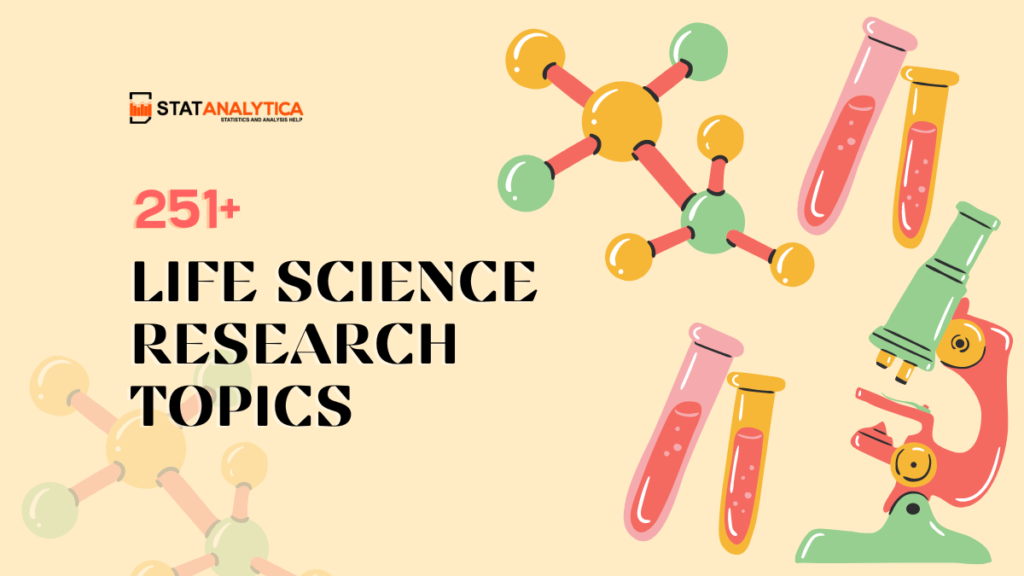
Life science research is like peering into the intricate workings of the universe, but instead of stars and galaxies, it delves into the mysteries of life itself. From unraveling the secrets of our genetic code to understanding ecosystems and everything in between, life science research encompasses a vast array of fascinating topics. In this blog post, we’ll embark on a journey through some of the most captivating life science research topics within the realm of life science research.
What is research in life science?
Table of Contents
Research in life science involves the systematic investigation and study of living organisms, their interactions, and their environments. It encompasses a wide range of disciplines, including biology, genetics, ecology, microbiology, neuroscience, and more.
Life science research aims to expand our understanding of the fundamental principles governing life processes, uncover new insights into biological systems, develop innovative technologies and therapies, and address pressing challenges in areas such as healthcare, agriculture, and conservation.
251+ Life Science Research Topics: Category Wise
Genetics and genomics.
- Genetic basis of inherited diseases
- Genome-wide association studies
- Epigenetics and gene regulation
- Evolutionary genomics
- CRISPR/Cas9 gene editing technology
- Pharmacogenomics and personalized medicine
- Population genetics
- Functional genomics
- Comparative genomics across species
- Genetic diversity and conservation
Biotechnology and Bioengineering
- Biopharmaceutical production
- Metabolic engineering for biofuel production
- Synthetic biology applications
- Bioremediation techniques
- Nanotechnology in drug delivery
- Tissue engineering and regenerative medicine
- Biosensors for environmental monitoring
- Bioprocessing optimization
- Biodegradable plastics and sustainable materials
- Agricultural biotechnology for crop improvement
Ecology and Environmental Biology
- Biodiversity hotspots and conservation strategies
- Ecosystem services and human well-being
- Climate change impacts on ecosystems
- Restoration ecology techniques
- Urban ecology and biodiversity
- Marine biology and coral reef conservation
- Habitat fragmentation and species extinction
- Ecological modeling and forecasting
- Wildlife conservation genetics
- Microbial ecology in natural environments
Neuroscience and Cognitive Science
- Brain mapping techniques (fMRI, EEG, etc.)
- Neuroplasticity and learning
- Neural circuitry underlying behavior
- Neurodegenerative diseases (Alzheimer’s, Parkinson’s, etc.)
- Neural engineering for prosthetics
- Consciousness and the mind-body problem
- Psychiatric genetics and mental health disorders
- Neuroimaging in psychiatric research
- Developmental cognitive neuroscience
- Neural correlates of consciousness
Evolutionary Biology
- Mechanisms of speciation
- Molecular evolution and phylogenetics
- Coevolutionary dynamics
- Evolution of antibiotic resistance
- Cultural evolution and human behavior
- Evolutionary consequences of climate change
- Evolutionary game theory
- Evolutionary medicine and infectious diseases
- Evolutionary psychology and human cognition
- Paleogenomics and ancient DNA analysis
Cell Biology and Physiology
- Cell cycle regulation and cancer biology
- Stem cell biology and regenerative medicine
- Organelle dynamics and intracellular transport
- Cellular senescence and aging
- Ion channels and neuronal excitability
- Metabolic pathways and cellular energetics
- Cell signaling pathways in development and disease
- Autophagy and cellular homeostasis
- Mitochondrial function and disease
- Cell adhesion and migration in development and cancer
Microbiology and Immunology
- Microbiome composition and function
- Antibiotic resistance mechanisms
- Host-microbe interactions in health and disease
- Viral pathogenesis and vaccine development
- Microbial biotechnology for waste treatment
- Immunotherapy approaches for cancer treatment
- Microbial diversity in extreme environments
- Antimicrobial peptides and drug discovery
- Microbial biofilms and chronic infections
- Host immune responses to viral infections
Biomedical Research and Clinical Trials
- Translational research in oncology
- Precision medicine approaches
- Clinical trials for gene therapies
- Biomarker discovery for disease diagnosis
- Stem cell-based therapies for regenerative medicine
- Pharmacokinetics and drug metabolism studies
- Clinical trials for neurodegenerative diseases
- Vaccine efficacy trials
- Patient-reported outcomes in clinical research
- Health disparities and clinical trial participation
Emerging Technologies and Innovations
- Single-cell omics technologies
- 3D bioprinting for tissue engineering
- CRISPR-based diagnostics
- Artificial intelligence applications in life sciences
- Organs-on-chip for drug screening
- Wearable biosensors for health monitoring
- Nanomedicine for targeted drug delivery
- Optogenetics for neuronal manipulation
- Quantum biology and biological systems
- Augmented reality in medical education
Ethical, Legal, and Social Implications (ELSI) in Life Sciences
- Privacy concerns in genomic research
- Ethical considerations in gene editing technologies
- Access to healthcare and genetic testing
- Intellectual property rights in biotechnology
- Informed consent in clinical trials
- Animal welfare in research
- Equity in environmental decision-making
- Data sharing and reproducibility in science
- Dual-use research and biosecurity
- Cultural perspectives on biomedicine and genetics
Public Health and Epidemiology
- Disease surveillance and outbreak investigation
- Global health disparities and access to healthcare
- Environmental factors in disease transmission
- Health impacts of climate change
- Social determinants of health
- Infectious disease modeling and forecasting
- Vaccination strategies and herd immunity
- Epidemiology of chronic diseases
- Mental health epidemiology
- Occupational health and safety
Plant Biology and Agriculture
- Crop domestication and evolution
- Plant-microbe interactions in agriculture
- Genetic engineering for crop improvement
- Plant hormone signaling pathways
- Abiotic stress tolerance mechanisms in plants
- Soil microbiology and nutrient cycling
- Agroecology and sustainable farming practices
- Plant secondary metabolites and natural products
- Plant developmental biology
- Plant epigenetics and environmental adaptation
Bioinformatics and Computational Biology
- Genome assembly and annotation algorithms
- Phylogenetic tree reconstruction methods
- Metagenomic data analysis pipelines
- Machine learning approaches for biomarker discovery
- Structural bioinformatics and protein modeling
- Systems biology and network analysis
- Transcriptomic data analysis tools
- Population genetics simulation software
- Evolutionary algorithms in bioinformatics
- Cloud computing in life sciences research
Toxicology and Environmental Health
- Mechanisms of chemical toxicity
- Risk assessment methodologies
- Environmental fate and transport of pollutants
- Endocrine disruptors and reproductive health
- Nanotoxicology and nanomaterial safety
- Biomonitoring of environmental contaminants
- Ecotoxicology and wildlife health
- Air pollution exposure and respiratory health
- Water quality and aquatic ecosystems
- Environmental justice and health disparities
Aquatic Biology and Oceanography
- Marine biodiversity conservation strategies
- Ocean acidification impacts on marine life
- Coral reef resilience and restoration
- Fisheries management and sustainable harvesting
- Deep-sea biodiversity and exploration
- Harmful algal blooms and ecosystem health
- Marine mammal conservation efforts
- Microplastics pollution in aquatic environments
- Ocean circulation and climate regulation
- Aquaculture and mariculture technologies
Social and Behavioral Sciences in Health
- Health behavior change interventions
- Social determinants of health disparities
- Health communication strategies
- Community-based participatory research
- Patient-centered care approaches
- Cultural competence in healthcare delivery
- Health literacy interventions
- Stigma reduction efforts in public health
- Health policy analysis and advocacy
- Digital health technologies for behavior monitoring
Bioethics and Biomedical Ethics
- Ethical considerations in human subjects research
- Research ethics in vulnerable populations
- Privacy and data protection in healthcare
- Professional integrity and scientific misconduct
- Ethical implications of genetic testing
- Access to healthcare and health equity
- End-of-life care and euthanasia debates
- Reproductive ethics and assisted reproduction
- Ethical challenges in emerging biotechnologies
Forensic Science and Criminalistics
- DNA fingerprinting techniques
- Forensic entomology and time of death estimation
- Trace evidence analysis methods
- Digital forensics in criminal investigations
- Ballistics and firearm identification
- Forensic anthropology and human identification
- Bloodstain pattern analysis
- Arson investigation techniques
- Forensic toxicology and drug analysis
- Forensic psychology and criminal profiling
Nutrition and Dietary Science
- Nutritional epidemiology studies
- Diet and chronic disease risk
- Functional foods and nutraceuticals
- Macronutrient metabolism pathways
- Micronutrient deficiencies and supplementation
- Gut microbiota and metabolic health
- Dietary interventions for weight management
- Food safety and risk assessment
- Sustainable diets and environmental impact
- Cultural influences on dietary habits
Entomology and Insect Biology
- Insect behavior and communication
- Insecticide resistance mechanisms
- Pollinator decline and conservation efforts
- Medical entomology and vector-borne diseases
- Invasive species management strategies
- Insect biodiversity in urban environments
- Agricultural pest management techniques
- Insect physiology and biochemistry
- Social insects and eusociality
- Insect symbiosis and microbial interactions
Zoology and Animal Biology
- Animal behavior and cognition
- Conservation genetics of endangered species
- Reproductive biology and breeding programs
- Wildlife forensics and illegal wildlife trade
- Comparative anatomy and evolutionary biology
- Animal welfare and ethics in research
- Physiological adaptations to extreme environments
- Zoological taxonomy and species discovery
- Animal communication and signaling
- Human-wildlife conflict mitigation strategies
Biochemistry and Molecular Biology
- Protein folding and misfolding diseases
- Enzyme kinetics and catalytic mechanisms
- Metabolic regulation in health and disease
- Signal transduction pathways
- DNA repair mechanisms and genome stability
- RNA biology and post-transcriptional regulation
- Lipid metabolism and membrane biophysics
- Molecular interactions in drug design
- Bioenergetics and cellular respiration
- Structural biology and X-ray crystallography
Cancer Biology and Oncology
- Tumor microenvironment and metastasis
- Cancer stem cells and therapy resistance
- Angiogenesis and tumor vasculature
- Immune checkpoint inhibitors in cancer therapy
- Liquid biopsy techniques for cancer detection
- Oncogenic signaling pathways
- Personalized medicine approaches in oncology
- Radiation therapy and tumor targeting strategies
- Cancer genomics and precision oncology
- Cancer prevention and lifestyle interventions
Developmental Biology and Embryology
- Embryonic stem cell differentiation
- Morphogen gradients and tissue patterning
- Developmental genetics and model organisms
- Regenerative potential in vertebrates and invertebrates
- Developmental plasticity and environmental cues
- Embryo implantation and pregnancy disorders
- Germ cell development and fertility preservation
- Cell fate determination in development
- Evolutionary developmental biology (evo-devo)
- Organogenesis and tissue morphogenesis
Pharmacology and Drug Discovery
- Drug-target interactions and pharmacokinetics
- High-throughput screening techniques
- Structure-activity relationship studies
- Drug repurposing strategies
- Natural product drug discovery
- Drug delivery systems and nanomedicine
- Pharmacovigilance and drug safety monitoring
- Pharmacoeconomics and healthcare outcomes
- Drug metabolism and drug-drug interactions
Stem Cell Research
- Induced pluripotent stem cells (iPSCs) technology
- Stem cell therapy applications in regenerative medicine
- Stem cell niche and microenvironment
- Stem cell banking and cryopreservation
- Stem cell-based disease modeling
What Are The 10 Examples of Life Science Research Paper Titles?
- Investigating the Role of Gut Microbiota in Neurological Disorders: Implications for Therapeutic Interventions.
- Genome-Wide Association Study Identifies Novel Genetic Markers for Cardiovascular Disease Risk.
- Understanding the Molecular Mechanisms of Cancer Metastasis: Insights from Cellular Signaling Pathways.
- The Impact of Climate Change on Plant-Pollinator Interactions: Implications for Biodiversity Conservation.
- Exploring the Potential of CRISPR/Cas9 Gene Editing Technology in Treating Genetic Disorders.
- Characterizing the Microbial Diversity of Extreme Environments: Insights from Deep-Sea Hydrothermal Vents.
- Assessment of Novel Drug Delivery Systems for Targeted Cancer Therapy: A Preclinical Study.
- Unraveling the Neurobiology of Addiction: Implications for Treatment Strategies.
- Investigating the Role of Epigenetics in Age-Related Diseases: From Mechanisms to Therapeutic Targets.
- Evaluating the Efficacy of Herbal Remedies in Traditional Medicine: A Systematic Review and Meta-Analysis.
Life science research is a journey of discovery, filled with wonder, excitement, and the occasional setback. Yet, through perseverance and ingenuity, researchers continue to push the boundaries of knowledge, unlocking the secrets of life itself. As we stand on the cusp of a new era of scientific discovery, one thing is clear: the future of life science research is brighter—and more promising—than ever before. I hope these life science research topics will help you to find the best topics for you.
Related Posts

Step by Step Guide on The Best Way to Finance Car

The Best Way on How to Get Fund For Business to Grow it Efficiently

189+ Top-Rated Life Science Research Topics For High School Students
Have you ever wondered about the incredible mysteries hidden within the world of living things? Life Science Research Topics for High School Students opens the door to exploring these amazing wonders! From understanding how our bodies work to exploring the diversity of life on Earth, these topics are like keys to unlock the secrets of biology, ecology, genetics, and much more.
In this fascinating journey, we get to investigate genes and how they affect our traits or even diseases we might inherit. Ever thought about how our environment impacts the way we grow and live? These topics will help us uncover the answers.
Delving into the realms of biology, we’ll explore ecosystems, creatures big and small, and even tiny microorganisms that play huge roles in our world. Ever pondered the science behind climate change or how pollution affects our planet? These research topics will guide us to understand these critical issues.
As budding scientists, we’ll dive into the science of life itself—learning about cells, organs, evolution, and even the fantastic world of biotechnology. So, are you ready to embark on this exciting research and exploration through Life Science Research Topics for High School Students?
You May Also Like To Know: Good Biology Topics to Research
Table of Contents
What Is Life Science Research Topics For High School Students?
Life Science Research Topics for High School Students refers to fascinating subjects that help students explore and study living things. These topics cover a wide range of areas, such as biology, genetics, ecology, and more. They are like doors that open to a world full of exciting discoveries about plants, animals, the human body, and even tiny microorganisms.
By diving into these topics, students get to learn about genes and how they affect our traits, as well as the environment’s role in shaping living organisms. These research topics also delve into how our actions impact the world around us, such as the effects of pollution or climate change.
In simple terms, Life Science Research Topics for High School Students are cool and interesting themes that allow students to learn about life on Earth in different ways. They encourage curiosity, investigation, and understanding about the living world we’re all a part of.
How Can I Choose And Find Good Ideas for Life Science Research Topics For High School Students?
Choosing and finding life science research topics for high school students can be an exciting journey! Here’s a guide to help you select an engaging topic:
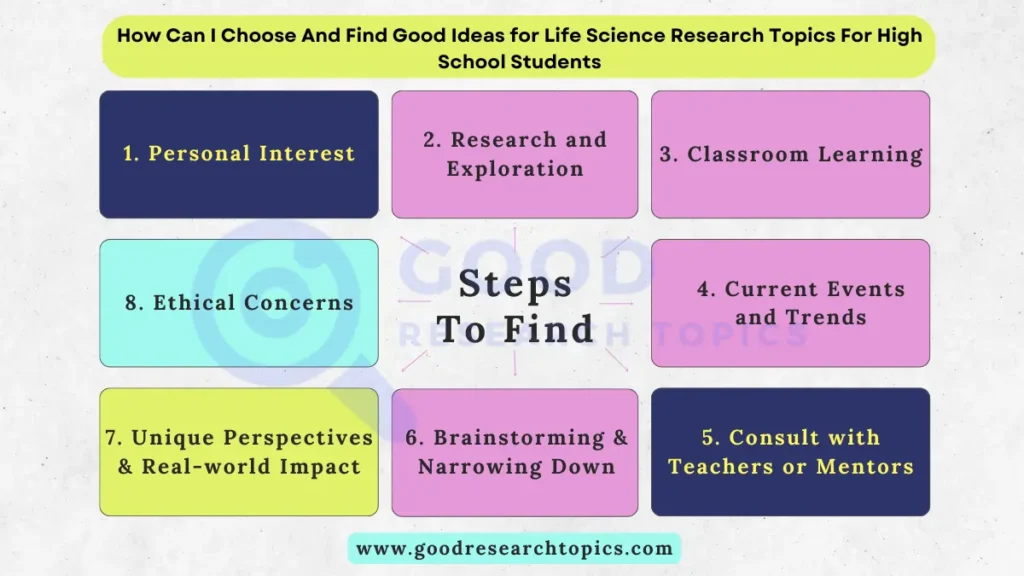
1. Personal Interest:
- Passion matters: Consider topics that genuinely interest you. Are you fascinated by genetics, ecology, human biology, or environmental issues? Start with what excites you.
2. Research and Exploration:
- Read and explore: Look through science magazines, online articles, and reputable websites. Explore recent scientific advancements and issues in biology or related fields.
3. Classroom Learning:
- Connect with lessons: Think about topics covered in your biology or science classes that piqued your curiosity. Topics discussed in class can be great starting points.
4. Current Events and Trends:
- Stay updated: Follow news related to biology, health, or the environment. Current events often spark research ideas.
5. Consult with Teachers or Mentors:
- Seek guidance: Your teachers or mentors can provide valuable advice. Discuss your interests and ask for suggestions or resources.
6. Brainstorming:
- Make a list: Write down ideas that come to mind. Even if they seem small or unusual, jot them down for consideration.
7. Narrowing Down:
- Research feasibility: Consider the availability of resources, time, and equipment. Ensure the topic is manageable for your level of study.
8. Unique Perspectives:
- Think differently: Consider approaching familiar topics from unique angles or explore interdisciplinary connections between biology and other subjects.
9. Real-world Impact:
- Consider relevance: Topics related to solving real-world problems or having practical applications can be highly engaging.
10. Ethical Considerations:
- Think about ethics: Some topics, such as genetic modification or animal testing, might have ethical implications. Consider these aspects when selecting your topic.
Great Examples of Life Science Research Topics
- Impact of climate change on a specific ecosystem
- Investigating the genetics of a hereditary disease
- Effects of different diets on human metabolism
- Role of microorganisms in environmental cleanup
- Study of biodiversity in a local habitat
- Analyzing the effectiveness of natural remedies in disease treatment
Some Examples Of Research Titles About Life, Physical, And Applied Science
Want to know What are some examples of research titles about life, physical, and applied science? Here are examples of research titles encompassing life science, physical science, and applied science:
Life Science Research Titles
- “Impact of Environmental Factors on Plant Growth and Development”
- “Genetic Variations in Disease Susceptibility: A Comparative Study”
- “Microbial Diversity in Different Soil Types and Its Implications”
- “Effects of Various Diets on Metabolic Rate in Drosophila melanogaster”
- “Understanding the Role of Gut Microbiota in Human Health”
Physical Science Research Titles
- “Investigation of Frictional Forces in Different Surfaces”
- “The Effect of Temperature Variations on the Rate of Chemical Reactions”
- “Exploring the Relationship Between Light Intensity and Solar Energy Production”
- “Analysis of Sound Waves and Their Applications in Communication”
- “Examining the Properties of Different Magnetic Materials”
Applied Science Research Titles
- “Design and Evaluation of a Water Filtration System Using Natural Materials”
- “Assessment of the Antibacterial Properties of Herbal Extracts for Wound Healing”
- “Development of a Sustainable Packaging Material from Biodegradable Sources”
- “Testing the Efficiency of Various Insulation Materials for Home Energy Conservation”
- “Design and Construction of a Solar-Powered Mobile Phone Charger”
List of Good Life Science Research Topics For High School Students
Here are 200+ research topics across various life science fields for high school students:
Genetics and Genomics Life Science Research Topics
- Study of hereditary diseases in specific populations
- Ethics of gene editing technologies (CRISPR/Cas9)
- Investigating genetic variations in response to environmental factors
- Role of epigenetics in gene expression and disease development
- Analysis of genetic mutations and their impact on health
Ecology and Environmental Biology Research Topics
- Impact of deforestation on local biodiversity
- Effects of climate change on migratory patterns of birds or animals
- Analysis of invasive species and their impact on ecosystems
- Investigating the correlation between urbanization and loss of biodiversity
- Importance of biodiversity in maintaining ecosystem stability
Physiology Life Science Research Topics For High School Students
- Comparative study of the digestive systems of different animals
- Effects of exercise on the cardiovascular system
- Investigating the impact of diet on metabolism and energy levels
- Neurological disorders: Causes and potential treatments
- Analysis of the respiratory system in relation to environmental factors
Evolutionary Biology Life Science Research Topics
- Comparative anatomy of vertebrates
- Investigating natural selection through a specific case study
- Analyzing fossil records to understand evolutionary changes
- Role of sexual selection in the evolution of specific traits
- Impact of environmental pressures on species adaptation
Microbiology Life Science Research Topics For High School Students
- Study of antibiotic resistance in bacteria
- Investigating the role of gut microbiota in human health
- Microorganisms in extreme environments: Adaptations and implications
- Analysis of viruses and their impact on global health
- Fermentation: Microbial processes and applications
Biotechnology Life Science Research Topics For Students
- Biotechnological applications in agriculture for enhanced crop yield
- Investigating the ethical considerations of cloning technologies
- Role of biotechnology in sustainable energy production
- CRISPR/Cas9: Precision gene editing and its potential applications
- Biopharmaceuticals: Production, benefits, and challenges
Recent Interesting Biochemistry & SIP Research Topics
- Enzyme kinetics and factors affecting enzyme activity
- Investigating the role of antioxidants in cellular health
- Biochemical processes involved in cellular aging
- Study of metabolic disorders and their biochemical basis
- Role of vitamins and minerals in human health and disease prevention
Life Science Research Topics Related To Protenomics and Molecular Biology
- Molecular basis of cancer and potential therapeutic targets
- Investigating gene regulation mechanisms using model organisms
- Study of protein folding and its implications in disease
- Analysis of DNA repair mechanisms and their significance
- Role of non-coding RNA in gene expression regulation
Biophysics Life Science Research Topics For High School Students
- Biomechanics of human movement and sports performance
- Investigating the physics of hearing or vision in organisms
- Biophysical properties of cell membranes and their functions
- Application of physics in medical imaging techniques
Climate Science Research Topics In Life Science
- Impact of climate change on marine ecosystems
- Investigating the role of permafrost in global climate change
- Analysis of climate models and their accuracy in predicting changes
- Renewable energy sources: Efficiency and potential improvements
- Impact of deforestation on regional climate patterns
Fun Life Science Research Topics For High School Students In Environmental Conservation
- Study of sustainable agricultural practices for soil conservation
- Investigating the role of wetlands in water purification
- Impact of plastic pollution on marine life and ecosystems
- Analysis of wildlife conservation strategies in specific regions
- Importance of biodiversity conservation in urban areas
Cool Pollution and Remediation Life Science Research Topics
- Investigating air pollution sources and their health effects
- Water pollution: Causes, effects, and potential solutions
- Analysis of industrial pollution control technologies
- Role of plants in phytoremediation of contaminated environments
- Impact of noise pollution on wildlife and human health
Genetics and Genomics Life Science Research Topics For High School Students
- Investigating genetic disorders in specific ethnic populations
- Gene editing technologies: Ethical considerations and limitations
- Environmental factors and their influence on gene expression
- Epigenetics: Role in inheritance and disease development
- Analysis of genetic mutations and their implications in human health
Ecology and Environmental Biology Life Science Research Topics
- Impact of habitat fragmentation on biodiversity
- Effects of climate change on species extinction rates
- Study of keystone species and their importance in ecosystems
- Investigating the effects of pollution on local wildlife
- Ecological succession: Case studies in different environments
- Comparative study of the respiratory systems in mammals
- Effects of various diets on metabolic rates in humans
- Investigating the neurobiology of learning and memory
- Analysis of hormonal regulation in different life stages
- Cardiovascular diseases: Risk factors and preventive measures
Life Science Research Topics & Title Ideas For Evolutionary Biology
- Comparative embryology across different species
- Investigating convergent evolution in unrelated species
- Study of genetic drift in isolated populations
- Role of symbiosis in evolutionary relationships
- Impact of human activities on rapid evolution in certain species
- Study of the human microbiome and its significance
- Investigating the role of viruses in ecosystem dynamics
- Microbial interactions in soil ecosystems
- Analysis of bioremediation techniques using microorganisms
- Role of microbes in food production and preservation
Lastest Biotechnology Life Science Research Topics
- Applications of biotechnology in disease diagnosis
- Investigating ethical considerations in genetically modified organisms (GMOs)
- Role of biotechnology in renewable energy production
- Bioprospecting: Exploring natural sources for biotechnological applications
- Synthetic biology: Challenges and future prospects
Best Life Science Research Topics For High School Students In Biochemistry
- Study of enzyme kinetics and substrate specificity
- Investigating metabolic pathways in specific diseases
- Biochemical basis of neurodegenerative diseases
- Analysis of protein structure-function relationships
- Role of vitamins and minerals in cellular metabolism
Protenomics and Molecular Biology Research Topics
- Investigating genetic regulation using model organisms
- Role of non-coding RNA in gene expression modulation
- Study of molecular mechanisms underlying cell division
- Analysis of DNA damage and repair mechanisms
- Molecular basis of infectious diseases and host-pathogen interactions
- Biomechanics of animal locomotion and adaptations
- Investigating the physics of sensory perception in organisms
- Application of physics in medical imaging and diagnostics
Cool Life Science Research Topics For High School Students In Climate Science
- Impact of climate change on global food security
- Investigating feedback loops in climate change models
- Analysis of climate data and its implications for future predictions
- Renewable energy technologies: Advancements and limitations
- Urban heat island effect: Causes and potential mitigation strategies
Environmental Conservation Life Science Research topics
- Study of sustainable forestry practices for biodiversity conservation
- Investigating the role of coral reefs in coastal protection
- Impact of human activities on freshwater ecosystems
- Analysis of wildlife conservation strategies in urban environments
- Importance of community involvement in conservation efforts
Pollution and Remediation Life Science Research Topics For High School Students
- Investigating the sources and effects of light pollution
- Water pollution: Case studies and remediation strategies
- Analysis of bioaccumulation and biomagnification of pollutants
- Role of microbial communities in environmental cleanup
- Noise pollution: Effects on wildlife behavior and ecosystems
Genetics and Genomics Research Topics In Life Science
- Investigating epigenetic modifications in cancer development
- Gene editing technologies: Applications in agriculture
- Study of gene-environment interactions in complex diseases
- Role of genetic counseling in managing hereditary disorders
- Analysis of genetic diversity in endangered species
- Impact of climate change on plant-pollinator interactions
- Investigating the effects of habitat fragmentation on migratory species
- Study of ecosystem resilience in the face of environmental disturbances
- Role of conservation genetics in endangered species management
- Analysis of the ecological consequences of invasive species
- Comparative study of endocrine systems in different species
- Effects of sleep deprivation on cognitive functions
- Investigating the physiological adaptations of extremophiles
- Analysis of nutritional requirements in different life stages
- Impact of environmental pollutants on hormonal balance
Hot Evolutionary Biology Life Science Research Topics
- Comparative genomics in understanding evolutionary relationships
- Investigating evolutionary adaptations in extremophiles
- Study of co-evolution between hosts and parasites
- Role of epistasis in shaping evolutionary trajectories
- Impact of human activities on rapid evolution in pathogens
Microbiology Life Science Research Topics For Students
- Study of antibiotic resistance mechanisms in bacteria
- Investigating microbial communities in extreme environments
- Microbial biogeography: Distribution patterns and factors
- Analysis of microbial diversity in soil ecosystems
- Role of microbiota in human immune system development
Life Science Research Topics For High School Students In Biotechnology
- Applications of biotechnology in personalized medicine
- Investigating ethical considerations in gene therapy
- Role of biotechnology in sustainable agriculture
- Bioremediation: Biotechnological approaches for environmental cleanup
- Synthetic biology: Engineering novel biological systems
Biochemistry Life Science Research Topics For High School Students
- Study of enzyme kinetics and allosteric regulation
- Investigating metabolic flux analysis in cellular metabolism
- Biochemical basis of neurodevelopmental disorders
- Analysis of post-translational modifications in proteins
- Role of vitamins and minerals as enzyme cofactors
- Investigating gene expression regulation in development
- Role of non-coding RNAs in epigenetic regulation
- Study of DNA replication and repair mechanisms
- Analysis of molecular mechanisms underlying cell signaling
- Molecular basis of host-pathogen interactions
- Biomechanics of plant movements and growth
- Investigating the physics of cell division and mitosis
- Biophysical properties of biomolecules and their functions
- Application of physics in understanding biological rhythms
Life Science Research Topics For College Students
- Impact of climate change on ocean acidification
- Investigating the role of aerosols in climate dynamics
- Analysis of extreme weather events and their trends
- Renewable energy technologies: Challenges and advancements
- Carbon footprint assessment and reduction strategies
Easy Life Science Research Topics
- Study of ecosystem services and their valuation
- Investigating the impact of deforestation on soil erosion
- Role of restoration ecology in habitat rehabilitation
- Analysis of the effects of overfishing on marine ecosystems
- Importance of green infrastructure in urban conservation
list of Interesting Life Science Research Topics About Agriculture
- Investigating the sources and effects of plastic pollution
- Soil pollution: Case studies and remediation techniques
- Analysis of emerging contaminants in the environment
- Role of bioreactors in treating wastewater
- Impact of electromagnetic pollution on ecosystems
Life Science Research Topics For High School Students Quantitative
- Investigating gene expression regulation in developmental disorders
- Gene editing technologies: Ethical considerations in human applications
Ecology and Science Investigation Research Topics For Plants
List of life science research topics for high school students in philippines, evolutionary biology life science title ideas for students, microbiology life science research topics for college students, highly recommended biotechnology life science topics, biochemistry life science research topics for school students, protenomics and molecular biology, biophysics life science research topics for undergraduate students, life science research paper topics, plant research topics in life science, interesting biology topics for project, list of great life science research topics pdf.
Here are the Life Science Research Topics For Students PDF.
What Are The Good Research Topics For A High Schooler Related To Life Science, Physical Science, Applied Science, Or Material Science That Can Be Done At Home?
Here are the research topics for high schoolers related to life science, physical science, applied science, and material science that can be conducted at home:
Final Words – Life Science Research Topics For High School Students
Life Science Research Topics for High School Students offer an incredible glimpse into the captivating world of living organisms and the environment that surrounds us. Through these explorations, we’ve uncovered fascinating aspects of genetics, ecology, physiology, evolution, microbiology, and biotechnology.
As we conclude this journey, remember that these topics serve as stepping stones for further inquiry and discovery. They have unveiled the complexities of life, inspiring us to delve deeper into understanding the intricacies of our bodies, the diversity of species, and the interconnectedness of all living things.
Each investigation has broadened our horizons, enabling us to comprehend the impact of human actions on the environment and the significance of conservation efforts. These research topics have fueled our curiosity, encouraging us to be proactive stewards of our planet and advocates for scientific progress and sustainability.
As we bid farewell to this exploration, let’s carry forward the spirit of curiosity and inquiry, continuing to unravel the mysteries of life and contributing to the collective knowledge that shapes our understanding of the natural world. Remember, the journey of scientific discovery never truly ends—it evolves, grows, and awaits your continued exploration and contribution.
Related Posts

Top 300+ Qualitative Research Topics For High School Students

100+ Most Interesting Google Scholar Research Topics For Students [Updated 2024]
Leave a comment cancel reply.
Your email address will not be published. Required fields are marked *
Save my name, email, and website in this browser for the next time I comment.
Thank you for visiting nature.com. You are using a browser version with limited support for CSS. To obtain the best experience, we recommend you use a more up to date browser (or turn off compatibility mode in Internet Explorer). In the meantime, to ensure continued support, we are displaying the site without styles and JavaScript.
- View all journals
- Explore content
- About the journal
- Publish with us
- Sign up for alerts
Collection 12 March 2020
Top 50 Life and Biological Sciences Articles
We are pleased to share with you the 50 most read Nature Communications articles* in life and biological sciences published in 2019. Featuring authors from around the world, these papers highlight valuable research from an international community.
Browse all Top 50 subject area collections here .
*Based on data from Google Analytics, covering January-December 2019 (data has been normalised to account for articles published later in the year)

Genome-wide analysis identifies molecular systems and 149 genetic loci associated with income
Household income is used as a marker of socioeconomic position, a trait that is associated with better physical and mental health. Here, Hill et al. report a genome-wide association study for household income in the UK and explore its relationship with intelligence in post-GWAS analyses including Mendelian randomization.
- W. David Hill
- Neil M. Davies
- Ian J. Deary
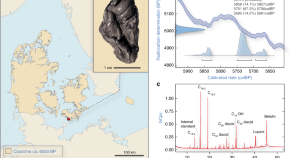
A 5700 year-old human genome and oral microbiome from chewed birch pitch
Birch pitch is thought to have been used in prehistoric times as hafting material or antiseptic and tooth imprints suggest that it was chewed. Here, the authors report a 5,700 year-old piece of chewed birch pitch from Denmark from which they successfully recovered a complete ancient human genome and oral microbiome DNA.
- Theis Z. T. Jensen
- Jonas Niemann
- Hannes Schroeder
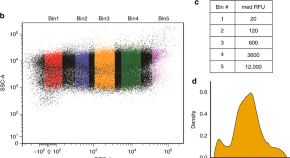
A short translational ramp determines the efficiency of protein synthesis
Several factors contribute to the efficiency of protein expression. Here the authors show that the identity of amino acids encoded by codons at position 3–5 significantly impact translation efficiency and protein expression levels.
- Manasvi Verma
- Junhong Choi
- Sergej Djuranovic
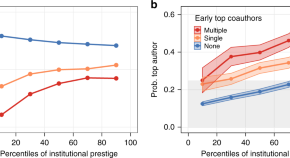
Early coauthorship with top scientists predicts success in academic careers
By examining publication records of scientists from four disciplines, the authors show that coauthoring a paper with a top-cited scientist early in one's career predicts lasting increases in career success, especially for researchers affiliated with less prestigious institutions.
- Tomaso Aste
- Giacomo Livan

Ancient DNA from the skeletons of Roopkund Lake reveals Mediterranean migrants in India
Remains of several hundred humans are scattered around Roopkund Lake, situated over 5,000 meters above sea level in the Himalayan Mountains. Here the authors analyze genome-wide data from 38 skeletons and find 3 clusters with different ancestries and dates, showing the people were desposited in multiple catastrophic events.
- Éadaoin Harney
- Ayushi Nayak
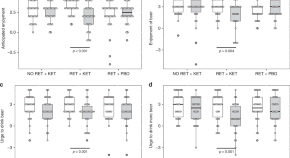
Ketamine can reduce harmful drinking by pharmacologically rewriting drinking memories
Memories linking environmental cues to alcohol reward are involved in the development and maintenance of heavy drinking. Here, the authors show that a single dose of ketamine, given after retrieval of alcohol-reward memories, disrupts the reconsolidation of these memories and reduces drinking in humans.
- Ravi K. Das
- Sunjeev K. Kamboj
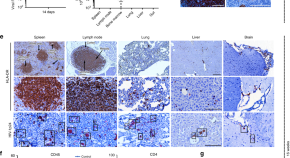
Sequential LASER ART and CRISPR Treatments Eliminate HIV-1 in a Subset of Infected Humanized Mice
Here, the authors show that sequential treatment with long-acting slow-effective release ART and AAV9- based delivery of CRISPR-Cas9 results in undetectable levels of virus and integrated DNA in a subset of humanized HIV-1 infected mice. This proof-of-concept study suggests that HIV-1 elimination is possible.
- Prasanta K. Dash
- Rafal Kaminski
- Howard E. Gendelman
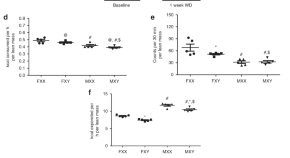
XX sex chromosome complement promotes atherosclerosis in mice
Men and women differ in their risk of developing coronary artery disease, in part due to differences in their levels of sex hormones. Here, AlSiraj et al. show that the XX sex genotype regulates lipid metabolism and promotes atherosclerosis independently of sex hormones in mice.
- Yasir AlSiraj
- Lisa A. Cassis
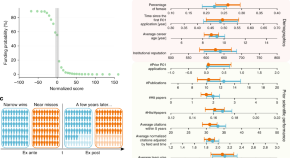
Early-career setback and future career impact
Little is known about the long-term effects of early-career setback. Here, the authors compare junior scientists who were awarded a NIH grant to those with similar track records, who were not, and find that individuals with the early setback systematically performed better in the longer term.
- Benjamin F. Jones
- Dashun Wang
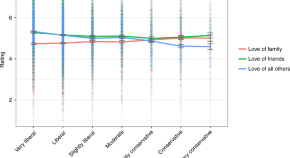
Ideological differences in the expanse of the moral circle
How do liberals and conservatives differ in their expression of compassion and moral concern? The authors show that conservatives tend to express concern toward smaller, more well-defined, and less permeable social circles, while liberals express concern toward larger, less well-defined, and more permeable social circles.
- Jesse Graham
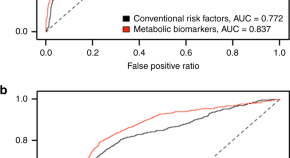
A metabolic profile of all-cause mortality risk identified in an observational study of 44,168 individuals
Biomarkers that predict mortality are of interest for clinical as well as research applications. Here, the authors analyze metabolomics data from 44,168 individuals and identify key metabolites independently associated with all-cause mortality risk.
- Joris Deelen
- Johannes Kettunen
- P. Eline Slagboom
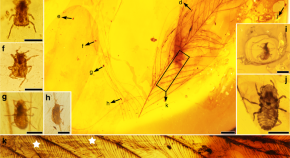
New insects feeding on dinosaur feathers in mid-Cretaceous amber
Numerous feathered dinosaurs and early birds have been discovered from the Jurassic and Cretaceous, but the early evolution of feather-feeding insects is not clear. Here, Gao et al. describe a new family of ectoparasitic insects from 10 specimens found associated with feathers in mid-Cretaceous amber.
- Taiping Gao
- Xiangchu Yin

Acoustic enrichment can enhance fish community development on degraded coral reef habitat
Healthy coral reefs have an acoustic signature known to be attractive to coral and fish larvae during settlement. Here the authors use playback experiments in the field to show that healthy reef sounds can increase recruitment of juvenile fishes to degraded coral reef habitat, suggesting that acoustic playback could be used as a reef management strategy.
- Timothy A. C. Gordon
- Andrew N. Radford
- Stephen D. Simpson
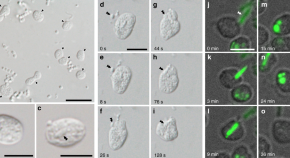
Phagocytosis-like cell engulfment by a planctomycete bacterium
Phagocytosis is a typically eukaryotic feature that could be behind the origin of eukaryotic cells. Here, the authors describe a bacterium that can engulf other bacteria and small eukaryotic cells through a phagocytosis-like mechanism.
- Takashi Shiratori
- Shigekatsu Suzuki
- Ken-ichiro Ishida
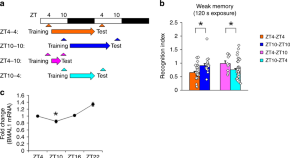
Hippocampal clock regulates memory retrieval via Dopamine and PKA-induced GluA1 phosphorylation
The neural mechanisms that lead to a relative deficit in memory retrieval in the afternoon are unclear. Here, the authors show that the circadian - dependent transcription factor BMAL1 regulates retrieval through dopamine and glutamate receptor phosphorylation.
- Shunsuke Hasegawa
- Hotaka Fukushima
- Satoshi Kida
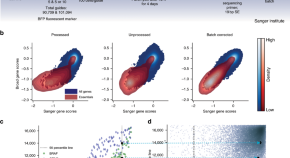
Agreement between two large pan-cancer CRISPR-Cas9 gene dependency data sets
Integrating independent large-scale pharmacogenomic screens can enable unprecedented characterization of genetic vulnerabilities in cancers. Here, the authors show that the two largest independent CRISPR-Cas9 gene-dependency screens are concordant, paving the way for joint analysis of the data sets.
- Joshua M. Dempster
- Clare Pacini
- Francesco Iorio
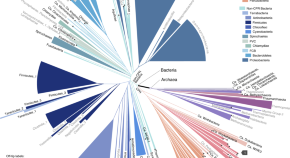
Phylogenomics of 10,575 genomes reveals evolutionary proximity between domains Bacteria and Archaea
The authors build a reference phylogeny of 10,575 evenly-sampled bacterial and archaeal genomes, based on 381 markers. The results indicate a remarkably closer evolutionary proximity between Archaea and Bacteria than previous estimates that used fewer “core” genes, such as the ribosomal proteins.
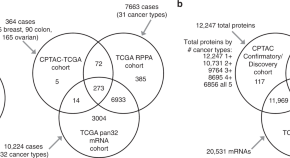
Pan-cancer molecular subtypes revealed by mass-spectrometry-based proteomic characterization of more than 500 human cancers
Mass-spectrometry-based profiling can be used to stratify tumours into molecular subtypes. Here, by classifying over 500 tumours, the authors show that this approach reveals proteomic subgroups which cut across tumour types.
- Fengju Chen
- Darshan S. Chandrashekar
- Chad J. Creighton
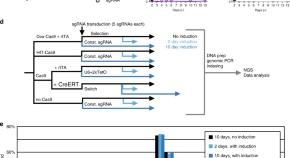
CRISPR-Switch regulates sgRNA activity by Cre recombination for sequential editing of two loci
Inducible genome editing systems often suffer from leakiness or reduced activity. Here the authors develop CRISPR-Switch, a Cre recombinase ON/OFF-controlled sgRNA cassette that allows consecutive editing of two loci.
- Krzysztof Chylinski
- Maria Hubmann
- Ulrich Elling
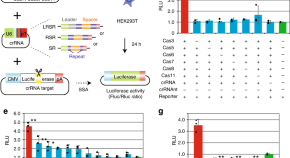
CRISPR-Cas3 induces broad and unidirectional genome editing in human cells
Class 1 CRISPR systems are not as developed for genome editing as Class 2 systems are. Here the authors show that Cas3 can be used to generate functional knockouts and knock-ins, as well as Cas3-mediated exon-skipping in DMD cells.
- Hiroyuki Morisaka
- Kazuto Yoshimi
- Tomoji Mashimo

Genetic evidence for assortative mating on alcohol consumption in the UK Biobank
From observational studies, alcohol consumption behaviours are known to be correlated in spouses. Here, Howe et al. use partners’ genotypic information in a Mendelian randomization framework and show that a SNP in the ADH1B gene associates with partner’s alcohol consumption, suggesting that alcohol consumption affects mate choice.
- Laurence J. Howe
- Daniel J. Lawson
- Gibran Hemani
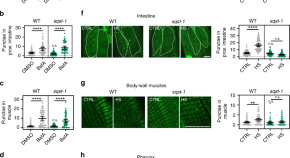
The autophagy receptor p62/SQST-1 promotes proteostasis and longevity in C. elegans by inducing autophagy
While the cellular recycling process autophagy has been linked to aging, the impact of selective autophagy on lifespan remains unclear. Here Kumsta et al. show that the autophagy receptor p62/SQSTM1 is required for hormetic benefits and p62/SQSTM1 overexpression is sufficient to extend C. elegans lifespan and improve proteostasis.
- Caroline Kumsta
- Jessica T. Chang
- Malene Hansen
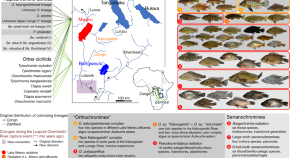
The coincidence of ecological opportunity with hybridization explains rapid adaptive radiation in Lake Mweru cichlid fishes
Recent studies have suggested that hybridization can facilitate adaptive radiations. Here, the authors show that opportunity for hybridization differentiates Lake Mweru, where cichlids radiated, and Lake Bangweulu, where cichlids did not radiate despite ecological opportunity in both lakes.
- Joana I. Meier
- Rike B. Stelkens
- Ole Seehausen
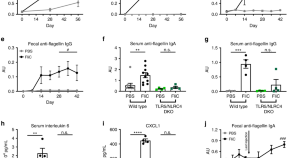
Flagellin-elicited adaptive immunity suppresses flagellated microbiota and vaccinates against chronic inflammatory diseases
Gut microbiota alterations, including enrichment of flagellated bacteria, are associated with metabolic syndrome and chronic inflammatory diseases. Here, Tran et al. show, in mice, that elicitation of mucosal anti-flagellin antibodies protects against experimental colitis and ameliorates diet-induced obesity.
- Hao Q. Tran
- Ruth E. Ley
- Benoit Chassaing
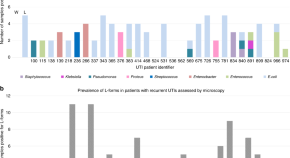
Possible role of L-form switching in recurrent urinary tract infection
The reservoir for recurrent urinary tract infection in humans is unclear. Here, Mickiewicz et al. detect cell-wall deficient (L-form) E. coli in fresh urine from patients, and show that the isolated bacteria readily switch between walled and L-form states.
- Katarzyna M. Mickiewicz
- Yoshikazu Kawai
- Jeff Errington
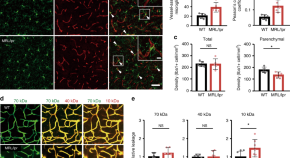
Dual microglia effects on blood brain barrier permeability induced by systemic inflammation
Although it is known that microglia respond to injury and systemic disease in the brain, it is unclear if they modulate blood–brain barrier (BBB) integrity, which is critical for regulating neuroinflammatory responses. Here authors demonstrate that microglia respond to inflammation by migrating towards and accumulating around cerebral vessels, where they initially maintain BBB integrity via expression of the tight-junction protein Claudin-5 before switching, during sustained inflammation, to phagocytically remove astrocytic end-feet resulting in impaired BBB function
- Koichiro Haruwaka
- Ako Ikegami
- Hiroaki Wake
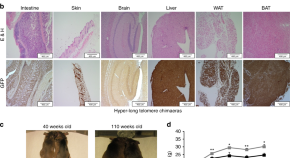
Mice with hyper-long telomeres show less metabolic aging and longer lifespans
Telomere shortening is associated with aging. Here the authors analyze mice with hyperlong telomeres and demonstrate that longer telomeres than normal have beneficial effects such as delayed metabolic aging, increased longevity and less incidence of cancer.
- Miguel A. Muñoz-Lorente
- Alba C. Cano-Martin
- Maria A. Blasco
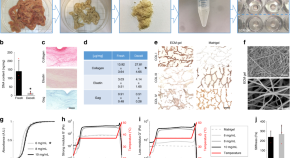
Extracellular matrix hydrogel derived from decellularized tissues enables endodermal organoid culture
Organoid cultures have been developed from multiple tissues, opening new possibilities for regenerative medicine. Here the authors demonstrate the derivation of GMP-compliant hydrogels from decellularized porcine small intestine which support formation and growth of human gastric, liver, pancreatic and small intestinal organoids.
- Giovanni Giuseppe Giobbe
- Claire Crowley
- Paolo De Coppi
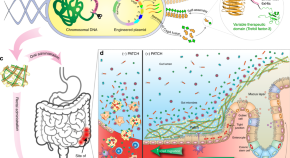
Engineered E. coli Nissle 1917 for the delivery of matrix-tethered therapeutic domains to the gut
Anti-inflammatory treatments for gastrointestinal diseases can often have detrimental side effects. Here the authors engineer E. coli Nissle 1917 to create a fibrous matrix that has a protective effect in DSS-induced colitis mice.
- Pichet Praveschotinunt
- Anna M. Duraj-Thatte
- Neel S. Joshi
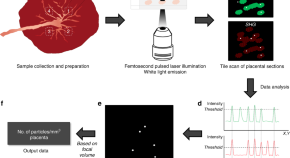
Ambient black carbon particles reach the fetal side of human placenta
Exposure to air pollution during pregnancy has been associated with impaired birth outcomes. Here, Bové et al. report evidence of black carbon particle deposition on the fetal side of human placentae, including at early stages of pregnancy, suggesting air pollution could affect birth outcome through direct effects on the fetus.
- Hannelore Bové
- Eva Bongaerts
- Tim S. Nawrot
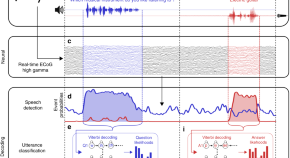
Real-time decoding of question-and-answer speech dialogue using human cortical activity
Speech neuroprosthetic devices should be capable of restoring a patient’s ability to participate in interactive dialogue. Here, the authors demonstrate that the context of a verbal exchange can be used to enhance neural decoder performance in real time.
- David A. Moses
- Matthew K. Leonard
- Edward F. Chang
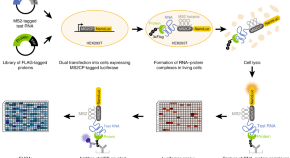
In-cell identification and measurement of RNA-protein interactions
RNA-interacting proteome can be identified by RNA affinity purification followed by mass spectrometry. Here the authors developed a different RNA-centric technology that combines high-throughput immunoprecipitation of RNA binding proteins and luciferase-based detection of their interaction with the RNA.
- Antoine Graindorge
- Inês Pinheiro
- Alena Shkumatava
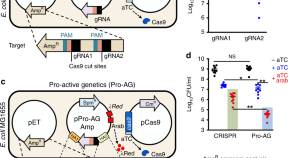
A bacterial gene-drive system efficiently edits and inactivates a high copy number antibiotic resistance locus
Genedrives bias the inheritance of alleles in diploid organisms. Here, the authors develop a gene-drive analogous system for bacteria, selectively editing and clearing plasmids.
- J. Andrés Valderrama
- Surashree S. Kulkarni
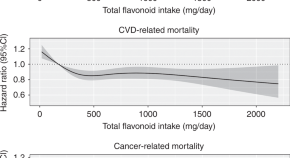
Flavonoid intake is associated with lower mortality in the Danish Diet Cancer and Health Cohort
The studies showing health benefits of flavonoids and their impact on cancer mortality are incomplete. Here, the authors perform a prospective cohort study in Danish participants and demonstrate an inverse association between regular flavonoid intake and both cardiovascular and cancer related mortality.
- Nicola P. Bondonno
- Frederik Dalgaard
- Jonathan M. Hodgson
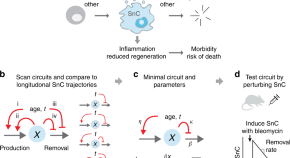
Senescent cell turnover slows with age providing an explanation for the Gompertz law
One of the underlying causes of aging is the accumulation of senescent cells, but their turnover rates and dynamics during ageing are unknown. Here the authors measure and model senescent cell production and removal and explore implications for mortality.
- Amit Agrawal
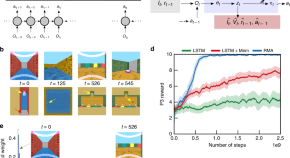
Optimizing agent behavior over long time scales by transporting value
People are able to mentally time travel to distant memories and reflect on the consequences of those past events. Here, the authors show how a mechanism that connects learning from delayed rewards with memory retrieval can enable AI agents to discover links between past events to help decide better courses of action in the future.
- Chia-Chun Hung
- Timothy Lillicrap
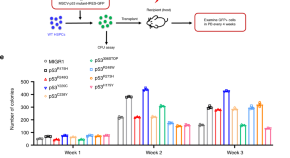
Mutant p53 drives clonal hematopoiesis through modulating epigenetic pathway
Ageing is associated with clonal hematopoiesis of indeterminate potential (CHIP), which is linked to increased risks of hematological malignancies. Here the authors uncover an epigenetic mechanism through which mutant p53 drives clonal hematopoiesis through interaction with EZH2.
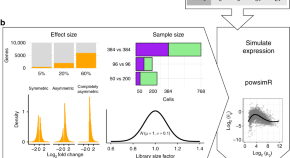
A systematic evaluation of single cell RNA-seq analysis pipelines
There has been a rapid rise in single cell RNA-seq methods and associated pipelines. Here the authors use simulated data to systematically evaluate the performance of 3000 possible pipelines to derive recommendations for data processing and analysis of different types of scRNA-seq experiments.
- Beate Vieth
- Swati Parekh
- Ines Hellmann

Cryo-EM structure and polymorphism of Aβ amyloid fibrils purified from Alzheimer’s brain tissue
Alzheimer’s disease is characterised by the deposition of Aβ amyloid fibrils and tau protein neurofibrillary tangles. Here the authors use cryo-EM to structurally characterise brain derived Aβ amyloid fibrils and find that they are polymorphic and right-hand twisted, which differs from in vitro generated Aβ fibrils.
- Marius Kollmer
- William Close
- Marcus Fändrich
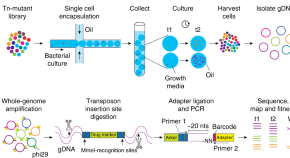
Droplet Tn-Seq combines microfluidics with Tn-Seq for identifying complex single-cell phenotypes
Culturing transposon-mutant libraries in pools can mask complex phenotypes. Here the authors present microfluidics mediated droplet Tn-Seq, which encapsulates individual mutants, promotes isolated growth and enables cell-cell interaction analyses.
- Derek Thibault
- Paul A. Jensen
- Tim van Opijnen
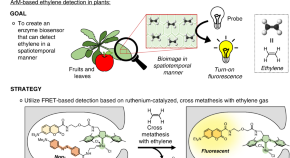
An artificial metalloenzyme biosensor can detect ethylene gas in fruits and Arabidopsis leaves
Existing methods to detect ethylene in plant tissue typically require gas chromatography or use ethylene-dependent gene expression as a proxy. Here Vong et al . show that an artificial metalloenzyme-based ethylene probe can be used to detect ethylene in plants with improved spatiotemporal resolution.
- Kenward Vong
- Katsunori Tanaka
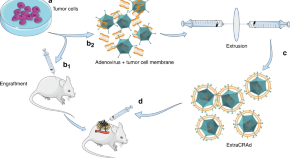
Artificially cloaked viral nanovaccine for cancer immunotherapy
Cancer therapy using oncolytic virus has shown pre-clinical and clinical efficacy. Here, the authors report ExtraCRAd, an oncolytic virus cloaked with tumour cell membrane and report its therapeutic effects in vitro and in vivo in multiple mouse tumour models.
- Manlio Fusciello
- Flavia Fontana
- Vincenzo Cerullo
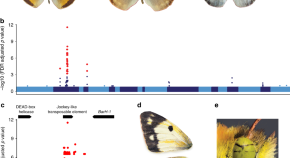
A transposable element insertion is associated with an alternative life history strategy
Tradeoffs are central to life history theory and evolutionary biology, yet almost nothing is known about their mechanistic basis. Here the authors characterize one such mechanism and find a transposable element insertion is associated with the switch between alternative life history strategies.
- Alyssa Woronik
- Kalle Tunström
- Christopher W. Wheat
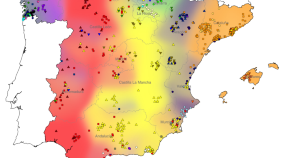
Patterns of genetic differentiation and the footprints of historical migrations in the Iberian Peninsula
The Iberian Peninsula has a complex history. Here, the authors analyse the genetic structure of the modern Iberian population at fine scale, revealing historical population movements associated with the time of Muslim rule.
- Clare Bycroft
- Ceres Fernandez-Rozadilla
- Simon Myers
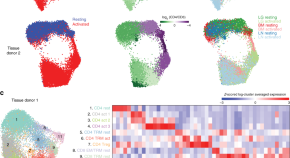
Single-cell transcriptomics of human T cells reveals tissue and activation signatures in health and disease
Immune cells are shaped by the tissue environment, yet the states of healthy human T cells are mainly studied in the blood. Here, the authors perform single cell RNA-seq of T cells from tissues and blood of healthy donors and show its utility as a reference map for comparison of human T cell states in disease.
- Peter A. Szabo
- Hanna Mendes Levitin
- Peter A. Sims

Genomic risk score offers predictive performance comparable to clinical risk factors for ischaemic stroke
Stroke risk is influenced by genetic and lifestyle factors and previously a genomic risk score (GRS) for stroke was proposed, albeit with limited predictive power. Here, Abraham et al. develop a metaGRS that is composed of several stroke-related GRSs and demonstrate improved predictive power compared with individual GRS or classic risk factors.
- Gad Abraham
- Rainer Malik
- Martin Dichgans
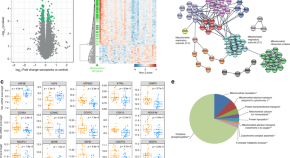
Mitochondrial oxidative capacity and NAD + biosynthesis are reduced in human sarcopenia across ethnicities
Sarcopenia is the loss of muscle mass and strength associated with physical disability during ageing. Here, the authors analyse muscle biopsies from 119 patients with sarcopenia and age-matched controls of different ethnic groups and find transcriptional signatures indicating mitochondrial dysfunction, associated with reduced mitochondria numbers and lower NAD + levels in older individuals with sarcopenia.
- Eugenia Migliavacca
- Stacey K. H. Tay
- Jerome N. Feige
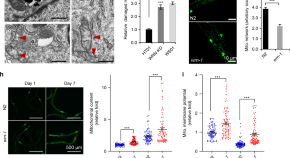
NAD + augmentation restores mitophagy and limits accelerated aging in Werner syndrome
The molecular mechanisms of mitochondrial dysfunction in the premature ageing Werner syndrome were elusive. Here the authors show that NAD + depletion-induced impaired mitophagy contributes to this phenomenon, shedding light on potential therapeutics.
- Evandro F. Fang
- Vilhelm A. Bohr

Novel approach reveals genomic landscapes of single-strand DNA breaks with nucleotide resolution in human cells
Single strand breaks represent the most common form of DNA damage yet no methods to map them in a genome-wide fashion at single nucleotide resolution exist. Here the authors develop such a method and apply to uncover patterns of single-strand DNA “breakome” in different biological conditions.
- Lorena Salazar-García
- Philipp Kapranov

Evaluation of 16S rRNA gene sequencing for species and strain-level microbiome analysis
Here, the authors explore the potential of the 16S gene for discriminating bacterial taxa and show that full-length sequencing combined with appropriate clustering of intragenomic sequence variation can provide accurate representation of bacterial species in microbiome datasets.
- Jethro S. Johnson
- Daniel J. Spakowicz
- George M. Weinstock
Quick links
- Explore articles by subject
- Guide to authors
- Editorial policies
171+ Life Science Research Topics for High School Students
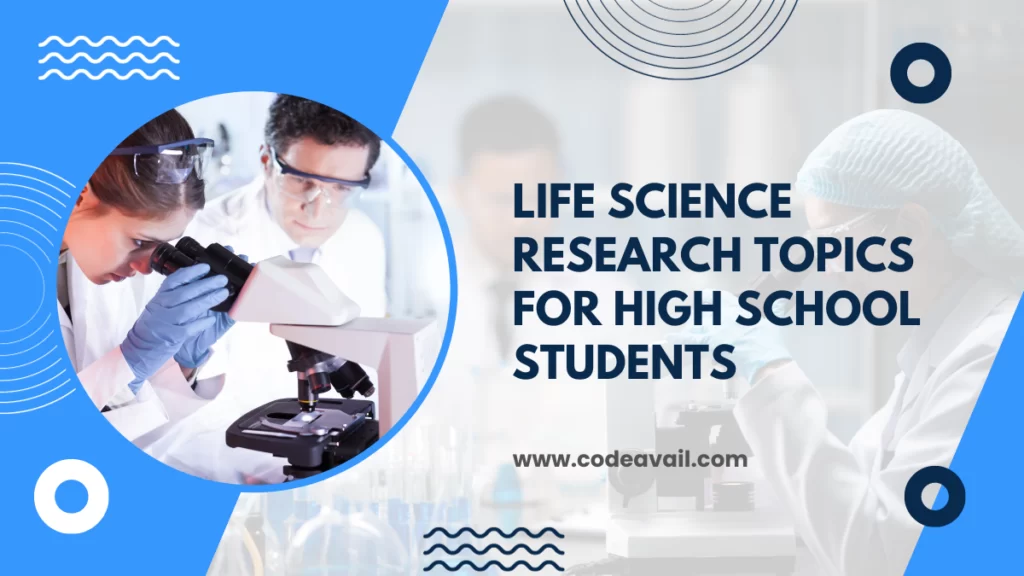
In the world of high school education, life science is a captivating subject that opens doors to the fascinating mysteries of living organisms and the intricate processes that govern them. For high school students, delving into life science research topics can be both intellectually stimulating and immensely rewarding. In this blog, we will embark on a journey through life science research topics for high school students. Whether you’re a student seeking inspiration for your next project or an educator looking to guide your students, this comprehensive guide has you covered.
What is Research in Life Science?
Table of Contents
Research in life science involves the systematic investigation of living organisms, their structures, functions, behaviors, and interactions with the environment. It seeks to answer questions about the biological world and often contributes to our understanding of health, ecology, genetics, and more. Life science research can take many forms, from laboratory experiments to field studies and data analysis.
Why is Life Science Research Important?
Before knowing life science research topics for high school students, you need to know their importance. Advancing Knowledge: Life science research helps us better understand the world around us. It contributes to our knowledge of biology, ecology, genetics, and other crucial fields.
- Improving Health: Research in life science leads to medical breakthroughs, the development of new treatments, and a deeper understanding of diseases.
- Conservation: It aids in the preservation of endangered species and the protection of ecosystems by studying biodiversity and ecological relationships.
- Innovation: Life science research drives innovation in various industries, from pharmaceuticals to agriculture.
- Education: Engaging in research enhances critical thinking and problem-solving skills, preparing students for future academic and professional pursuits.
How do I Choose a Life Science Research Topics for High School Students?
Selecting a research topic can be challenging, but here are some steps to help high school students choose a life science research topic that suits their interests and abilities:
Identify Your Interests
Start by thinking about what aspects of life science fascinate you the most. Are you interested in animals, plants, genetics, or ecology? Narrow down your interests.
Research Current Topics
Look for recent developments and trends in life science. Reading articles, books, and scientific journals can provide insights into emerging areas of research.
Consider Available Resources
Think about the resources available to you. Do you have access to a laboratory, equipment, or mentors who can guide you?
Define Your Research Question
Formulate a specific research question that you want to answer. It should be clear, concise, and achievable with your resources.
Brainstorm Ideas
Brainstorm a list of potential research topics based on your interests and research question. Don’t worry about the number at this stage; you can always narrow it down later.
Evaluate Feasibility
Assess the feasibility of each topic. Can you realistically conduct experiments or gather data on this subject? Consider the time and resources required.
Seek Guidance
Consult with teachers, mentors, or experts in the field for advice and feedback on your research topic ideas.
Choose Your Topic
After careful consideration, select the topic that aligns with your interests, resources, and research question.
Interesting Life Science Research Topics for High School Students
Let’s explore some life science research topics for high school students in different fields:
Genetics and Genomics
Discover genetics and genomics research topics for students:
1. The role of genetics in determining human intelligence.
2. Investigating the genetic basis of inherited diseases.
3. CRISPR-Cas9 gene editing: Applications and ethical considerations.
4. Genetic diversity in endangered species.
5. The impact of epigenetics on gene expression.
6. Genetic factors influencing susceptibility to COVID-19.
7. Studying genetic mutations in cancer development.
8. The genetics of taste perception: Why do people have different taste preferences?
9. Genetic engineering of crops for improved yield and resistance.
10. The potential of gene therapy in treating genetic disorders.
11. The genetics of longevity: Factors influencing human lifespan.
12. The use of DNA fingerprinting in forensic science.
13. Investigating the genetic basis of autism spectrum disorders.
14. Genetic variation in human populations: A global perspective.
15. The ethics of cloning and its implications for biodiversity.
Ecology and Environmental Science
Here are some life science research topics for high school students in ecology and environmental science:
1. Impact of climate change on migratory patterns of birds.
2. The role of keystone species in ecosystem stability.
3. Studying the effects of deforestation on local biodiversity.
4. Assessing the ecological impact of invasive species.
5. The importance of wetlands in water purification.
6. Investigating the relationship between urbanization and wildlife habitat loss.
7. The effects of pollution on aquatic ecosystems.
8. Restoring coral reefs: Strategies for conservation.
9. Analyzing the impact of agriculture on soil health.
10. Biodiversity hotspots: Conservation priorities around the world.
11. The role of microorganisms in nutrient cycling in soil.
12. The effects of ocean acidification on marine life.
13. The ecological significance of pollinators.
14. Investigating the behavior of apex predators in marine ecosystems.
15. The impact of wildfires on forest ecosystems.
Microbiology and Immunology
Let’s explore some research topics in microbiology and immunology:
1. Antibiotic resistance: Mechanisms and implications.
2. Investigating the role of gut microbiota in human health.
3. The use of probiotics in promoting digestive health.
4. Immune response to viral infections: A case study of COVID-19.
5. Microbial bioremediation: Cleaning up oil spills.
6. The role of vaccines in preventing infectious diseases.
7. Studying the diversity of microorganisms in extreme environments.
8. The microbiology of food spoilage.
9. Investigating the hygiene of common public surfaces.
10. The potential of phage therapy in treating bacterial infections.
11. Microorganisms in fermentation: From bread to beer.
12. The evolution of antibiotic-producing bacteria.
13. Studying the microbiome of aquatic ecosystems.
14. The use of CRISPR technology in modifying microbial genomes.
15. Microbial contamination of drinking water sources.
Botany and Plant Science
Here are some life science research topics for high school students in botany and plant science:
1. Investigating the effects of different types of light on plant growth.
2. The role of mycorrhizal fungi in plant nutrition.
3. Plant adaptations to arid environments: Succulents and xerophytes.
4. The impact of soil pH on plant health.
5. Studying the allelopathic effects of invasive plant species.
6. The use of plant extracts in traditional medicine.
7. Investigating the genetics of flower color in plants.
8. Plant responses to climate change: Phenology and flowering times.
9. The role of plants in phytoremediation of polluted soils.
10. Analyzing the anatomy of different types of leaves.
11. Plant propagation: Methods and techniques.
12. The benefits of urban gardening for biodiversity and food security.
13. The role of plants in carbon sequestration.
14. Investigating the effects of microplastics on plant growth.
15. Plant-microbe interactions: Symbiosis and disease.
Zoology and Animal Behavior
Discover zoology and animal behavior research topics for students:
1. Investigating the mating behavior of a specific bird species.
2. The impact of noise pollution on urban wildlife.
3. Animal intelligence: Problem-solving in non-human species.
4. The behavior of social insects: Ants, bees, and termites
5. The effects of climate change on animal migration patterns.
6. Studying the biodiversity of freshwater ecosystems.
7. Investigating the dietary preferences of a specific predator.
8. Animal camouflage: Adaptations and survival strategies.
9. The role of play behavior in animal development.
10. Animal communication: Vocalizations and body language.
11. The impact of human activities on marine mammal populations.
12. Studying the nesting behavior of sea turtles.
13. Investigating the foraging behavior of a nocturnal predator.
14. Animal cognition: Memory and problem-solving in primates.
15. The role of scent marking in animal territoriality.
Anatomy and Physiology
Let’s explore some life science research topics for high school students in microbiology and immunology:
1. The effects of exercise on human cardiovascular health.
2. Investigating the biomechanics of animal locomotion.
3. The anatomy of the human brain: Structure and function.
4. Studying the respiratory system of a specific animal species.
5. The effects of different diets on human metabolism.
6. Muscle fatigue: Causes and recovery strategies.
7. Investigating the circulatory system of fish species.
8. The impact of sleep on human cognitive function.
9. Human senses: Vision, hearing, taste, and smell.
10. Studying the digestive system of herbivorous mammals.
11. The effects of temperature on enzyme activity.
12. Investigating the anatomy of a specific organ or tissue.
13. The role of hormones in regulating physiological processes.
14. The effects of aging on human musculoskeletal health.
15. Studying the nervous system of invertebrate animals.
Evolutionary Biology
Here are some evolutionary biology research topics for high school students:
1. Investigating the evolution of flight in birds.
2. Human evolution: Fossils and ancestral species.
3. The role of sexual selection in the evolution of elaborate traits.
4. Studying the co-evolution of parasites and their hosts.
5. The impact of environmental changes on species adaptations.
6. Investigating convergent evolution in different species.
7. Evolutionary history of a specific plant genus.
8. The role of genetic drift in small populations.
9. Studying the evolution of venomous animals.
10. The effects of island biogeography on species diversity.
11. Investigating the evolution of antibiotic resistance in bacteria.
12. The evolutionary origins of social behavior in animals.
13. Human genetic diversity: A global perspective.
14. Studying the evolution of coloration in reptiles.
15. The role of speciation in biodiversity.
Biotechnology and Bioengineering
Discover some life science research topics for high school students in biotechnology and bioengineering:
1. Investigating the use of bioluminescence in medical imaging.
2. The potential of 3D printing in tissue engineering.
3. Synthetic biology: Designing new organisms for specific tasks.
4. Studying the production of biofuels from algae.
5. The use of nanotechnology in drug delivery.
6. Investigating the development of artificial organs.
7. CRISPR technology and its applications in biotechnology.
8. The role of stem cells in regenerative medicine.
9. Studying the use of gene editing in agriculture.
10. Bioprospecting: Discovering new compounds from natural sources.
11. The potential of biodegradable plastics in reducing pollution.
12. Investigating the use of bioluminescent plants for sustainable lighting.
13. The production of enzymes by extremophiles for industrial processes.
14. Bioinformatics: Analyzing genetic data using computer algorithms.
15. Studying the use of biotechnology in forensic science.
Neuroscience and Psychology
Let’s explore some neuroscience and psychology research topics for students:
1. Investigating the effects of music on human brain activity.
2. The neurobiology of addiction: Understanding substance abuse.
3. Memory consolidation during sleep: A neuroscientific approach.
4. Studying the neural basis of decision-making in rodents.
5. The effects of meditation on mental health and brain function.
6. Investigating the neural mechanisms of pain perception.
7. Neuroplasticity: How the brain adapts to new experiences.
8. The role of neurotransmitters in mood disorders.
9. Studying the impact of early-life experiences on brain development.
10. The effects of social media on adolescent brain development.
11. Investigating the neurobiology of autism spectrum disorders.
12. The psychology of human-animal interactions.
13. Brain-computer interfaces Applications and ethical considerations.
14. Studying the effects of stress on cognitive function.
15. The role of genetics in personality traits.
Biochemistry and Molecular Biology
Here are some life science research topics for high school students in biochemistry and molecular biology:
1. Investigating enzyme kinetics and substrate specificity.
2. The role of proteins in cellular function and structure.
3. DNA replication: Mechanisms and errors.
4. Studying the metabolism of carbohydrates in organisms.
5. The effects of pH on enzyme activity.
6. Investigating the molecular basis of cancer.
7. Protein folding: Structure and misfolding diseases.
8. The role of lipids in cellular membranes.
9. Studying the regulation of gene expression in bacteria.
10. The biochemistry of photosynthesis in plants.
11. Investigating the molecular mechanisms of drug resistance.
12. The role of RNA in protein synthesis.
13. Cellular respiration: Glycolysis and the Krebs cycle.
14. Studying the molecular genetics of a specific disease.
15. The biochemistry of neurotransmitters and synaptic transmission.
Health and Medicine
Discover some health and medicine research topics for high school students:
1. Investigating the effectiveness of a specific herbal remedy.
2. The impact of lifestyle choices on heart health.
3. The role of nutrition in preventing chronic diseases.
4. Studying the effects of sleep deprivation on cognitive function.
5. Mental health disparities: Causes and solutions.
6. Investigating the prevalence of antibiotic misuse.
7. The effects of air pollution on respiratory health.
8. Studying the relationship between exercise and mental well-being.
9. The role of genetics in personalized medicine.
10. Investigating the psychosocial factors affecting patient compliance.
11. Healthcare access and disparities in underserved communities.
12. The effects of stress on the immune system.
13. Studying the impact of vaccination on public health.
14. The role of telemedicine in healthcare delivery.
15. Investigating the use of artificial intelligence in medical diagnosis.
Paleontology and Fossil Studies
Let’s explore some life science research topics for high school students in paleontology and fossil studies:
1. Fossil discoveries: Insights into ancient ecosystems.
2. The evolution of dinosaurs: Feathers and flight.
3. Investigating the fossil record of early humans.
4. Ancient marine life: Trilobites and ammonites.
5. The role of mass extinctions in shaping Earth’s history.
6. Studying the evolution of plant life through the fossil record.
7. Fossilized insects: Insights into prehistoric ecosystems.
8. The impact of asteroid impacts on Earth’s biodiversity.
9. Investigating the co-evolution of plants and pollinators.
10. The fossilization process: From organic to inorganic.
Life science research is a dynamic and vital field that offers numerous opportunities for high school students to explore and contribute to our understanding of the natural world. By choosing a research topic that aligns with their interests and resources, students can embark on a rewarding scientific journey. Whether it’s genetics, ecology, microbiology , or any other area of life science, there is a wealth of topics to explore and discover.
Remember that the process of conducting research is as valuable as the results themselves. It fosters critical thinking, problem-solving skills, and a deeper appreciation for the complexities of life on Earth. So, don’t hesitate to dive into the world of life science research topics for high school students!
Related Posts
8 easiest programming language to learn for beginners.
There are so many programming languages you can learn. But if you’re looking to start with something easier. We bring to you a list of…
10 Online Tutoring Help Benefits
Do you need a computer science assignment help? Get the best quality assignment help from computer science tutors at affordable prices. They always presented to help…
When you choose to publish with PLOS, your research makes an impact. Make your work accessible to all, without restrictions, and accelerate scientific discovery with options like preprints and published peer review that make your work more Open.
- PLOS Biology
- PLOS Climate
- PLOS Complex Systems
- PLOS Computational Biology
- PLOS Digital Health
- PLOS Genetics
- PLOS Global Public Health
- PLOS Medicine
- PLOS Mental Health
- PLOS Neglected Tropical Diseases
- PLOS Pathogens
- PLOS Sustainability and Transformation
- PLOS Collections
- How to Write a Great Title

Maximize search-ability and engage your readers from the very beginning
Your title is the first thing anyone who reads your article is going to see, and for many it will be where they stop reading. Learn how to write a title that helps readers find your article, draws your audience in and sets the stage for your research!
How your title impacts the success of your article
Researchers are busy and there will always be more articles to read than time to read them. Good titles help readers find your research, and decide whether to keep reading. Search engines use titles to retrieve relevant articles based on users’ keyword searches. Once readers find your article, they’ll use the title as the first filter to decide whether your research is what they’re looking for. A strong and specific title is the first step toward citations, inclusion in meta-analyses, and influencing your field.


What to include in a title
Include the most important information that will signal to your target audience that they should keep reading.
Key information about the study design
Important keywords
What you discovered
Writing tips
Getting the title right can be more difficult than it seems, and researchers refine their writing skills throughout their career. Some journals even help editors to re-write their titles during the publication process!

- Keep it concise and informative What’s appropriate for titles varies greatly across disciplines. Take a look at some articles published in your field, and check the journal guidelines for character limits. Aim for fewer than 12 words, and check for journal specific word limits.
- Write for your audience Consider who your primary audience is: are they specialists in your specific field, are they cross-disciplinary, are they non-specialists?
- Entice the reader Find a way to pique your readers’ interest, give them enough information to keep them reading.
- Incorporate important keywords Consider what about your article will be most interesting to your audience: Most readers come to an article from a search engine, so take some time and include the important ones in your title!
- Write in sentence case In scientific writing, titles are given in sentence case. Capitalize only the first word of the text, proper nouns, and genus names. See our examples below.

Don’t
- Write your title as a question In most cases, you shouldn’t need to frame your title as a question. You have the answers, you know what you found. Writing your title as a question might draw your readers in, but it’s more likely to put them off.
- Sensationalize your research Be honest with yourself about what you truly discovered. A sensationalized or dramatic title might make a few extra people read a bit further into your article, but you don’t want them disappointed when they get to the results.
Examples…
Format: Prevalence of [disease] in [population] in [location]
Example: Prevalence of tuberculosis in homeless women in San Francisco
Format: Risk factors for [condition] among [population] in [location]
Example: Risk factors for preterm births among low-income women in Mexico City
Format (systematic review/meta-analysis): Effectiveness of [treatment] for [disease] in [population] for [outcome] : A systematic review and meta-analysis
Example: Effectiveness of Hepatitis B treatment in HIV-infected adolescents in the prevention of liver disease: A systematic review and meta-analysis
Format (clinical trial): [Intervention] improved [symptoms] of [disease] in [population] : A randomized controlled clinical trial
Example: Using a sleep app lessened insomnia in post-menopausal women in southwest United States: A randomized controlled clinical trial
Format (general molecular studies): Characterization/identification/evaluation of [molecule name] in/from [organism/tissue] (b y [specific biological methods] )
Example: Identification of putative Type-I sex pheromone biosynthesis-related genes expressed in the female pheromone gland of Streltzoviella insularis
Format (general molecular studies): [specific methods/analysis] of organism/tissue reveal insights into [function/role] of [molecule name] in [biological process]
Example: Transcriptome landscape of Rafflesia cantleyi floral buds reveals insights into the roles of transcription factors and phytohormones in flower development
Format (software/method papers): [tool/method/software] for [what purpose] in [what research area]
Example: CRISPR-based tools for targeted transcriptional and epigenetic regulation in plants
Tip: How to edit your work
Editing is challenging, especially if you are acting as both a writer and an editor. Read our guidelines for advice on how to refine your work, including useful tips for setting your intentions, re-review, and consultation with colleagues.
- How to Write an Abstract
- How to Write Your Methods
- How to Report Statistics
- How to Write Discussions and Conclusions
- How to Edit Your Work
The contents of the Peer Review Center are also available as a live, interactive training session, complete with slides, talking points, and activities. …
The contents of the Writing Center are also available as a live, interactive training session, complete with slides, talking points, and activities. …
There’s a lot to consider when deciding where to submit your work. Learn how to choose a journal that will help your study reach its audience, while reflecting your values as a researcher…
150+ Life Science Research Topics for High School Students: From Cells to Ecosystems
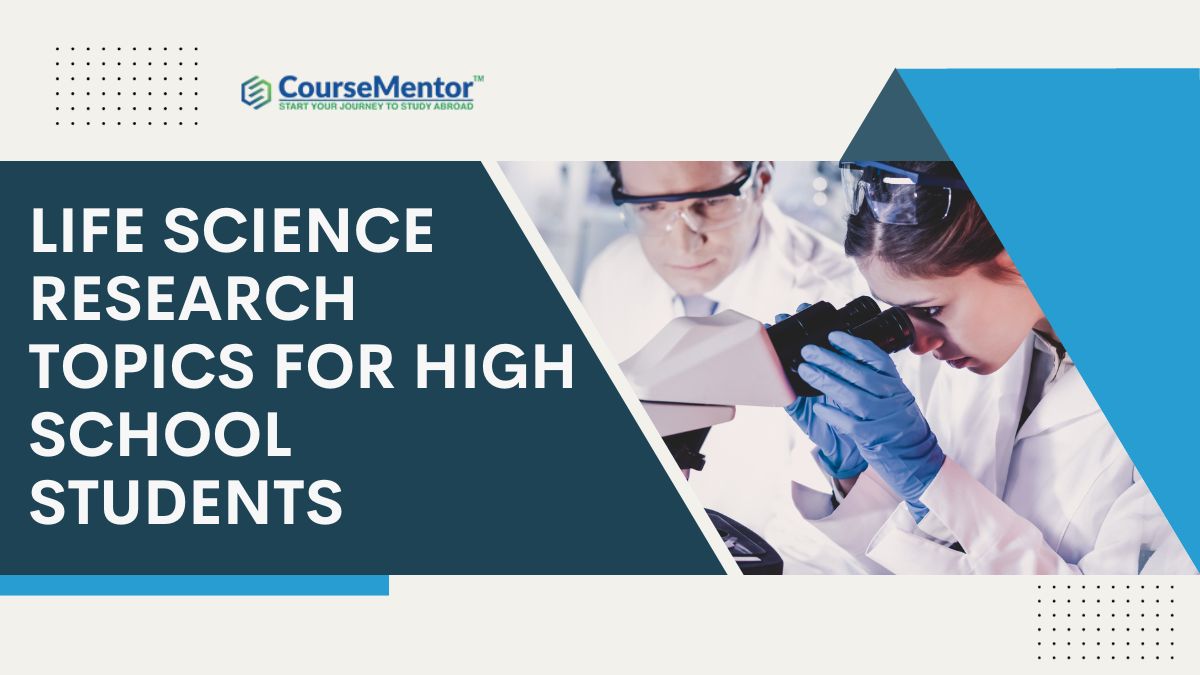
- Post author By admin
- September 26, 2023
Explore a wide range of life science research topics for high school students. Enhance your knowledge and skills with our comprehensive guide.
Ever wondered what makes our world tick? The answer lies in the magic of life science, and guess what? You’re about to dive headfirst into this enchanting world.
No need for complicated jargon or boring textbooks. We’re talking about cool stuff like animals, plants, genes, and mysteries waiting to be unraveled. Imagine being a real-life detective of the natural world!
So, what’s the deal? In this article, we’ve got a bunch of mind-blowing life science research topics designed just for you. They’re not like your usual school assignments. They’re more like a journey into the unknown, a chance to discover things no one else has.
Ready to have a blast and become a science superstar? Awesome, because we’re about to kickstart this amazing adventure together. Let’s roll!
Table of Contents
Why Choose Life Science Research?
You might be wondering why on Earth you should consider diving into the world of life science research, right? Well, let’s unravel the mystery.
It’s Relevant
Life science research is all about the stuff that affects us every day. We’re talking about diseases, ecosystems, genetics – things you encounter in your life.
Problem-Solving Playground
Think of it as a puzzle-solving adventure. Life science research hones your critical thinking skills and turns you into a real-life Sherlock Holmes for all things natural.
Unleash Your Inner Scientist
Ever wanted to be a scientist in a lab coat, conducting experiments and making groundbreaking discoveries? Life science research gives you a taste of that action, letting you form hypotheses and conduct cool experiments.
Career Exploration
Not sure what you want to be when you grow up? Exploring life sciences might help you discover your passion. Whether it’s medicine, ecology, genetics, or something else entirely, the possibilities are endless.
You Can Make a Difference
Believe it or not, your research could contribute to the big book of scientific knowledge. Your discoveries might even change the world!
So, why choose life science research? Because it’s like a thrilling adventure where you’re both the explorer and the discoverer. It’s where your questions lead to answers, and your curiosity shapes the future. Ready to take that first step? Let’s go!
Getting Started: Research Methodology
Getting started with life science research is like gearing up for a fantastic adventure. We’re talking about your very own treasure map, and it’s not as complicated as it might seem. Here’s your basic toolkit to kickstart your research journey:
1. The Scientific Method – Your Detective Kit
Think of this as your secret code for solving mysteries. You start with a question, make a guess (that’s your hypothesis), do some experiments, gather clues (data), and finally, you put it all together to uncover the truth. You’re basically a scientific detective!
2. Data Collection – Gathering Clues
Imagine you’re on a scavenger hunt, but instead of hunting for hidden items, you’re collecting information. This info comes from experiments, observations, or surveys – like puzzle pieces waiting to be put together.
3. Analysis – Piecing It Together
Now, it’s time to play detective again. You take those puzzle pieces (data) and use special tools to fit them together. It’s like solving a jigsaw puzzle, but the picture you reveal is a scientific discovery!
4. Drawing Conclusions – Telling Your Story
You’re not just a detective; you’re also a storyteller. After analyzing your clues, you get to share your findings with the world. It’s like revealing the thrilling ending of a mystery novel – except this time, it’s your discovery.
5. Replicability – Sharing the Adventure
In the world of science, it’s all about teamwork. You’ll document your journey so well that others can follow your steps and have the same adventure. It’s like sharing your treasure map with friends so they can find the same hidden gems.
So, think of research methodology as your trusty guide through the jungle of science. It’s your way of making sure your adventure is both exciting and trustworthy. Get ready, young explorers! Your scientific journey is about to take off, and it’s going to be a blast.
Life Science Research Topics for High School Students
Have a close look at life science research topics for high school students:-
Microbiology and Disease
- Investigating the Antibacterial Properties of Natural Substances.
- Analyzing the Impact of Hand Hygiene on Reducing the Spread of Diseases.
- The Role of Microbes in Decomposition Processes.
- A Comparative Study of Antibiotic Sensitivity in Bacterial Strains.
- Exploring the Microbiome of Different Ecosystems: Soil, Water, and Air.
- Investigating the Effects of Temperature on Microbial Growth.
- The Emergence and Spread of Antibiotic Resistance Genes.
- Microbes in Food: Fermentation and Preservation.
- Analyzing the Microbiome of Human Skin and Its Role in Health.
- Studying the Microbial Diversity in Extreme Environments: Hot Springs and Deep-Sea Vents.
Genetics and Heredity
- Mapping the Inheritance of Genetic Traits in Families.
- Investigating the Genetics of Taste Perception: Bitter Taste Receptors.
- A Study on the Genetic Basis of Rare Genetic Disorders.
- Genetic Variation in Plant Populations: A Local Species Study.
- The Impact of Genetic Mutations on Disease Susceptibility.
- Exploring the Use of CRISPR-Cas9 for Gene Editing in Model Organisms.
- The Genetics of Flower Color Variation in a Plant Species.
- A Comparative Study of Gene Expression in Different Tissues.
- Studying the Inheritance Patterns of Blood Types in Human Populations.
- Investigating the Genetics of Cancer Predisposition in Families.
Ecology and Environmental Studies
- Monitoring the Impact of Pollution on Local Water Bodies.
- Biodiversity Assessment in Urban Parks and Natural Reserves.
- Studying the Effects of Climate Change on Local Flora and Fauna.
- Soil Health Assessment in Agricultural and Natural Ecosystems.
- Investigating the Impact of Invasive Species on Native Biodiversity.
- Analyzing the Role of Wetlands in Flood Control and Water Purification.
- Ecosystem Services Assessment in Urban Environments.
- Urban Heat Island Effect: Mapping and Mitigation Strategies.
- The Impact of Deforestation on Local Bird Populations.
- Restoration of Native Plant Communities in Degraded Ecosystems.
Human Anatomy and Physiology
- The Effect of Different Diets on Gut Microbiota Composition.
- Investigating the Relationship Between Physical Activity and Heart Health.
- Brain Plasticity: How Learning and Experience Change the Brain.
- A Study on the Impact of Sleep Patterns on Cognitive Function.
- The Influence of Age on Muscle Strength and Endurance.
- Hormonal Changes During Puberty: A Comparative Study.
- The Role of Antioxidants in Cellular Aging.
- Investigating the Effects of Stress on Immune System Function.
- Analyzing the Physiology of Human Senses: Vision, Hearing, Taste, and Smell.
- The Role of Gut-Brain Communication in Mood and Mental Health.
Botany and Plant Science
- The Effect of Different Light Conditions on Plant Growth.
- Investigating the Role of Plant Hormones in Growth and Development.
- Studying the Impact of Soil pH on Plant Nutrient Uptake.
- The Relationship Between Mycorrhizal Fungi and Plant Health.
- Analyzing the Adaptations of Desert Plants to Water Scarcity.
- The Influence of Plant Root Exudates on Soil Microbes.
- Investigating the Role of Plant Volatile Compounds in Insect Attraction and Repulsion.
- The Effect of Different Fertilizers on Crop Yield and Soil Health.
- Plant-Microbe Interactions: Beneficial and Pathogenic Relationships.
- Exploring the Nutritional Content of Edible Wild Plants in a Local Area.
Zoology and Animal Behavior
- Investigating Social Hierarchies in Animal Groups: A Study on Dominance.
- The Effect of Environmental Enrichment on Zoo Animal Behavior.
- Studying the Impact of Noise Pollution on Bird Song Patterns.
- Migration Patterns of Local Bird Species: Tracking and Analysis.
- The Influence of Predation Risk on Prey Behavior.
- Investigating Animal Camouflage Strategies in Different Habitats.
- A Comparative Study of Parental Care in Amphibians and Reptiles.
- The Impact of Human Disturbance on Wildlife Behavior in Urban Parks.
- Analyzing the Feeding Behavior of Insectivorous Bats.
- Predator-Prey Coevolution: A Study on Adaptations in Predator and Prey Species.
Environmental Conservation
- Sustainable Agriculture Practices: Soil Health and Crop Yield.
- Ecological Restoration of a Local Wetland Ecosystem.
- Investigating Plastic Recycling Methods for Environmental Impact.
- The Role of Urban Green Spaces in Mitigating Heat Islands.
- Promoting Renewable Energy Sources in a Community: Challenges and Solutions.
- Analyzing the Impact of Conservation Policies on Endangered Species.
- Assessing the Effectiveness of Wildlife Corridors in Reducing Habitat Fragmentation.
- E-Waste Management: Recycling and Environmental Consequences.
- Sustainable Fisheries Management and the Preservation of Marine Ecosystems.
- Promoting Green Roof Adoption in Urban Areas: Benefits and Barriers.
Biotechnology and Genetic Engineering
- CRISPR-Cas9 Gene Editing: Applications in Disease Treatment.
- Investigating the Use of GMOs in Increasing Crop Resilience.
- Cloning as a Tool for Preserving Endangered Species.
- Gene Therapy: Advances and Ethical Considerations.
- Bioremediation Strategies: Cleaning Up Contaminated Sites.
- Analyzing the Potential of Genetically Modified Microbes for Environmental Cleanup.
- Investigating the Use of Biotechnology in Medicine: Vaccines and Therapeutics.
- The Impact of Genetic Engineering on the Pharmaceutical Industry.
- Genome Editing in Microorganisms: Applications in Industry and Medicine.
- Ethical Considerations in Biotechnology: Balancing Progress and Responsibility.
Health and Medicine
- The Effects of Various Diets on Blood Sugar Levels and Diabetes Risk.
- Mental Health Interventions for Adolescents: Efficacy and Accessibility.
- Investigating the Impact of Exercise on Cardiovascular Health in Different Age Groups.
- Analyzing the Microbiome-Gut-Brain Axis and Its Influence on Mental Health.
- The Role of Stress Management Techniques in Improving Overall Health.
- A Comparative Study of Herbal Remedies for Common Ailments.
- The Effects of Different Sleeping Patterns on Cognitive Function.
- Analyzing the Impact of Screen Time on Eye Health in Children.
- The Relationship Between Diet and Skin Health: Acne and Beyond.
- Investigating the Influence of Environmental Factors on Allergies and Asthma.
These research project ideas offer a wide range of opportunities for high school students to explore the fascinating world of life sciences and make meaningful contributions to scientific knowledge.
What are some good research topics for high school students?
Check out some good research topics for high school students:-
Science and Biology
- The Effects of Different Fertilizers on Plant Growth.
- Investigating the Impact of Pollution on Local Water Bodies.
- Analyzing the Efficiency of Various Sunscreens in UV Protection.
- The Role of Microorganisms in Food Spoilage.
- Investigating the Effect of Music on Human Concentration.
- The Influence of Temperature on the Rate of Chemical Reactions.
- A Study on the Behavior of Ants in Response to Different Food Types.
- Investigating the Relationship Between Sleep Patterns and Academic Performance.
- The Effect of Light Exposure on Circadian Rhythms.
- The Impact of Exercise on Heart Rate and Physical Fitness.
Environmental Science
- Analyzing the Impact of Deforestation on Local Climate.
- The Role of Wetlands in Water Purification and Flood Control.
- Investigating the Presence of Microplastics in Local Water Sources.
- Urban Heat Island Effect: Causes and Mitigation Strategies.
- The Effects of Different Soil Types on Plant Growth.
- Renewable Energy Sources: Feasibility and Implementation.
- Analyzing the Environmental Impact of Single-Use Plastics.
- Investigating the Effects of Climate Change on Local Bird Migration Patterns.
- Promoting Recycling and Waste Reduction in Schools.
- Biodiversity Assessment in a Local Ecosystem.
Social Sciences and Psychology
- Investigating the Impact of Bullying on Mental Health.
- Analyzing the Relationship Between Parental Involvement and Academic Success.
- A Study on the Effects of Peer Pressure on Decision-Making.
- The Role of Gender Stereotypes in Career Choices.
- Investigating the Impact of Video Games on Aggressive Behavior.
- The Effect of Music on Mood and Emotions.
- Analyzing the Factors Influencing Voting Behavior in Young Adults.
- The Influence of Advertising on Consumer Choices.
- A Study on the Effects of Stress on Cognitive Performance.
- The Influence of Social Media on Teenagers’ Self-Esteem.
Technology and Engineering
- Investigating the Efficiency of Different Insulation Materials.
- Designing and Testing a Wind-Powered Water Pump.
- Analyzing the Impact of Smartphone Usage on Productivity.
- The Development of a Simple Home Automation System.
- Investigating the Use of Drones in Environmental Monitoring.
- Building a Simple Electric Vehicle Model.
- A Study on Internet Security: Protecting Personal Data.
- Analyzing the Energy Consumption of Household Appliances.
- Designing an Eco-Friendly and Cost-Effective Home.
- Building a Solar-Powered Charger for Mobile Devices.
History and Social Studies
- A Study on the Contributions of a Local Historical Figure.
- Investigating the Causes and Consequences of a Historical Conflict.
- The Role of Women in a Specific Historical Period.
- Analyzing the Impact of Immigration on Local Communities.
- Investigating the Evolution of a Local Cultural Tradition.
- A Comparative Study of Political Systems in Different Countries.
- The Role of Propaganda in Shaping Public Opinion.
- Analyzing the Impact of Social Movements on Policy Change.
- Investigating the History and Cultural Significance of a Local Landmark.
- Analyzing the Impact of Historical Events on Contemporary Society.
These research topics provide a diverse range of opportunities for high school students to explore their interests, develop critical thinking skills, and contribute to their academic and scientific communities.
Students can select topics that align with their passions and curriculum requirements to make their research projects both engaging and meaningful.
What are the possible topics of life science?
Have a close look at the possible topics for life science:-
Microbiology
- Bacterial growth and antibiotic resistance.
- The role of viruses in diseases.
- Microbial diversity in different environments.
- Fermentation processes and their applications.
Genetics and Genomics
- Genetic inheritance patterns in humans and other organisms.
- The impact of genetic mutations on health.
- Genomic sequencing and personalized medicine.
- Gene editing technologies like CRISPR-Cas9.
Ecology and Environmental Science
- Biodiversity and conservation.
- Ecosystem dynamics and food webs.
- Climate change and its effects on ecosystems.
- Environmental pollution and its impact on wildlife.
- Photosynthesis and plant growth.
- Plant adaptations to different environments.
- Plant genetics and breeding for improved crops.
- The role of plants in carbon sequestration.
- Animal migration patterns and navigation.
- Predator-prey interactions in ecosystems.
- Social behavior in animal communities.
- Animal adaptations to extreme environments.
Physiology and Anatomy
- Human organ systems and their functions.
- Cellular processes like respiration and metabolism .
- Comparative anatomy of different species.
- Neurobiology and the workings of the human brain.
Evolutionary Biology
- The theory of evolution by natural selection.
- Fossil evidence of evolution.
- Comparative genomics and evolutionary relationships.
- Human evolution and our closest relatives.
Marine Biology
- Ocean ecosystems and marine biodiversity.
- Coral reef conservation and threats.
- Deep-sea exploration and the discovery of new species.
- The role of marine organisms in biotechnology.
- The immune system’s response to infections.
- Vaccination and herd immunity.
- Autoimmune diseases and allergies.
- Immunotherapy for cancer treatment.
Epidemiology
- Disease outbreaks and epidemiological investigations.
- Public health interventions to control infectious diseases.
- Tracking and modeling the spread of diseases.
- Global health challenges and pandemics.
- Conservation strategies for endangered species.
- Sustainable agriculture and forestry practices.
- Habitat restoration and rebuilding efforts.
- Conservation genetics and preserving genetic diversity.
- CRISPR technology and gene editing.
- Biopharmaceuticals and the production of biofuels.
- Genetically modified organisms (GMOs) in agriculture.
- Bioremediation and environmental cleanup.
These topics within life science provide a rich and diverse array of opportunities for research, study, and exploration.
Whether you’re interested in understanding the natural world, human health, or the environment, life science offers a wide range of fascinating avenues to explore.
What are the interesting research topics about science?
Certainly, science offers a wide range of interesting research topics across various disciplines. Here are some captivating research topics in science:
Artificial Intelligence and Machine Learning
- Developing advanced AI algorithms for medical diagnosis.
- Natural language processing and understanding for chatbots.
- Reinforcement learning in robotics and autonomous systems.
- Ethical considerations in AI development.
Space Exploration and Astronomy
- The search for exoplanets and habitable zones.
- Understanding dark matter and dark energy.
- Space colonization: Challenges and possibilities.
- The future of space telescopes and observatories.
Environmental Science and Climate Change
- Climate modeling and predictions.
- Impacts of climate change on ecosystems and biodiversity.
- Sustainable agriculture and food security in a changing climate.
- Innovative approaches to renewable energy production.
Nanotechnology
- Nanomedicine and its applications in disease treatment.
- Nanomaterials for clean water and pollution control.
- Nanoelectronics and the future of computing.
- Ethical and safety concerns in nanotechnology.
- Personalized medicine and genomics-based treatments.
- The role of epigenetics in health and disease.
- Human genetic diversity and its implications.
Earth and Geosciences
- Natural disaster prediction and mitigation strategies.
- Plate tectonics and the movement of continents.
- The geology of other planets in our solar system.
- Climate history and the study of ice cores.
Biomedical Research
- Stem cell therapy and regenerative medicine.
- Neurobiology and the quest to understand the brain.
- Vaccine development and immunotherapy for cancer.
- Genetic factors in aging and longevity.
Robotics and Automation
- Advances in humanoid and bio-inspired robotics.
- Applications of robotics in healthcare and surgery.
- Autonomous vehicles and their impact on transportation.
- Human-robot interaction and social robots.
Energy and Sustainable Technology
- Energy-efficient building materials and design.
- The potential of fusion energy as a clean power source.
- Battery technology for renewable energy storage.
- Smart grids and the future of energy distribution.
Particle Physics
- The search for the Higgs boson and beyond.
- The nature of dark matter and its properties.
- Particle accelerators and their role in high-energy physics.
- The Standard Model and its limitations.
Oceanography and Marine Sciences
- Ocean acidification and its effects on marine life.
- Coral reef conservation and restoration efforts.
- Studying the impact of climate change on ocean currents.
Archaeology and Anthropology
- Uncovering ancient civilizations through archaeology.
- Genetic studies to trace human migration and evolution.
- Anthropological research on cultural diversity and adaptation.
- Ethical considerations in the study of indigenous cultures.
These research topics span a wide spectrum of scientific disciplines, offering countless opportunities for exploration, discovery, and innovation in the ever-evolving world of science.
Depending on your interests, you can delve into any of these areas to contribute to our understanding of the natural world and its many complexities.
How do I choose a research topic for high school?
Absolutely, let’s make the process of choosing a research topic for high school more natural, simple, and engaging:
Follow Your Passions
Start by thinking about what really fires you up. What subjects or topics make you curious and excited? Whether it’s space, animals, or history, your interests are a great place to begin.
Zoom In on Your Interests
Now, let’s narrow it down a bit. If you’re into science, do you prefer biology, chemistry, or something else? If you’re leaning towards history, is there a particular time period that fascinates you?
Know Your Strengths
Think about what you’re good at in school. If you’re acing math, maybe a research topic related to mathematics could be your jam.
Real-World Relevance
Look around you. Are there any current issues or events that pique your interest? High school research is a chance to tackle real-world problems you care about.
Seek Advice
Chat with your teachers or mentors. They’re like your research spirit guides and can help you find exciting topics that match your skills and passions.
Use Available Resources
Consider what tools and resources you have access to. Maybe there’s a cool experiment you can do right at home.
Think Long-Term
Imagine where you see yourself in the future. Is there a subject that connects to your dream job or college major?
Reflect on Past Fun
Remember any school projects you actually enjoyed? These can be a goldmine for research inspiration.
Let Your Imagination Run Wild
Brainstorm like you’re dreaming up your favorite adventure. Write down all the questions you’d love to answer.
Share and Chat
Tell your friends, family, or mentors about your ideas and get them in on the excitement. They might have amazing suggestions!
Passion is the Key
Above all, pick a topic that makes your heart race with enthusiasm. If you’re truly passionate, your research journey will feel like an awesome quest, not a chore.
Choosing your high school research topic should be like picking the theme for your grand adventure.
When you’re motivated and captivated, you’ll make incredible discoveries along the way. Ready to embark on this research journey?
We have covered some of the best life science research topics for high school students. These life science research topics are quite simple and engaging for the students.
There are a lot of opportunities associated with these project ideas that can help you to explore a lot more about life science.
So pick the project as per your interest. You can also take the help of your fellows and mentors. Through the work on these projects you would enjoy and explore new things. So let’s have a try on these project ideas.
- What is the importance of life science research for high school students? Life science research enhances critical thinking, problem-solving, and scientific inquiry skills, preparing students for future academic and career opportunities.
- How can I choose the right life science topic for my research project? Choose a topic that genuinely interests you and aligns with your goals. Consider seeking guidance from teachers or mentors.
- Are there any online resources for high school students interested in life science research? Yes, numerous online platforms offer educational resources and research opportunities for aspiring young scientists.
- Can I collaborate with a mentor or scientist for my research project? Collaboration with mentors or scientists can be highly beneficial and is encouraged in the field of life sciences.
- What are some potential career paths for those passionate about life sciences? Careers in medicine, ecology, genetics, microbiology, and environmental science are among the many options for those passionate about life sciences.
- australia (2)
- duolingo (13)
- Education (275)
- General (75)
- How To (16)
- IELTS (127)
- Latest Updates (162)
- Malta Visa (6)
- Permanent residency (1)
- Programming (31)
- Scholarship (1)
- Sponsored (4)
- Study Abroad (187)
- Technology (12)
- work permit (8)
Recent Posts

Research in the Biological and Life Sciences: A Guide for Cornell Researchers: Literature Reviews
- Books and Dissertations
- Databases and Journals
- Locating Theses
- Resource Not at Cornell?
- Citing Sources
- Staying Current
- Measuring your research impact
- Plagiarism and Copyright
- Data Management
- Literature Reviews
- Evidence Synthesis and Systematic Reviews
- Writing an Honors Thesis
- Poster Making and Printing
- Research Help
What is a Literature Review?
A literature review is a body of text that aims to review the critical points of current knowledge on a particular topic. Most often associated with science-oriented literature, such as a thesis, the literature review usually proceeds a research proposal, methodology and results section. Its ultimate goals is to bring the reader up to date with current literature on a topic and forms that basis for another goal, such as the justification for future research in the area. (retrieved from http://en.wikipedia.org/wiki/Literature_review )
Writing a Literature Review
The literature review is the section of your paper in which you cite and briefly review the related research studies that have been conducted. In this space, you will describe the foundation on which your research will be/is built. You will:
- discuss the work of others
- evaluate their methods and findings
- identify any gaps in their research
- state how your research is different
The literature review should be selective and should group the cited studies in some logical fashion.
If you need some additional assistance writing your literature review, the Knight Institute for Writing in the Disciplines offers a Graduate Writing Service .
Demystifying the Literature Review
For more information, visit our guide devoted to " Demystifying the Literature Review " which includes:
- guide to conducting a literature review,
- a recorded 1.5 hour workshop covering the steps of a literature review, a checklist for drafting your topic and search terms, citation management software for organizing your results, and database searching.
Online Resources
- A Guide to Library Research at Cornell University
- Literature Reviews: An Overview for Graduate Students North Carolina State University
- The Literature Review: A Few Tips on Conducting Written by Dena Taylor, Director, Health Sciences Writing Centre, and Margaret Procter, Coordinator, Writing Support, University of Toronto
- How to Write a Literature Review University Library, University of California, Santa Cruz
- Review of Literature The Writing Center, University of Wisconsin-Madison
Print Resources
- << Previous: Writing
- Next: Evidence Synthesis and Systematic Reviews >>
- Last Updated: Oct 25, 2023 11:28 AM
- URL: https://guides.library.cornell.edu/bio

How do You Write a Project/Research Proposal for Life Science?
Writing a project/research/PhD proposal for life science, which includes biotechnology, microbiology, genetics and allied subjects, is certainly a different task. It often needs exposure to scientific writing and additional skills regarding the subject.
Students’ PhD endeavor starts by preparing the project or research proposal . It actually shows your interest, knowledge and planning for the project. An inadequately written proposal is immediately rejected by the supervisor.
Frankly speaking, students often prepare their project proposals to impress their guide, instead of showing their knowledge and interest. In addition, some students with knowledge fail too. In either scenario, the reason is clear.
Lack of academic writing experience.
Additionally, when we are talking about life science like pure research subjects, things become even more complicated. One has to demonstrate their writing, research and even experimental skills in the proposal.
Thus, it becomes important for students to understand how to write such a piece of academic write-up before doing anything else. I got my doctorate in one of the life science subjects, then moved to the academic writing field to solve our life science students’ problem of academic writing.
If you are searching this phrase, “ How do you write a project/research proposal for life science?” on the Internet and land on this page, you are on the right article and I am perhaps the right person.
So how can we do that? Let’s find out.
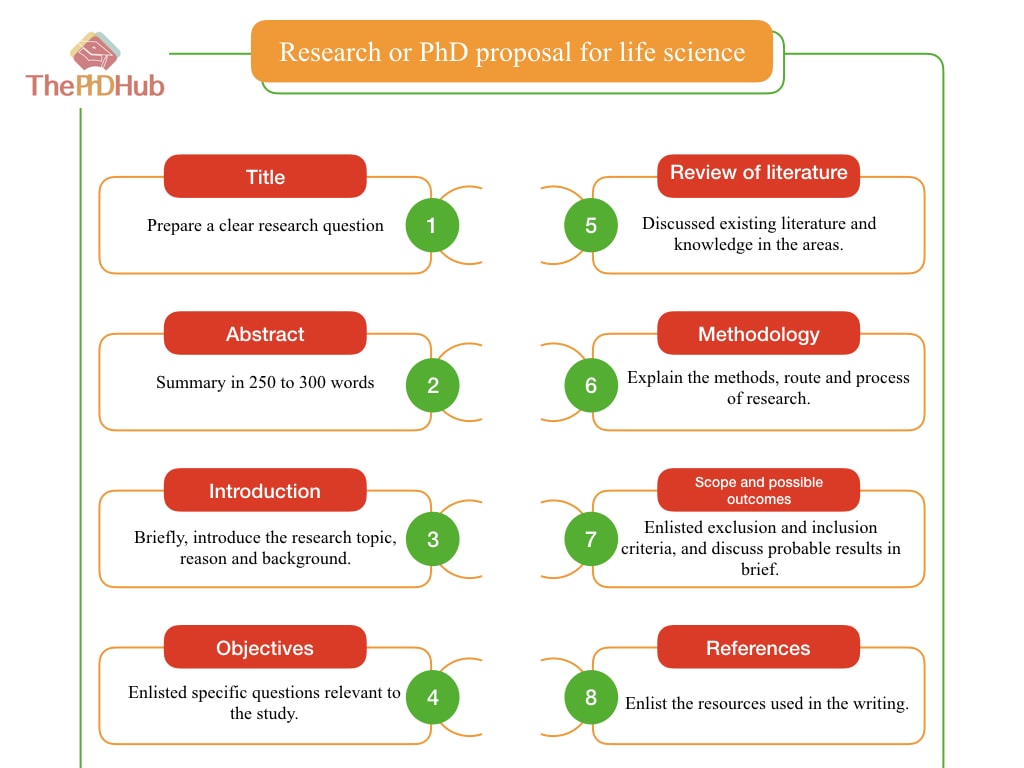
How do you write a project/research proposal for life science?
Every research proposal has some common elements, without which it looks incomplete. Oftentimes, a supervisor checks them first. For instance, it should have a background/ introduction, review of literature, methodology, scope and bibliography sections.
When you blankly initiate your life science project proposal writing, it looks easy, but when it gets rejected or you read things on the internet relevant, it becomes difficult. However, by avoiding common mistakes and following a usual guide, the student can write their own.
At this point, you might be willing to do a PhD, first understand that a life science subject research or project proposal is a different venture than a grant proposal and cover letter. So make it clear that you are writing a research proposal that is the same as a PhD or project proposal.
A life science research proposal is certainly a distinct proposal.
- It should have a comprehensive review of the literature section which discusses all of the major points relevant to the research question.
- The research title should be clear, and concise and must show a clear goal, objective, methods and techniques. I have discussed how to prepare a PhD title in our previous article. You can read it there.
- It should elaboratively explain the materials and methodology section. Wet lab experimentation has been significantly involved in life science research/PhD, so beyond doubts, this section must show how the experimental work would go.
- Also, it must demonstrate sampling, analytical and interpretation methods that help to obtain tentative results thereby achieving objectives.
- It should show the scopes of the study and possible outcomes in terms of societal or real-world importance.
- Lastly, Use correct citation and referencing “in-style.”
Moreover, Also keep in mind what should not be included here. Because after all, everything is covered within 10 to 12 pages (including references).
Things to avoid:
- Give a brief background of the topic. Avoid explaining everything here.
- Review associated research, in brief. Keep in mind that it would justify the research question. Do not discuss separate reviews here.
- Avoid including every possible utility that you are going to use, for example, glassware, plasticware, and instruments, etc. Discuss the SOP, route or road map using which the objectives will be achieved.
- Discuss the method which you have selected, not the technique, in the long run you might have to change the technique. For example,
- Avoid giving a clear statement regarding the results. Instead, enlist possible outcomes. For example,
- Do not claim anything in the research proposal. For example,
Research proposal template for life science:
Research work plan: .
I have specifically highlighted the last segment because it is very important and must be included in the research plan, however, students usually avoid it or do not even have an idea about it. Surprisingly, I was not aware of it until I showed it in one of my student’s proposals.
It is amazing, indeed, even I was impressed! It definitely proclaims your interest and preparation for doing research or PhD. It needs a comprehensive explanation to prepare that I think deserves a separate article. Here I am only giving you the template.
Costume PhD writing services:
If you are worried about your research proposal and still lack the concept of how to do it. Leave it to us. I and My team are experienced life science scientists who can do the job for you. Send us an email on [email protected] or [email protected] to get more information.
We can prepare a costume proposal as per your requirements. Remember, we believe in expertise and our’s is in life science. We only accept writing work related to our subject.
Wrapping up:
Life science subjects need attention on so many things. Their focus would be on lab work and hence they face problems in writing such assignments. Sometimes, only bad writing becomes a reason for rejection. This comprehensive guide perhaps benefits you. Still, if you are not sure, contact us, we will help you.
Also, take a tour of our blog, my team has written some amazing articles that certainly help you in your PhD endeavors. If you want to share your PhD experience, please mail us. We will publish your journal to motivate others.

Dr. Tushar Chauhan is a Scientist, Blogger and Scientific-writer. He has completed PhD in Genetics. Dr. Chauhan is a PhD coach and tutor.
Share this:

- Share on Facebook
- Share on Twitter
- Share on Pinterest
- Share on Linkedin
- Share via Email
About The Author

Dr Tushar Chauhan
Related posts.

How to Choose the best Thesis Writing Service in 2022?
1 thought on “how do you write a project/research proposal for life science”.
What’s Going down i’m new to this, I stumbled upon this I’ve found It positively useful and it has aided me out loads. I am hoping to give a contribution & help different users like its helped me. Great job.
Leave a Comment Cancel Reply
Your email address will not be published. Required fields are marked *
Save my name, email, and website in this browser for the next time I comment.
Notify me of follow-up comments by email.
Notify me of new posts by email.
Change Password
Your password must have 8 characters or more and contain 3 of the following:.
- a lower case character,
- an upper case character,
- a special character
Password Changed Successfully
Your password has been changed
- Sign in / Register
Request Username
Can't sign in? Forgot your username?
Enter your email address below and we will send you your username
If the address matches an existing account you will receive an email with instructions to retrieve your username
Recent Research in Science Teaching and Learning
- Sarah L. Eddy
*Address correspondence to: Sarah L. Eddy ( E-mail Address: [email protected] ).
Department of Biological Sciences, STEM Transformation Institute, Florida International University, Miami, FL 33199
Search for more papers by this author
The Current Insights feature is designed to introduce life science educators and researchers to current articles of interest in other social science and education journals. In this installment, I highlight three diverse research studies: one addresses the relationships between active learning and teaching evaluations; one presents an observation tool for documenting metacognition in the classroom; and the last explores things teachers can say to encourage students to employ scientific reasoning during class discussions.
STUDENT EVALUATIONS AND ACTIVE LEARNING
Henderson, C., Khan, R., & Dancy, M. (2018). Will my student evaluations decrease if I adopt an active learning instructional strategy? American Journal of Physics , 86 (12), 934–942. https://doi.org/10.1119/1.5065907
Student evaluations are widely used and are often the sole source for the evaluation of faculty teaching. As described in the Introduction, fear that one’s student evaluations may decrease is one of the oft-cited reasons for faculty not adopting active-learning techniques. Yet this phenomenon has not been studied on a large scale. Henderson and colleagues test the hypothesis that active learning lowers student evaluations in a population of physics and astronomy instructors who participated in a long-running faculty development workshop. Forty percent (40%) of new physics and astronomy faculty attended this workshop. Of the more than 1300 workshop participants, 431 responded to a follow-up survey. Participants were asked about their use of active-learning methods in their most recent quantitative physics class; whether their student evaluations were impacted by the use of active learning; and whether students complained about the inclusion of active learning. If a faculty member reported a change in student evaluations, he or she was given an opportunity to provide an explanation for that change.
The majority of respondents saw either an increase (48%) or no change in their student evaluations (32%). The subset of instructors who reported receiving lower teaching evaluations also reported substantially less time lecturing than instructors who reported better evaluations. This pattern seemed driven by people using interactive methods for more than 80% of a class period, as this population was more likely to report reduced evaluations. Student complaints followed a similar pattern, with an increase in complaints becoming the most common outcome for instructors using active methods more than 80% of class time.
The reasons shared by instructors for why their evaluations changed were varied. For those who reported their evaluations improving, more than 20% of the instructors thought this increase was due to each of the following: students believing they were learning more, students enjoying class more, students enjoying interacting with one another, or students enjoying using technology. For those who reported lower evaluations, 40% reported that the students felt that the instructor was not teaching. Interestingly, many of these instructors also confessed as part of this comment that they were not good at “selling” the active learning. They next most common explanation given for lower evaluations was that students did not like working during class time; they would rather be listeners.
The results of this study suggest that, for the majority of faculty, adopting active learning will not negatively impact student evaluations. The study also suggests that those instructors concerned about student evaluations could incorporate active-learning activities for as much as 80% of class time and still not be likely to see a negative impact on their evaluations. This could be useful information to share with departmental colleagues and anyone mentoring new faculty who are deciding how to teach. As always, though, some caution should be taken in applying these results in a new context. Specifically, the authors acknowledge that they did not account for what types of active learning instructors implemented. It may be that some methods are more accepted by students than others.
TEACHERS TALKING METACOGNITION
Zepeda, C. D., Hlutkowsky, C. O., Partika, A. C., & Nokes-Malach, T. J. (2018, October 29). Identifying teachers’ supports of metacognition through classroom talk and its relation to growth in conceptual learning. Journal of Educational Psychology (advance online publication). https://doi.org/10.1037/edu0000300
Metacognition refers to one’s knowledge and awareness of one’s own thought processes. As reviewed in the Introduction, metacognition is considered highly desirable for students, because it has been linked to many positive outcomes in experimental and classroom studies, including achievement, transfer of knowledge from one context to another, and motivation. Although many studies have focused on the use of planned interventions for metacognition, few have looked at what teachers are saying and doing spontaneously in the classroom that might influence student metacognition.
Zepeda and colleagues developed an observation protocol to detect classroom talk directed toward metacognitive growth in middle school students in math classrooms. They identified both the metacognitive content of the talk and the delivery method by documenting four dimensions, each with three possible states: the type of metacognitive knowledge being promoted; the metacognitive skill being worked on; the manner in which the teacher delivered this content; and how specific the metacognitive skill is frame d (from specific to the question being worked on to a more global approach to problem solving). For example, a teacher might say, “Alright, so explain to us what you are doing right now.” This would be coded as personal knowledge, because the student is asked about his or her own process. The skill being worked on would be monitoring, (i.e., being aware of why they are doing what they are doing). The manner in which the teacher delivers the content would be directive, because the teacher is telling the student to do something. The framing could be domain general, because the prompt could be used with any type of problem. I am not going to go further into the individual states for each dimension due to space, but there are lengthy descriptions of them within the original paper.
The authors use this observation tool with one class session from 39 middle school math instructors. The classes were selected from a larger national data set of middle school classrooms. Every class included in this larger data set had math knowledge assessments. The current authors created a smaller data set that included instructors who had the most student growth on the math assessment over a year and a set of instructors who had the least growth after accounting for various student- and instructor-level factors. Each video was transcribed and each teacher statement was examined for metacognitive talk. Any instance of metacognitive talk was coded for the four dimensions in the observation tool.
Overall, there were very few metacognitive statements made by teachers (∼7% of teacher statements), but even with this low overall percentage, there were some interesting patterns. The odds of teachers engaging in metacognitive talk were 4.75 times greater during whole-class activities than during activities done individually by students. In addition, in high math growth classes, the odds of instructors engaging in metacognitive talk were 1.5 times higher than in low math growth classes.
The content of the metacognitive talk differed between these two class types as well. In terms of the knowledge dimension, teachers in the high math growth classes elicited more personal knowledge statements in which students shared their own understanding of what they were doing in class than teachers in the low math growth classes. The high math growth class also had more statements focused on the skills of monitoring and evaluating their own work. In terms of how the metacognitive content was delivered (manner), the high math growth class had more directive statements. Finally, the high math growth classes had more domain-general framing of the metacognitive statements.
This study demonstrates that classroom observations can be used to explore metacognition and that the same methods that work most effectively in interventions designed to promote metacognition may also work more informally during teach talk in class. Although the authors cannot rule out that teachers who are more effective in other ways are also more likely to engage in metacognitive talk, the results do suggest that certain ways and certain content of metacognitive talk is more effective than others.
BUILDING STUDENT’S SCIENTIFIC REASONING IN CONVERSATIONS
Grinath, A. S., & Southerland, S. A. (2018). Applying the ambitious science teaching framework in undergraduate biology: Responsive talk moves that support explanatory rigor. Science Education , 103 (1), 92–122. https://doi.org/10.1002/sce.21484
Active learning is centered around the idea that it encourages students to engage in their own learning, often through conversations about course content. Yet the quality of these conversations can vary. In this paper, Grinath and Southerland explore how instructors can influence in-class student discussions.
To explore the question of facilitation effects without confounding variables of differences between lessons, content, and students, the authors chose to work with 26 teaching assistants (TAs) instructing sections of the same introductory biology lab for nonmajors at the same university. This controlled both the content being presented to students across instructors and the structure of the lessons, as each TA was provided the same slides and the same training in how to conduct the lab. The laboratory lessons were designed around the Ambitious Science Teaching framework described in the Introduction, which is meant to help students engage in the meaningful practices of their discipline, including scientific dialogue. One aspect of this framework is helping students connect their everyday explanations of their experiences to the scientific principles underlying them, that is, bridging their everyday way of talking and science talk. This initial conversation is thought to help them meaningfully engage in the subsequent lesson. This study focuses on these initial conversations.
Grinath and Southerland recorded the 8- to 22-minute–long class discussions that opened a lab class exploring how organisms respond to stimuli. At the start of class, students were asked to describe how they experience stress and explain what is driving this response. The authors transcribed the recordings and characterized each TA discourse “move,” a statement made by a TA that served a specific communication function. These moves were coded as conservative or ambitious . Conservative patterns follow the traditional classroom pattern, in which the expertise lies with the instructor only. These moves include the instructor asking questions that only have one correct answer, usually about recalling facts or procedures; evaluating a student response as right or wrong; and explaining the connection between the student response and the scientific concept rather than having students make the connection. Ambitious patterns of discourse allow students to be experts, and the instructor is the facilitator. These instructor moves include asking questions with many possible reasonable answers, probing student responses, and pressing students to supply explanations for their answers. Finally, observers also coded TA moves as inclusive or not inclusive . Inclusive moves could include providing opportunities for multiple students to respond to a question, acknowledging a contribution without indicating correctness, and repeating student responses out loud.
The discourse moves were correlated with student talk. Grinath and Southerland used a framework for explanatory rigor of scientific talk to code student responses in the initial class discussion. There were three codes for student answers: fact , observation , and explanation . A turn of student talk was coded as fact if it was short and a vocabulary word or scientific definition not grounded in personal experience. Observations were what a student thought was happening based on personal experience. Finally, explanations were students’ ideas of why something was happening. The goal of ambitious science teaching is to help students start making their own explanations of phenomena grounded in science and their own experiences. Thus, TA discourse moves that promoted student explanations were considered the most important in this study.
Using linear regressions with a Bonferroni correction for multiple comparisons, Grinath and Southerland found that conservative discourse moves by TAs were related to an increase in student responses being simply fact statements. Ambitious questions (with multiple possible answers) did not predict student responses, but ambitious responses in which TAs deliberately probed student response and pressed students to expand on their answers did relate to increased explanations. Finally, inclusive moves together related to increased observations given by students.
This work highlights several interesting principles that could be expanded beyond labs. First, it seems that, without deliberately pressing for it (and removing the instructor’s explanations), students are not making explanations themselves. They offer facts or observations and wait for the instructor to put them together. Yet explaining phenomena is a key scientific practice and one students should develop. Second, how instructors respond to student answers is critical for creating meaningful conversations in the classroom, maybe even more critical than the qualities of the initial question itself.
- A Critical Feminist Approach for Equity and Inclusion in Undergraduate Biology Education 22 April 2021

© 2019 S. L. Eddy. CBE—Life Sciences Education © 2019 The American Society for Cell Biology. This article is distributed by The American Society for Cell Biology under license from the author(s). It is available to the public under an Attribution–Noncommercial–Share Alike 3.0 Unported Creative Commons License (http://creativecommons.org/licenses/by-nc-sa/3.0).

[100+] Life Science Topics With Free [Thesis Pdf] 2023
Are You Searching Research Topics For Life Science , Topics For Life Science Research Paper, Life Science Research Topics For Students, Research Topics Ideas For Life Science, Life Science Research Topics For PhD, Life Science PhD Topics. So You are in right place.
In this article, we provide you latest research topics for Life Science with a full Phd thesis. By these research topics for Life Science you can get idea for your research work. On this website, you can get lots of Life Science Research Topics for College Students, PhD, Mphil, Dissertations, Thesis, Project, Presentation, Seminar or Workshop. Check the suggestions below that can help you choose the right research topics for Life Science: You can also Free Download Life Science Research PhD Thesis in Pdf by the given link.
Now Check 100+ Life Science Research Topics List
Table of Contents
Research Topic For Life Science 2023
Life science research topics for dissertation, research topics ideas for life science, life science research topics ideas for college students, topics for life science research paper, life science research topics for thesis, life science research topics for students, life science research topics for undergraduate students, life science research topics for university students, life science research topics for phd, research topics for phd in life science, research topics for mphil life science, life science phd topics, research paper topics for life science, life science research paper topics, phd thesis topic for life science, research topics for life science subject, life science research topics for fisheries, research topics for life science, life science research topics examples.
Note: All Research Work Idea on this website is inspired by Shodhganga: a reservoir of Indian Theses. We provide you mostly research work under Creative Commons Licence. Credit goes to https://shodhganga.inflibnet.ac.in/
If you find any copyright content on this website and you have any objection than plz immediately connect us on [email protected]. We Will remove that content as soon as.
This Post is also helpful for: Life Science Thesis Pdf, Life Science Thesis Topics, Life Science Dissertation Topics, Life Science Thesis, Catchy Title For Life Science, Phd Thesis Topic for Life Science, Life Science Research Paper Topics, Life Science Phd Topics, Life Science Research Topics, Research Topics For Life Science Students in India, Life Science Research Topics For College Students.
7 thoughts on “[100+] Life Science Topics With Free [Thesis Pdf] 2023”
- Pingback: Home - Research Scholar
- Pingback: Home Page 3 - Research Scholar
- Pingback: How To Write Master Thesis Pdf: Step By Step Example and Quickly Tips - Research Scholar
- Pingback: How To Do Research in Law 2023 - Research Scholar
- Pingback: How To Do Research in Biotechnology 2023 - Research Scholar
- Pingback: How To Do Research in Sociology 2023 - Research Scholar
- Pingback: How To Do Research in Medical 2023 - Research Scholar
Leave a Comment Cancel reply
Save my name, email, and website in this browser for the next time I comment.
An official website of the United States government
The .gov means it’s official. Federal government websites often end in .gov or .mil. Before sharing sensitive information, make sure you’re on a federal government site.
The site is secure. The https:// ensures that you are connecting to the official website and that any information you provide is encrypted and transmitted securely.
- Publications
- Account settings
Preview improvements coming to the PMC website in October 2024. Learn More or Try it out now .
- Advanced Search
- Journal List
- CBE Life Sci Educ
- v.9(3); Fall 2010
Introductory Life Science Mathematics and Quantitative Neuroscience Courses
Dwight duffus.
Departments of *Mathematics and Computer Science and
Andrei Olifer
† Biology, Emory University, Atlanta, GA 30322
We describe two sets of courses designed to enhance the mathematical, statistical, and computational training of life science undergraduates at Emory College. The first course is an introductory sequence in differential and integral calculus, modeling with differential equations, probability, and inferential statistics. The second is an upper-division course in computational neuroscience. We provide a description of each course, detailed syllabi, examples of content, and a brief discussion of the main issues encountered in developing and offering the courses.
INTRODUCTION
We describe two efforts to improve the mathematical, statistical, and computational training of undergraduates in life science majors at Emory College.
Description of Objectives
The Mathematics and Computer Science and the Biology Departments both offer courses that provide mathematical, statistical, and computational instruction for life science majors at Emory College. An introductory sequence is intended for freshmen with good high school mathematics background and has been taught by mathematics and computer science faculty for almost 15 yr, in various forms. It provides the quantitative training needed by all life science students and is required by the Department of Biology for its Bachelor of Science program. For quantitatively intense subdisciplines, the Department of Biology has upper-division courses in modeling and computation. We describe one course, in computational neuroscience, that has been offered for the past 3 yr.
Curricular and pedagogical issues in preparing life science students for an increasingly quantitative set of disciplines have several consistent themes. Our introductory mathematics sequence for life science majors, Mathematics 115/116-Life Science Calculus 1/2, addresses two of these themes.
First, mathematical, computational, and statistical methods are of ever-growing importance in the life sciences. We introduce the basic quantitative tools required in modern life science research, adhering to the recommendations of the National Research Council report BIO2010 ( National Research Council, 2003 ) and the Mathematical Association of America's Math & Bio 2010 ( Steen, 2005 ). Consequently, introductory quantitative course work should include modeling change in biological systems via discrete dynamics, continuous differential equations (DEs), and stochastic processes; and organization and analyses of data in information-intensive fields such as molecular evolution and genetics.
Second, researchers in the biological sciences and also health science professionals must be discerning readers of the research literature. In particular, critical evaluation of, and conclusions drawn from, mathematical models and statistical studies is indispensable. These require experience constructing and criticizing models of biological phenomena and an understanding of probability theory, as the underpinning of inferential statistics, and exposure to statistical methods used to establish confidence and test hypotheses.
Preparation of majors for graduate programs in highly quantitative subdisciplines is also of growing importance. For students involved in computational neurobiology or population biology, for example, appropriate course work must be designed. Mathematical Concepts in the Neurosciences (MCN) at Emory College provides an example of such a course. Neuroscience is rapidly becoming one of the most quantitative biological fields. An increasing number of research papers in neuroscience combine results of experiments and computer simulations of mathematical models. MCN focuses on several seminal mathematical models used in neuronal coding, neuronal and network dynamics, and learning in neuronal networks. The main objective of the course is to develop in students the ability to interpret, analyze, and develop these models. A secondary objective is to stimulate a deeper understanding and active use of the mathematical concepts used in the formulating and analyses of models. A brief syllabus of MCN is provided in Mathematical Concepts in Neuroscience.
Main Challenges
Concerning the introductory sequence, it is now the main mathematics requirement for the biology major. Unfortunately, student math background and aptitude vary widely. We attempt to balance continuity with high school math training, as varied as it is, with emphases on modeling and problem solving, which are usually new to our students. To manage quite demanding syllabi, there is a mandatory additional contact hour that allows review of material, question-and-answer, and more frequent testing; so, students have 3 lecture hours and 1 lab hour each week. And Emory College offers a supplemental instruction program based on peer tutoring, an important resource. Substantial integration of life science topics is key both to the educational purpose and to student interest. This has been underscored with presentations by biology faculty on topics such as population biology and modeling physiological systems such as the neuron. In teaching inferential statistics, it is important to emphasize experimental design and to use real experimental data.
Coordination of several text and Web sources is required. Unlike the situation in physics-oriented calculus education, there are not many texts that address the range of topics required. The choice of proper content and textbooks for MCN is also a challenge. There are several excellent textbooks on the application of mathematical methods in the neurosiences, including Foundations of Cellular Neurophysiology ( Johnston and Wu, 1995 ), Computational Cell Biology ( Fall et al. , 2002 ), and Mathematical Physiology ( Keener and Sneyd, 1998 ). From our perspective, the most balanced representation of mathematical concepts used in the modern neurosciences is presented in Theoretical Neuroscience: Computational and Mathematical Modeling of Neural Systems ( Dayan and Abbott, 2001 ). For example, Dayan and Abbott consider not only excitability of individual neurons and dynamics of activity in neuronal networks but also information-theoretic approaches to neuronal code and learning in neuronal networks—important themes that are often underrepresented in textbooks. Dayan and Abbott clearly demonstrate how a mathematical approach helps to solve many fundamental problems in neuroscience. Unfortunately, mathematics is just used and not discussed in the book. Our challenge is to retain the research spirit of the book but adapt the content to undergraduates who have just begun to understand the role of mathematics in neuroscience.
We have chosen Theoretical Neuroscience: Computational and Mathematical Modeling of Neural Systems as a main textbook. However, during the course we referred to other textbooks on specific topics. For example, when considering modeling neurons with simple nondifferential equations, we used some models and diagrams from Dynamical Systems in Neuroscience: The Geometry of Excitability and Bursting ( Izhikevich, 2010 ).
Another challenge is building adequate enrollment. MCN is an elective course. It has to compete for students with many well-established courses that do not “scare” biology students with mathematics. The health career focus of the majority of majors presents a real challenge. It is hoped that courses such as MCN, supported by the introductory sequence and early independent research opportunities, will be useful in attracting more students intent on science graduate programs, as well as changing the ambitions of current students.
INTRODUCTORY MATHEMATICS SEQUENCE FOR LIFE SCIENCE MAJORS
In this section, we describe several versions of the year-long Mathematics 115/116-Life Science Calculus 1/2 that have been taught at Emory over the past 14 yr.
In the early 1990s, the Science and Mathematics Departments at Emory College were meeting regularly to discuss Science 2000, an ambitious faculty, program, and infrastructure development plan. We were eager to expand our majors, individually and in collaborative interdisciplinary programs. We also wanted to modify the premed orientation of the strong majority of lab science majors and to attract more students to our majors intent on graduate education in what have come to be called the science, technology, engineering, and mathematics (STEM) disciplines. Even 20 yr ago, it was obvious that the life sciences were being transformed by the essential use of mathematics, statistics, and computing and that the standard physics-based calculus sequence did not provide the right quantitative training for life science majors.
Early Versions of the Sequence
We began in 1997–1998 after extended discussions with faculty in biology and biostatistics.
Version 1: 1997–1999. Main reference: Mathematics for the Biosciences ( Cullen, 1983 ). The two-course sequence was purposely designed to have the first term quite similar to Calculus 1, so that students could switch freely between the standard Math 111/112-Calculus 1/2 and the life science sequence. The second course was substantially different from standard Calculus 2, substituting DEs, discrete probability, and inferential statistics for integration techniques and series and sequences.
The course was designed with input from the Department of Biology and was recommended by it for its majors, but it was not required. Enrollments in 1997–1998 in 115/116 were 28/12 and increased the next year to 48/20 students. The course was taught in two small sections each fall, with one section in the spring. During the same years, enrollments in standard, business, and Advanced Placement (AP)-based calculus were approximately 400–500.
The department was pleased with the initial offerings but not with the available texts. We found it difficult to maintain enough similarity with Math 111 to allow students to switch between sequences and to introduce interesting life science applications. Enrollments were disappointingly low, because the courses were not well enough publicized and although recommended by the Department of Biology, they were not required by any majors.
Version 2: 1999–2007. Main reference: Modeling the Dynamics of Life: Calculus and Probability for Life Scientists ( Adler, 1989 , 2005 ). The text and syllabus marked a substantial departure from the original objective of keeping the first term close to Calculus 1. Adler begins with a precalculus review and an introduction to discrete dynamics. This is followed by differential calculus and then by applications featuring the relationship between the derivative and stability of equilibria. DEs and definite and indefinite integrals complete the first course. Substantial modeling topics are included throughout the syllabus.
The second term begins with more DEs, including equilibria and stability for autonomous DEs. Systems of DEs and the phase plane are used to model competition, predator–prey interactions, and epidemics. An ambitious model of the neuron concluded the DE modeling segment of the second term, approximately one-third of the course. This was followed by an introduction to probability and descriptive statistics, discrete and continuous random variables, the binomial and normal distributions, and the central limit theorem (CLT). Inferential statistics, featuring estimates of the mean, confidence intervals, and hypothesis testing, are the last topics.
During summer 2003, with a grant from the Faculty Science Council and College Center for Science Education, the sequence was revised to include a MATLAB (The MathWorks, Natick, MA) component. This was used for both modeling and statistics. The department has an instructional computer lab with 32 networked work stations that allowed MATLAB training and assignments.
During this period, enrollments grew to almost 100 in the fall term, taught in several small sections, with never >50 in the spring. Instructors were pleased with the evolving syllabus and choice of topics. However, students were not so happy about the introduction of MATLAB. The course became difficult to offer logistically and just a bit overwhelming. Although the courses were still not required by any of the life science majors, Department of Biology advisors strongly suggested the sequence to freshmen and continuing students who had delayed taking mathematics.
Version 3: 2007–2008. Main references: Mathematical Models in Biology ( Allman and Rhodes, 2004 ), Calculus Lite ( Morgan, 2001 ), and Chance in Biology: Using Probability to Explore Nature ( Denny and Gaines, 2000 ). This was the most significant departure from standard calculus that we attempted. We used Mathematical Models in Biology ( Allman and Rhodes, 2004 ) to introduce topics such as population dynamics and initially study them with discrete difference equations. Calculus was introduced, as needed, to understand continuous change. In term 1, we developed discrete and continuous models of populations, infectious disease, and predator–prey systems. These were analyzed with cobwebbing and phase lines; stability of equilibria was determined with the derivative. After introducing the integral and DEs, we saw how autonomous DEs provide continuous versions of the previous population models.
Term 2 began with systems of DEs, including predator–prey and the susceptible-infected-recovered (SIR) model of epidemics. Phase planes and slope fields were used to provide qualitative information about solutions. Probability and statistics were then motivated by genetics and molecular evolution. Probability topics included Bayes theorem, rare disease examples, discrete and continuous random variables, binomial and geometric distributions, the normal distribution, and the CLT. Statistical methods included descriptive and inferential statistics, with emphasis on hypothesis testing, sampling distributions, and analysis of variance.
MATLAB was an important demonstration tool in the course, in part because it is used extensively in the Allman and Rhodes (2004) textbook. We had more opportunity for this because an extra lab hour was added to the course in 2007–2008, a feature that we have retained. Students in each lecture section (approximately 40 in each of two) are divided into two labs that taught by the same lab instructor.
Both course instructors were pleased with the syllabus. Presenting students with both discrete and continuous versions of the same models seemed to work well. This provided invaluable exposure to modeling and problem solving. However, several organizational issues forced us to return to a more standard syllabus. First, the Department of Biology (finally) decided to require the sequence for its B.S. degree program. This meant that we needed to accommodate more students, with more varied backgrounds. It was decided to allow students with AP Calculus credit to place out of Math 115 and enroll in Math 116 in the spring term and to allow students to switch from Math 115 to Math 112. This required that Math 115 topics more closely approximate Math 111 and that Math 116 not presume exposure to discrete dynamics. In fact, discrete dynamics has, essentially, disappeared from the first-term course and is mentioned only briefly in comparison with DE modeling in the second term. The next section contains a detailed description of the course as it exists now.
Concerning enrollments in these versions of the course, the Department of Biology graduated ∼100 students per year between 2000 and 2009, with a high of 132 and a low of 92. Numbers in the 1990s were somewhat higher—the Neuroscience and Behavioral Biology Program (subsequently becoming a department) has attracted many majors, some away from biology. It is difficult to get an accurate estimate of the proportion of biology majors who took the 115/116 sequence as their main college mathematics in the past. It may be possible to query the registrar's databases to compare grades of biology graduates in specific quantitatively intensive life science courses who took Math 115/116 with those of students who took other, or no, mathematics courses. The results would be confounded to some extent by precollege mathematics background.
Math 115: Life Science Mathematics 1
Below are the main topics in the current first-semester syllabus.
- Precalculus review including trigonometric, exponential and logarithmic functions, exponential growth, and decay models.
- Introduction to differential calculus, including transcendental functions and applications of the derivative to optimization and graphing, higher-order derivatives, emphasis of growth models including logistic growth, optimal foraging, and Newton's law of cooling.
- Introduction to integral calculus including antiderivatives, definite integrals, Riemann sums, and the fundamental theorem of calculus, integration by substitution and by parts, area under the curve, and volume of a solid, improper integrals.
- Introduction to differential equations, separation of variables, equilibria of autonomous DEs, simple epidemic model, and more growth models.
The main text for the course is Calculus for the Life Sciences by Bittinger et al. (2006) . Additional material is drawn from the Web-based courses offered by Leah Keshet and colleagues at the University of British Columbia ( www.math.ubc.ca/keshet ) and from a National Science Foundation-sponsored project led by Moore and Smith at Duke University (CCP materials, www.math.duke.edu/education/modules2/materials ). This academic year, we enrolled almost 150 students in two 60-student and one 30-student sections, with labs of 30 students each.
Math 116: Life Science Mathematics 2
Below are the main topics in the current second-semester syllabus.
- Systems of differential equations, particularly predator–prey systems, models of species competition, and the SIR model of infectious disease. Slope fields and phase plane diagrams describe the qualitative behavior of solutions.
- Introduction to matrices and partial derivatives. Use of the Jacobian to describe the type and stability of equilibria of systems and the shapes of trajectories.
- Introduction to probability theory, motivated by genetics and molecular evolution, including: discrete spaces, conditional probability, rare disease examples, discrete random variables, binomial and geometric distributions, continuous random variables, probability density functions, the normal distribution, and the CLT.
- Introduction to statistical methods: descriptive and inferential statistics, with emphasis on confidence intervals and hypothesis testing, sampling distributions, and analysis of variance.
- Additional material may include probabilistic topics such as random walks applied to diffusion and genetic drift, and statistical tools such as the chi-square test, contingency tables, goodness-of-fit, and nonparametric tests.
We begin with one chapter from Bittinger et al. (2006) and continue with material from Chance in Biology ( Denny and Gaines, 2000 ). Many sources are used for the statistical material. This year, we enrolled almost 100 students in three sections.
Examples from the Course
We illustrate the level and focus of the courses with two sets of examples drawn from the current syllabi of the two courses: modeling biological systems with DEs and the CLT and sample means.
Modeling Biological Systems with DEs. In Math 115, we develop various population models, beginning with exponential and logistic growth. Optimization applications include optimizing food intake of bees and maximizing a sustainable fish harvest. Autonomous differential equations are illustrated with Newton's law of cooling.
Systems of autonomous DEs are introduced in Math 116—basic predator–prey models provide an important example. Let p = p ( t ) and q = q ( t ) be two populations described by

In developing this model ( Figure 1 ), we begin with a logistic growth model for the prey population p ( t ) and exponential decay for the predator population q ( t ). We use the law of mass action to introduce the interspecies interaction terms −0.05 pq and 0.08 pq . The Jacobian is used to describe the nonextinction equilibrium and the behavior of trajectories.

Numerical methods and MATLAB yield the trajectory on the left and the solution curves on the right. There is also Web-based direction field software that will draw trajectories. This allows easy experimentation with different initial conditions and with varied constants in the equations.
This is one of three models of biological systems that we study in the first part of Math 116. This is based on extensive discussion of exponential and logistic growth in Math 115. It requires a brief introduction to two-variable functions, partial derivatives, and very basic matrix theory, including eigenvalues and eigenvectors. The qualitative description of trajectories also is applied to competition models and to the SIR epidemic models. We use Web materials developed at Duke (CCP materials, www.math.duke.edu/education/modules2/materials ), particularly for the epidemic models.
CLT and Sample Means. Probability theory is easily linked to a variety of life science topics. Conditional probability, Bayes' theorem, and rare disease examples provide one of the most accessible and surprising applications. In Math 116, we do enough probability theory to discuss random variables and several distributions. We illustrate the discrete geometric and binomial distributions with several life science examples, notably topics in genetics such as the Hardy–Weinberg law. The Poisson distribution is very important in understanding biological processes and provides a link between discrete and continuous distributions. Aside from the normal distribution, we also discuss the memoryless exponential distribution.
The CLT links probability theory and the main tests of inferential statistics, a powerful mathematical tool that we repeatedly emphasize in the course. It asserts that if sufficiently large random samples are drawn from a population then the distribution of sample means is approximately normal. In Figure 2 we display this using the exponential distribution with parameter λ = 0.2 and hence mean μ = 5 and variance δ 2 = 25. Note the change from an exponentially shaped curve with n = 3 to an approximately normal curve with n = 30. We show how the CLT supports the use of confidence intervals and of hypothesis tests such as the z test and t test. We do not develop the theory behind the chi-square test but it is used to test compound hypotheses. When time allows, we also consider tests of paired data.

Left, sample size, n = 3. Right, n = 30, with a very close fit to the normal curve predicted by the CLT. Can we approximate the variances for each? Can we account for the difference in variances?
Issues and Future Directions
There are several issues that we continue to face in offering this course. As noted, biology majors bring substantial variation in mathematical background and aptitude. Calculus is not a prerequisite for the sequence. However, students who enter Emory College without calculus usually have spotty math background and weak skills. Conversely, students with extensive high school math, such as the BC version of AP Calculus, have quite clear ideas about what math is all about. They can be resistant to new topics and new foci on model building. Dealing with a heterogeneous population and maintaining a balance between a challenging course and realistic expectations will always be an issue with an introductory math for bio sequence.
An important related point is that this is a mathematics sequence, taught by math faculty. Even math faculty who do very applied work want to introduce the required theory. For example, analysis of equilibria and trajectories of solutions of systems of DEs requires enough matrix theory to talk about eigenvalues and enough about approximation through linearization to justify conclusions based on the Jacobian of partial derivatives. And the CLT is a mathematical gem that supports the tests of inferential statistics. We could spend considerably more time on learning recipes if we did not develop the mathematics required for qualitative analysis of equilibria or the CLT.
It is important to introduce students to appropriate computational software. A graphing calculator and a spreadsheet program such as Excel (Microsoft, Redmond, WA) are adequate for almost all the statistical material. But it would be useful to reintroduce MATLAB into the courses in order to solve larger linear systems and to obtain numerical approximations.
The main text ( Bittinger et al. , 2006 ) is adequate for the first term as it now is defined. There is no text at the right level that provides the calculus, probability, and inferential statistics material. The Adler text (2005) has just about the right mix but does not do a good job of presenting inferential statistics in a concise, readable way. Over the past couple of years, we have consolidated the material for Math 116 but we would still prefer a single text, or pair of inexpensive texts, for the sequence.
There are at least two strategies for improving this course sequence. First, we can strengthen the internal organization of the courses. For example, population models could be more realistically developed, based on a more thorough grounding in population biology. The predictions of our models could then be tested using the statistical methods we later study. Second, there is a great deal to be gained by linking our syllabus with those of related life science courses. If, for instance, our presentation of probability could be coordinated with the right topics in the genetics course, there would be mutual reinforcement. Given the way students take courses—and departments organize them—this sort of cooperation is very difficult. This is one of the reasons that science educators are intrigued by interdisciplinary introductory science courses.
MATHEMATICAL CONCEPTS IN NEUROSCIENCES
Life Science Mathematics 1 and 2 develop a background to teach mathematics related to specific areas of life sciences. Along these lines, we developed the MCN course. This is a course for majors in biology and in neuroscience and behavioral biology. In what follows, we describe the main ideas behind the syllabus of the course, the syllabus itself, and some of the hands-on experience.
Problem-driven Mathematics
In the course, mathematical concepts are introduced in a problem-driven way. We start with real biological problems and discuss appropriate mathematical models of the processes considered. Students engage their biological expertise and think about the meaning and strengths and weaknesses of mathematical models. Then, they are presented with the mathematical apparatus necessary for the model analysis.
Neuroscience has quite a number of problems that have been critically advanced by using mathematical models. We do not pretend to cover them all. Rather we strive to select such a sequence of problems that allows us to use simple mathematics first and then gradually increase the complexity, and to use mathematical concepts repetitively, so that the students could understand them more deeply and learn to use them in different contexts.
The course is intense. To quickly and clearly present biological problems, experiments, data, and mathematical models, we use a lot of slides. Some of these slides are available at a WikiFuse site (to which we contribute) at http://wikifuse.pbworks.com/browse/ and select Math for Neuroscience. Although the problems are drawn from the neurosciences, it should be clear from the syllabus below that the mathematical models and methods considered are quite general and are fundamentally important for other areas of biology as well.
The structure and main items of the MCN syllabus are presented in Table 1 . As the table shows, some themes are repeated. First, these are the basic characteristics of random variables such as the mean and variance. They appear as an initial description of experimental spike time series. Later, these characteristics are calculated for the binomial and Poisson distributions. Stable steady states of ordinary differential equations (ODEs) are considered multiple times: initially while deducing the equations of ionic channel kinetics ( Hodgkin and Huxley, 1952 ), then by exploring steady states of neuronal activity, and finally while considering a network model in which stable steady states model memorized items. Matrices and vectors also are used in various contexts starting from simplest descriptions of population activity through the analyses of network dynamics.
Content of the course mathematical concepts in the neurosciences
Examples from MCN Course
The following examples illustrate the problem-driven approach to introducing mathematics in the MCN course. The first example deals with the analysis of experimental data on activity of hippocampal neurons. The hippocampus is a brain structure that is critically involved in learning and memory. The understanding of the hippocampal functioning gained a lot from hippocampal cell recordings in rats. In particular, experiments with navigating rats revealed that hippocampal cells encode the spatial context of the behavior ( O'Keefe and Dostrovsky, 1971 ). In a typical experiment, a rat with chronically implanted electrodes forages for food pellets. Pellets are dropped to random locations of the arena by an automatic feeder. During a sufficiently long recording (>10 min), the rat visits most locations of the arena multiple times. Remarkably, many hippocampal cells spike only in some parts of the arena, specific for each cell. Figure 3 shows the data for two such cells. The left column of the figure represents the firing rates of the cells. The firing rate in a location (here a 2- × 2-cm square) is defined simply as a ratio of all the cell spikes observed while the rat was in the location to the total time the rat spent in the location. The figure shows that the peak firing rates of the cells are quite similar. The rat hippocampal cells presumably encode not only animal locations. Do these two cells encode different information? To determine other correlates of the cell spiking, more sensitive measures of cell activity are necessary.

Information versus firing rate. Two hippocampal cells, cell 1 (top row) and cell 2 (bottom row), fired only when the foraging rat visited specific parts (red spots) of the circular arena. Although their peak firing rates were similar (left column), the information measure of spiking, I pos was not (right column), indicating important distinction between the information processing in these two cells (adapted from Olypher et al. , 2003 ).
Indeed, the firing rate is an estimate of the mean of the distribution of spike counts observed in the time bins when the rat was in the location. One therefore may think of measures that take into account other properties of this distribution. One such measure follows from averaging the difference between the uncertainty −log P ( k ) of observing k spikes in an arbitrary time bin and the uncertainty −log P ( k | x i ) of observing k spikes in location x i :

Here, P ( k | x i ) is the conditional probability of observing k spikes in a time bin when the rat is in pixel x i , P ( k ) is the unconditional probability of observing k spikes in a time bin wherever the rat is, log ( x ) is the base 2 logarithm. Right column of Figure 3 shows that I pos ( x ) for the two cells is very different. Analysis of multiple hippocampal cells shows that I pos ( x ) is significantly greater in the cells that fire close to landmark cues; therefore, this measure may reflect increased attention ( Olypher et al. , 2003 ).
The second example relates to the problem of neuronal dynamics. Analysis of dynamical equations provides deep explanation of possible regimes of neuronal activity and transitions between them. In the example, we consider the classical model of excitable membrane by Morris and Lecar (1981) . The model describes the time evolution of the electric potential across the membrane of barnacle giant muscle fiber. The membrane has two ionic currents, potassium and calcium. The model is a system of two autonomous nonlinear DEs. Among the parameters of the system are the maximal conductances of the ionic currents ḡ K and ḡ Ca . These parameters can be increased or decreased in the experiment. For example, ḡ Ca can be decreased by substituting CaCl 2 in the artificial sea water where the preparation is kept, by MgCl 2 . If the membrane potential initially oscillated, then this blockage abolishes the oscillations. This phenomenon is explained by a bifurcational diagram of the system ( Figure 4 ). The diagram shows that the oscillations disappear via so-called supercritical Andronov–Hopf bifurcation (e.g., Rinzel and Ermentrout, 1989 ) when ḡ Ca decreases below some critical value.

Bifurcation diagram for the Morris-Lecar model. Maximal and minimal values of the membrane potential V for different values ḡ Ca ; ḡ K =3. Solid line, stable steady state; dashed line, unstable steady state; filled circles, stable periodic oscillations; and open circles, unstable oscillations. AHsup, supercritical Andronov–Hopf bifurcation; AHsub, subcritical Andronov–Hopf bifurcation. The diagram is obtained by using XPPAUTO ( Ermentrout, 2002 ).
Assessment and Future Directions
The MCN course proves the vitality of teaching advanced mathematics to life science students in a problem-driven way. A consequence of the approach is a shortage of time for expanded consideration of mathematical concepts. We addressed this problem by giving homework assignments that motivated further thinking on concepts and suggesting additional reading. One of the three weekly classes was a discussion session. We believe that it is very important to link the course content with ongoing research in the neurosciences. Accordingly, we have developed a number of homework assignments and tests motivated and closely related to influential publications.
We see the ultimate objective of the course in engaging students in using mathematical concepts in the neurosciences and developing their qualitative reasoning ability. In our experience, the engagement of biological students starts with their attempts to understand details of experiments. That was one of the reasons for us to choose neurobiological problems from the studies close to our own research interests. Finally, our experience suggests that methods of problem-based learning will help to achieve the main objectives of the course.
ACKNOWLEDGMENTS
We note that both Math 115/116 and MCN have been developed with support from the Emory College Center for Science Education. Mathematics and Computer Science Department personnel Michael Ferrara and Dr. Shanshuang Yang and HHMI Fellow Aron Barbey received a grant providing research funds to revise the Math 115/116 sequence and stipend support, respectively, from HHMI grant 52003727. A. O.'s development and first offerings of MCN were supported by HHMI grant 52005873. The principal investigator on both grants is Dr. Pat Marsteller, Director of Emory College Center for Science Education.
521 Research Questions & Titles about Science
Do you enjoy revealing the mysteries of nature? There are as many secrets in space as there are deep in the ocean. You may be the one who solves the next puzzle!
Natural science focuses on our environment. We try to understand how and why everything around us works. Living organisms, natural phenomena, rocks, and even the stars, are under scientists’ observation. Research in this area is a continuous process. Sometimes when it seems like we found out the answer, it just creates more questions! There are also plenty of weird things that can’t be explained.
Want to learn more about the scientific puzzles to be solved? Take a look at the collection of science research questions that Custom-writing.org experts have prepared. Find your perfect idea in the list below!
🔝 Top 10 Natural Science Topics for Research Papers
- 💡 Choosing a Research Topic
⭐ Scientific Research Topics List: Top 10
- 💫 Astronomy Topics
- 🐈 Biology Topics
- ⚛️ Chemistry Topics
- ☁️ Environmental Topics
- 🔷 Geology Topics
- 🌈 Physics Topics
- 🔝 20 Research Questions
🔎 References
- How to prevent bacterial diseases
- What is the origin of immunity?
- Main concepts in biolinguistics
- How can you improve gut microbiota?
- Climate change’s effect on bumblebees?
- How did dry climate affect human evolution?
- The importance of bacteria in aquatic ecosystems
- How does the neuron structure change during sleep?
- What’s the link between stem cell divisions and cancer?
- Smoking’s contribution to the mosaic loss of Y chromosome
💡 Choosing an Interesting Science Research Topic
There are plenty of scientific research papers topics to choose from. You can pick an area that you prefer: astronomy, biology, chemistry, nature, geology, and physics. And we prepared a list of at least 35 cool research titles about science in each of them!
However, you should put some effort into choosing a good and interesting topic. There are several aspects you need to consider. The first thing to look into is how easy or hard the future research may be. Evaluate the resources and the skills you have. Are they enough to understand if it is enough to resolve a scientific issue you chose?
Next, you should also foresee the benefits of the research. Proper scientific research can increase knowledge in a specific area. Of course, if you are a college student, you shouldn’t feel any obligation to solve unimaginable problems. However, even a small discovery could be a huge step in understanding an issue.
Therefore, the key concept is to find a topic that would be easy and fruitful at the same time. Don’t rush! Usually, picking the first idea that comes to your mind doesn’t end successfully…
Also, don’t forget to listen to your inner voice. If it feels like the topic is not for you, cross it out. You shouldn’t waste your time working on research that doesn’t satisfy you. It also needs to reflect your point of view.
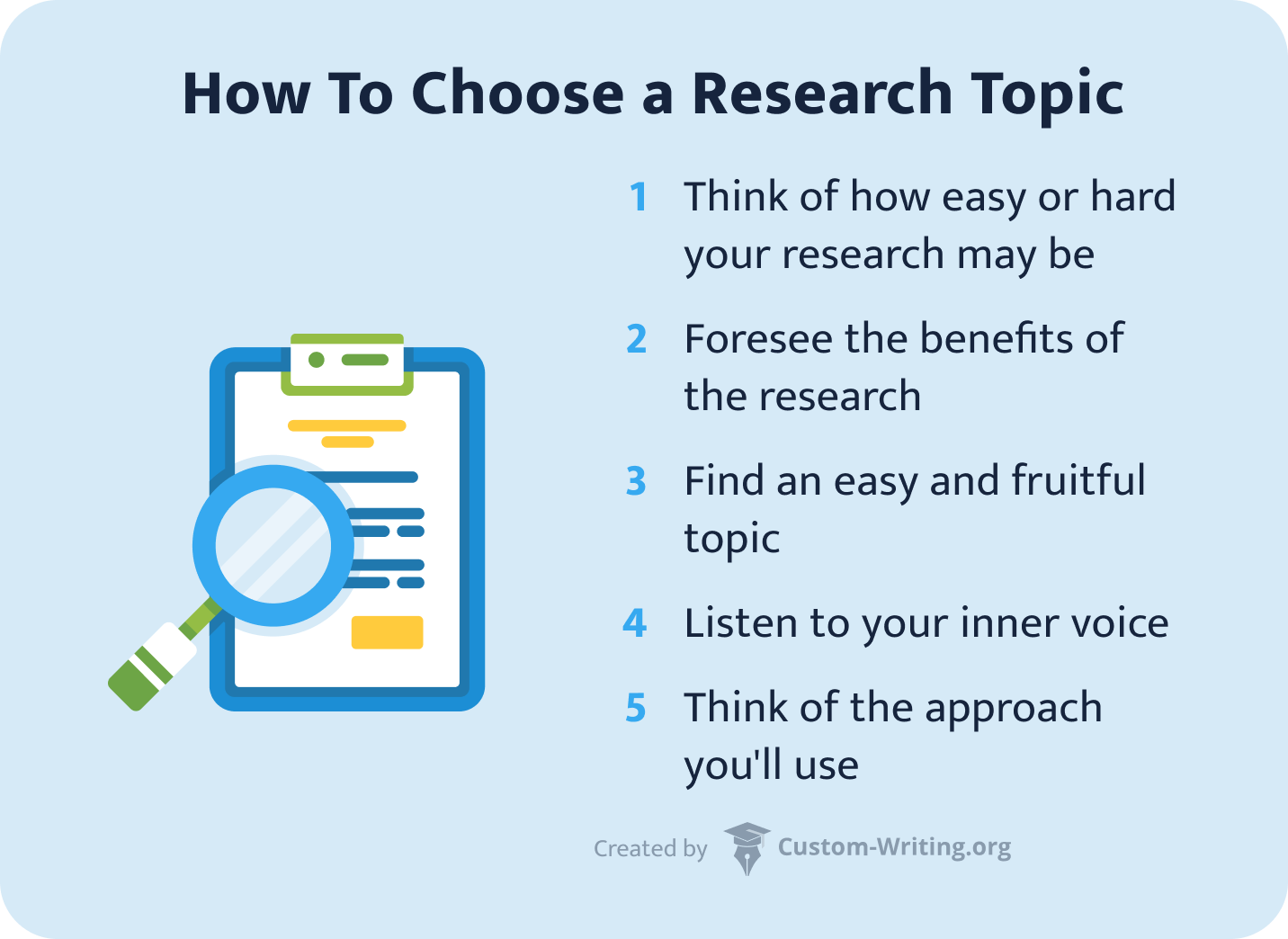
Last but not least, think about the approach of your research since it can also affect the topic. Decide whether you want to start quantitative or qualitative research . Then you might want to check out our collection of 501 good research topics for science!
- How hibernation of animals works
- Virtual reality vs. augmented reality
- Can false memories be implanted?
- The role of cryogenics in rocket science
- How can we reduce the gender gap in STEM?
- Cloud computing’s impact on data storage
- Microscopic techniques used in microbiology
- The importance of stem cells in medical science
- Types of genetic programming in machine learning
- The ways industries can conserve energy consumption
🚀 Space Research Topics
Have you ever had a dream of going into outer space as a kid? If yes, then these space research topics are for you!
Space research studies the observable universe that starts just outside the Earth’s surface. You don’t necessarily need to go in outer space to study it, though. Astronomy is where it all begins. Planets, galaxies, and different phenomena can all be studied from the ground. But note that most current projects also require some knowledge in physics, math, and computer science.
If you feel like it’s for you, then check out the list of the trending astronomy research topics below.
💫 58 Astronomy Research Topics
- Tools used to identify different variable stars: an overview
- Astrophysics: compact binary star systems & broadband variability
- Stellar evolution: young stellar objects with circumstellar material
- Evolved objects: circumstellar material and mass-loss episodes
- What telescopes are used for studying stellar evolution with a multispectral approach?
- The theory of the Universe
- How is interferometry used to observe the circumstellar environment?
- The approaches to building a cool stellar photosphere model
- Mars in comparison to Earth
- How to improve the accuracy of the Infrared Space Observatory?

- The theory of infrared spectroscopy and cool standard stars
- The Milky Way and the expanding universe
- How are stellar candles helpful in determining the extragalactic distance scale?
- The evolution of intermediate-mass single stars
- International Space Station
- How to understand the physical processes of the low-mass single starts evolution?
- Infrared spectroscopy to study the final stellar evolution
- Solar system: geology, climate, and composition
- The impact of studying post-AGB stars on stellar evolution theory
- The diversity of the post-AGB stars’ nucleosynthetic yields
- India space mission
- Interferometry and the study of the post-AGB stars
- Solar system: the weather on other planets
- The connection between the matter and the interstellar medium
- Why is the interstellar medium important for understanding galaxy evolution?
- Space Exploration: UAE and INDIA Space Cooperation
- Supernova explosion: heavy metals and the interstellar medium
- How to investigate the chemical components of the diffuse interstellar clouds?
- The interaction between the ambient medium and stellar winds
- How are stellar wind properties measured?
- The approaches to learning the physics of exoplanets
- How are the chemical models of exoplanets built?
- The development of terrestrial planets’ atmosphere
- Hot Jupiter: the effect of circulation winds
- Exoplanets: surface and atmosphere connection
- Temperature and its effect on the habitability of exoplanets
- How are carbon-rich planets found?
- The evolution of binary stars vs. single stars
- What do binary stars interact with each other?
- How does the change in tidal forces affect the pulsations?
- What are the aspects of the seismic analysis of the binary stars?
- Asteroseismology: the analysis of the stars’ pulsation
- How are stellar pulsation modes identified in asteroseismology?
- The efficiency of iron in blocking the photons: the case of the Sun
- How does echography help understand the age of the young star?
- Why does the core of old stars spin faster than their surface?
- Gravitational-wave astronomy: the approaches to discover gravitational radiation
- The sensitivity of pulsar timing: studying supermassive black holes
- Radio observing as a way of finding new pulsars
- Is there a way to find out the cause of the accelerating expansion of the universe?
- How are planets formed in the accretion disks?
- The nature of the collimated outflows as the part of accretion disks
- Periodic pulses: looking for pulsars in binary systems
- Supermassive black holes: collecting data on gravitational waves
- Why does the precise distance to a neutron star matter?
- Analyzing the dusty components of the galaxies to understand their evolution
- How do telescopes help to study protoplanetary disks?
- What software is used to study the formation of planetary systems?
🌿 Plants & Animals: Biological Research
Studying living organisms makes it to the top of the most interesting science research topics! No complicated physics, no political debates, just the peaceful science of life. If that is what you were looking for, then this list of biology research topics is for you!
Biology may not be the most popular choice for those writing a paper, but it doesn’t make it less exciting. Just think about the life-changing ideas of Charles Darwin! No need to worry, there are quite enough issues to be solved in animal biology since it is such a wide area.
Look through the whole list of 164 plants and animals research topics to find the best one for you.
🐈 164 Biology Research Topics
- What are the benefits of using whole-genome sequencing?
- Whole-genome sequencing for identifying chemotherapy resistance
- How are molecular and organismal biology related to each other?
- Pathobiology: the importance of studying the mammalian skull
- The influence of the circadian rhythm of metabolism
- The animal kingdom in Antarctica: adapting to subzero temperatures
- Understanding the migration of cells in tumors to treat cancer

- Moral grounds of the cloning
- What affects the survival rates of tumor cells?
- The ways to detect and fight chemoresistant tumor cell
- How are cytoskeleton microtubules and brain formation connected?
- Studying the cell’s response to infectious agents to understand the diseases
- Human development and the regeneration of heart tissues
- The approaches to study induced pluripotent stem cells
- How does the circadian cycle affect the human body temperature?
- Microorganisms in soil and their influence on the plant
- Why are some animals so smart?
- Geotropism: what is the purpose behind responding to the change of gravity direction?
- The relationship between the Earth’s magnetic field and animals
- Bonobos and common shimps: compare and contrast
- How do migratory birds navigate in the desert?
- The connection between the hens’ diet and the size of eggs
- How do nutrients circulate through the aquatic ecosystems?
- Bacterial pathogenesis
- The difference between the energy flow in aquatic and terrestrial ecosystems
- India’s solar installations
- Understanding interactions between species for ecological sustainability
- Entomology: the introduction to the mechanism of transmitting diseases
- What are the host plant’s defense mechanisms against herbivores?
- The most effective approaches to save the endangered insects species
- The classification of the disease-transmitting insects
- The Chernobyl disaster: causes and effects
- Epidemiological modeling: how does knowing the origins of the disease help fighting it?
- Population biology: genomic approaches to understand the spread of pathogens
- Gas price increasing and alternative energy sources
- The science of growing the animal cell in the lab
- How can we predict the evolutionary changes in species with the help of evolutionary biology?
- The evolution of genomes and its effect on the organismal function
- What are the newest technologies used in evolutionary biology?
- Genomics: using transcriptome analysis to detect drug-resistant genes
- Whole-genome sequencing and natural variation
- Infectious diseases: cellular determinants and host response
- How do microbes change the immune system after infecting it?
- Neuroscience: olfaction and processes on a molecular level
- Neurobiology: the newest ways to study the human brain
- What is the connection between antibiotics and bacterial enzymes?
- The branches of biology that study DNA reparation
- Breast cancer after surgeries: the ways to stop metastatic relapse
- What are the effects of immune cell variations on malaria ?
- Immunology: can an autoimmune disease be a root cause of glaucoma?
- Pancreatic cancer: what are the reasons for the drug resistance?
- Ketone bodies and their effect on stem cells regeneration in the intestine
- Studying planarians to investigate regeneration laws
- Can DNA repair enzymes also tie to RNA?
- Gene expression regulation and the flow of genetic information
- How do RNAs influence the development of the diseases?
- The ways to predict the effect of microRNAs on gene expression
- The most recent developments in transplantation research
- The approaches to fighting the biofouling problem
- What are the root causes of algae blooms?
- Bioluminescence: how can luciferase be helpful in medical diagnostics?
- What causes a decrease in monarch butterfly migration?
- Camouflage: how can squid deception skills help develop new materials?
- Using 3-D printing to improve the health of coral reef population
- Third mass bleaching: the potential of crossbreeding
- Will the process of de-extinction be possible in the near future?
- What could be the negative effects of the de-extinction?
- How to protect the Great Dismal Swamp from climate change?
- The physics behind the V-formation of birds flying
- What is the humans’ contribution to the spread of invasive species?
- The ways to slow down the current sixth mass extinction
- How do plants and animals look after their microbiome?
- Diet vs. environment: what influences microbiome more?
- Evolution: the secret of butterflies from different locations evolving the same pattern
- Wallflowers and mutagenesis studying: the next-gen cancer treatment
- The influence of oil spills on the food crops
- The best natural pesticides for organic farming
- The negative effects of organic farming on the environment
- How does conservation help save tropical rainforests?
- How do red tides algae affect fish and mammals?
- The most recent approaches to the wetland restoration
- White polar bear : why is the low energy level dangerous for them?
- Human biology: how does the effect of afterimage work?
- How could food coloring change the taste of the product?
- The secrets of human taste buds: why some people can’t taste sour?
- The memory of the human immune system fighting common illnesses
- The correlation between the age and the lung capacity
- Human eye: the evolution of the peripheral vision
- Lateralisation of brain function in dogs: tail-wagging
- What is the purpose of homosexuality in the animal kingdom?
- How does diet affect sex hormones flow in women?
- The microbial factories as the pharmaceutical solution
- Can the cloning technology that was tested on the sheep be used on humans?
- How and why is the human gestation period different from other mammals?
- What amount of ultraviolet is deadly for different bacteria?
- The connection between the level of dilution of disinfectant and bacterial resistance
- The concentration of the preservative in food and microbial growth
- Red tides: how does overgrazing become even more harmful?
- How fast are bacteria spreading in the thawing meat?
- The role of heavy metal resistance in the adaptation of the plants to different environments
- Plant growth: nitrogen-fixing bacteria vs. nitrogen fertilizers
- The best plants for preventing soil erosion
- Using duckweed to test the level of water contamination
- The deadly fungi: preventive measures of trees extinction
- Can human urine be used as a cheaper alternative for fertilizers?
- What affects the number of seeds in different fruits?
- What is happening to the honey bees
- Hydroponics as the most sustainable farming of the future
- How do forests self-regulate the population density?
- What is the relation between gravitropism and hydrotropism?
- How much can we control our genetics, at what point do we cease to be human?
- The impact of studying phototropism on solar energy research
- Planaria and its regeneration skills: magnetic field effect
- Is cloning “playing God”?
- How does caffeine affect plants and animals?
- Wild animals of the United States of America
- Aquaculture : the most recent trends in aquafarming

- How does fish egg predation affect the fish population?
- The importance of the number of trace metals in marine invertebrates
- Marine biology : the importance of CO2 levels and glacial cycles
- The connection between GABA receptors and central nervous system
- The pathogenic mechanisms of Dengue viruses
- Using microwave for components extraction from medical plants
- Rhizobacteria as a way to promote the growth of the plants
- The most effective methods to prevent pathology in plants
- Modern technologies and controlling plant diseases
- How does climate change influence the evolution of animals?
- Human vs. non-human part in the extinction of species : compare and contrast
- The root causes and preventive measures of obesity in pets
- The significance of male pregnancy in the animal kingdom
- Why shouldn’t we feed cats and hedgehogs with milk?
- Similarities and differences between cats and dogs
- Marine biology: the negative effects of whale hunting
- The reason why wild animals should also be protected
- The brain wiring or vocal anatomy: why primates don’t talk?
- Are homosexuality psychological phenomena or genetic?
- The cloning of a DNA fragment, and a Southern blot
- Human body: is there any hormone that we don’t need?
- How can adaptogens influence the human endocrine system?
- The effects of long-term use of synthetic hormones on the female endocrine system
- Stressful and dangerous situation: why cortisol level stays high longer than adrenaline
- Compare and contrast the main functions of cortisol and adrenaline
- Bipolar disorder: biological point of view
- What is the role of oxytocin in treating psychopathic disorders?
- Bacteria: the influence of your gut health on anxiety and depression
- The genetics behind the development of schizophrenia
- Is there a connection between rain forests and fast food?
- Biological point of view on the importance of ecotourism
- Does climate change slow down the appearance of new species?
- The connection between aneuploidy and female fertility
- What is the relationship between sickle cell anemia and red cell antigens?
- How to prevent the depletion of groundwater resources?
- The development of natural selection theory
- The causes of feline leukemia virus in wild cats
- How do newborn mice regrow heart muscle tissue?
- The development of implantable robots for regrowing tissue
- Feeding inhibition in tadpoles: the nature of a mechanism
- How do macrophages guide branching neurons?
- The development of a stem cell and the influence of water level on it
- The process of creating an embryo from stem cells
- How does sequencing help study the development of the cells?
- Right and left hemispheres: are they connected before the birth?
- The connection between gut health and asthma in babies
🔬 Research in Chemistry
You may not realize it, but everything happening around is chemistry. Even such simple actions as breathing and eating are chemical reactions! How cool is that? Chemistry makes it to the top fun science research topics.
The thing is that everything is made of chemicals. Yes, even your body and your food! So claiming that you “don’t want to eat those chemicals in the food” would be fundamentally wrong. However, trying to avoid harmful additives is a healthy practice.

Are you excited already? Then you might want to look through the list of chemistry research topics we prepared for you. The level of difficulty varies, so there are plenty of chemistry research paper topics for graduates as well as high school students.
⚛️ 72 Chemistry Research Topics
- The connection between catalytic resonance theory and heterogeneous catalysts
- How are heterogeneous catalysts used in chemical manufacturing?
- Nanoparticles: what type of heterogeneous catalysts is used the most?
- Surface science: where noble metal aerogels are used?
- Fire in terms of chemistry and thermodynamics
- What affects electro catalytic phenomena in noble metal aerogels?
- How is the efficiency of electro catalytic reactions measured?
- Surface science: the phenomena of catalysis
- How can analyzing a platinum nanoparticle help understand the phenomena of catalysis?
- The most popular modern separation techniques
- The effects of chlorine exposure in the human body
- Analytical approach: how to understand which separation process you need?
- What might be the separation techniques of the future?
- Analytical chemistry: polymer dynamics and its characterization
- The connection between polymer dynamics and dynamic microstructure studies
- How is crystal growth studied in supramolecular solids?
- Designing models of chemical reactions of molecules at equilibrium positions
- Chemical biology: the synthesis of anti-cancer compounds
- What are the most recent methods of synthesizing natural products?
- Chemical biology: the methods of synthesizing small proteins
- How efficient is copying metalloprotein active sites?
- What are the significant differences between inorganic and synthetic organic chemistry?
- An overview of the newest approaches to conduction organelle analysis
- Studying enzymes : redox features and their applications
- What are the future bioactive nanomaterials, and do we have enough knowledge to create them?
- Neurochemistry: discoveries in brains via in situ hybridization
- How is fluorescence spectroscopy used to analyze membrane-bound proteins?
- The newest therapeutic agents found via in vitro selection
- What are the most effective techniques of proteomic analysis?
- Researching the proteins’ structure with the help of nuclear magnetic resonance
- How is DNA damaged, and how is it repaired?
- What is super-resolution microscopy mainly used for?
- The unsolved issues with electronic structure theory
- The ways to improve the accuracy of the Monte Carlo methods
- What are bio molecular modeling and simulations used for?
- How does temperature affect the chemical reactivity of matter?
- Electric solid propellants: a thermochemistry point of view
- The latest trends in the area of aquatic photochemistry
- Renewable feed stocks as the future of green chemistry
- Physical chemistry: where is scanning probe microscopy used?
- Where can biological machinery be applied?
- Chemical equation: how experiences do you need to be to conduct an experiment?
- Chemistry in agriculture: how are innovations helping to avoid pesticides?
- Solar energy and chemistry: how are nanoparticles synthesized and used?
- Energy and catalysis: organometallic compounds of mixed metals
- The process of creation of complexes similar to biological enzymes
- How is the molecular dynamics of carbon capture modeled?
- The process of the binding of polymer drugs
- The usage of the soft materials that were nanostructured
- How do biological systems influence polymers and toxicity?
- What are the main transport properties of polymer membranes?
- Polymer membranes: studying structure with the help of scattering
- Organic chemistry and natural products: is total synthesis better than partial?
- The latest trends in synthetic methods: an overview
- Studying the metabolic pathways of biosynthesis
- Solid-state chemistry: the approaches to analyze organic reactions
- Physical chemistry: the ions in the gas phase
- What are the main computer programs used in theoretical organic chemistry?
- Organic photochemistry and the ways it can be useful in everyday life
- What is the role of chemistry in the study of molecular electronics?
- The main differences between homogeneous and heterogeneous catalysis
- Green chemistry: how can CO2 be recycled into fuel?
- The art of molecular design in chemical synthesis
- How is the reactivity of natural nanoparticles studied?
- What is the reaction between acid and base during the neutralization reaction?
- What are the main approaches to study molecular polarity?
- The examples of chemical kinetics in real life
- How does substance abuse interfere with natural chemical processes in the human body?
- The importance of amino acids side chain
- What can change the outcome of the planned chemical reaction?
- Polypeptide field: the importance of amid bonds
- The unsolved secrets of the hydrophobic effect
🌎 Ecological Research: Environment & Climate Change
It is a special scientific research topic list. This one is for the lovers of our planet and for those who see their purpose in improving the environment. The carefully selected environmental science research topics can help you do that.
The ecological and environmental science research unites all the studies about the interconnection between living organisms and their environment. You might find many ecology research topics, as well as multiple climate change research topics.

However, since a lot of processes in the ecosystems can be quite slow, you should choose the field considering the time limits you have. But don’t worry, there are plenty of interesting environmental research paper topics for any kind of research you want to conduct!
☁️ 71 Environmental Science Research Topics
- How to differentiate arid from semi-arid land?
- What are the approaches for converting arid lands into fertile lands?
- Is the climate adaptation approach better than fighting climate change?
- Renewable energy usage: advantages and disadvantages
- How does the growing demand of consumption amongst humans affect the environment?
- Climate adaptation: the methods that can be applied by megacities
- Environmental pollution: effects on health
- Forest management from the environmental sustainability perspective
- Shark finning: causes, impact, and solutions
- The species that conservation biology managed to save
- Managing energy demand in Abu Dhabi: toward sustainable city
- Why don’t conservation biology methods work sometimes?
- Recycling materials & waste disposal
- The application of AI in evaluating the conservation programs outcomes
- Causes and effects of water pollution
- The biggest struggles in the watershed management area
- The environmental impact of bottled water
- Eco hydrology and water management : a case study of Mojave Desert
- Global climate change: causes and effects
- The influence of the environmental changes in a small area on the plant’s ecosystem
- The methods of predicting global environmental changes
- Environmental studies of global warming: cause and mitigation
- How does the human population affect the Canadian ecosystem?
- The most recent developments in the area of environmental sustainability
- The gifts of the ecosystem services: a case study of West Africa
- Global environment communities
- Fire ecology: should the wildlife fires be stopped or prevented?
- What are the main benefits of wildlife fire for the environment?
- Fisheries ecology: how is fish health managed?
- Protection of the environment in the U.S. and the state of Hawaii
- The best fisheries management ideas for tracking the age of fish
- Geospatial science: what software is used for geospatial mapping?
- The Amazon rainforest as an integral component of the environment
- Geographic information systems and its benefits for geospatial science
- What are molecular ecology methods used to study fungal diversity?
- Mining as a cause of environmental disaster
- Molecular ecology: a case study of multiple mating in ant colonies
- Floods: stages, types, effects, and prevention
- Global change management from the perspective of Environmental Science
- Where do the invasive alien species come from?
- Plastics recycling and recovery
- Climate change and invasive species: a case study of mussels in Antarctica
- Marine pollution in Australia
- What are the most effective methods to control invasive species?
- Oil drilling in the Arctic National Refuge
- The future of the discovery of natural products
- Soil ecology: what soil organisms affect plants directly?
- Tree planting and climate change
- Plant ecology: how do fungi help forests recover from fires?
- Alternative energy sources
- Population ecology: what is the purpose of insects which die after reproducing?
- Population ecology: how does the environment affect the type of species distribution?
- What are the main approaches in rangeland restoration?
- Why is the rangeland restoration so important for the future?
- Remote sensing: the usage of data collected via infrared sensors
- Geographic information system and remote sensing : compare and contrast
- Can restoration ecology help save endangered species of animals?
- Restoration ecology: the irreversible cases in the US
- Where do natural resource management and social studies interconnect?
- Natural resource management: is there a sustainable way to use fossils?
- Wildlife ecology: why should the wildlife population be managed?
- Wildlife ecology: the species that cause the most damage to humans
- Why is the latest Great Barrier Reef bleaching worse than the previous ones?
- The effects of stream pollution from mining on the aquatic life
- Some species of insects can become extinct: is it a bad thing?
- The threat to a local ecosystem that non native bees are carrying
- Bacteria and fungi as the main future helpers in agriculture
- Conventional vs. hydroponic farming
- How does climate change affect the size of the fish?
- The progressive spread of the drylands caused by climate change
⛰️ Research in Geology
Contrary to popular belief, geology can be fun! You might ask yourself how fun an earth science can be… But this area actually includes much more than just studying the rocks.
Geologists are responsible for answering science research questions about mineral sources, earthquakes, volcanos, and even energy and climate change. They basically take care of society’s biggest natural problems.
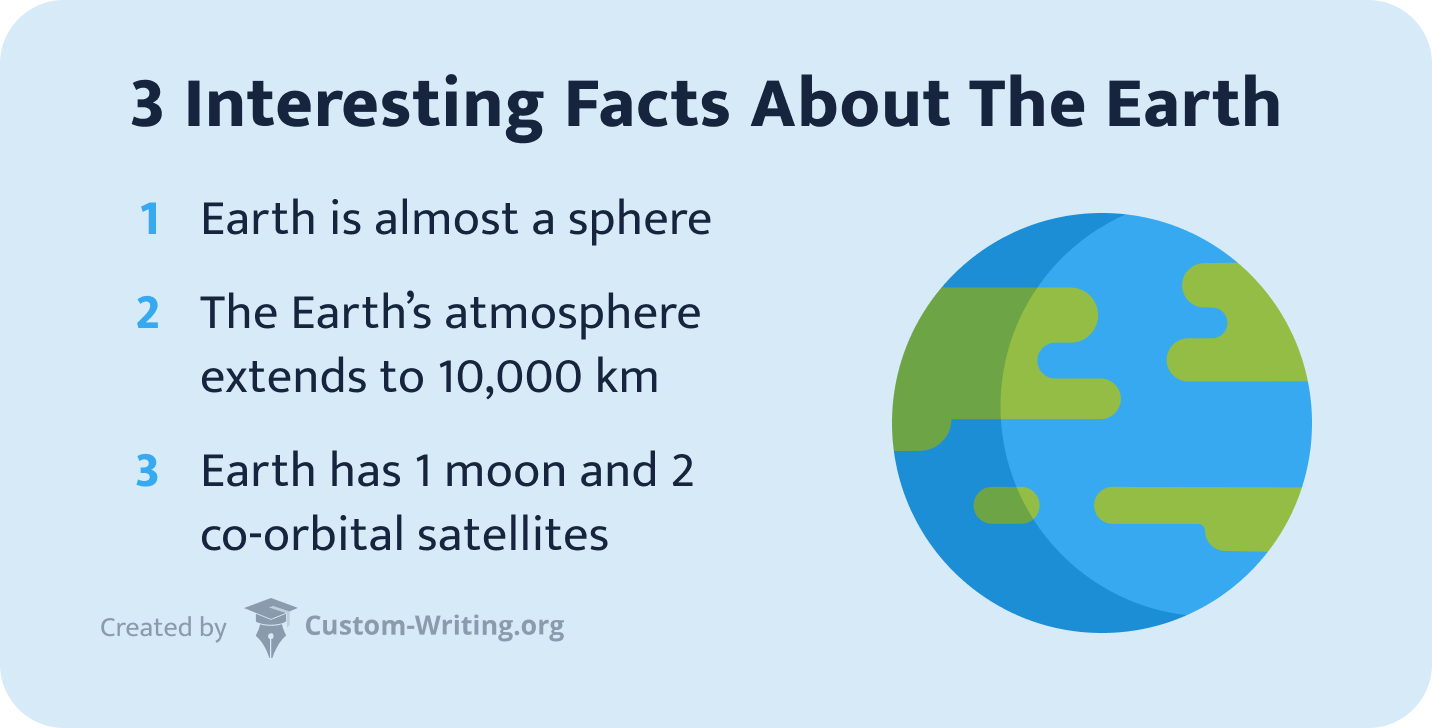
In the area of geology, you can usually find quite easy scientific research topics. However, keep in mind that you might have to go out to the field and get muddy while doing most of your research.
We prepared an excellent list of geology research topics that can be useful for students with a major in geology who are working on their thesis.
🔷 45 Geology Research Topics
- How can analyzing seismic waves help understand the nature of earthquakes?
- The main differences in studies in geology and astrogeology
- What are the biggest challenges of applying geology principles to astrogeology?
- How can the compression of wet sand be helpful in the construction field?
- Glaciers melting and geological misconceptions
- Environmental geology: the main methods of identifying the location of volcanic hazards
- How did people adapt to living in geologically hazardous locations?
- Formation and weathering of rocks
- Weathering and erosion geology: when rocks turn into dust
- What is the relationship between natural hazards and marine geology?
- Marine geology: the importance of investigating the seafloor spreading
- Coastal geology: hydraulic action and the influence of the types of rock on it
- Landscape and the changes that it goes through
- The dynamics of the Earth’s surface: the landscape-changing power of glaciers
- Woodbury unique geological features
- What forces below the surface make the Earth’s crust tilted?
- The most stable building designs to survive earthquakes in Japan
- Earthquakes: history and studies
- The main methods to prevent the soil liquefaction
- Avalanches, their nature and safety precautions
- Saturated soil: what influences the transfer of force?
- What role does the soil type play in conserving cast fossils?
- Pros and cons of fluorite as a gemstone
- The specifics of the conditions under which fossils are created
- The correlation between the geological features and the location of coal reserves
- The methods of mapping Earth’s magnetic fields patterns
- How does water flow affect the environment?
- Floods: stages, types, effects, and prevention
- What is the role of soil in the Earth’s nitrogen biogeochemical cycle?
- How does the pH level of water react to alkaline soil?
- The latest technologies in measuring the speed of seismic waves
- The process of radioisotope dating to find out the age of rocks
- The development of the seismograph
- The stages of the process of the geodes creation?
- What geophysical conditions affect the growth of geodes?
- The most effective methods of predicting landslides
- What purposes is lichenometry dating used for?
- The role of structural geology in gold mines development
- Darcy’s Law and its relationship with the underwater flows
- The forces that influence sedimentation: electromagnetism
- Hematite matter and mineral
- The soil structure and type vs. earthquakes: a comparative analysis
- What are the main tools used in sedimentology nowadays?
- Mountains: what forces can cause a change in the shape?
- The methods of sustainable coal mining: geological perception
🤓 Physics Research
Once again – a scientific subject that studies how our world works. However, just like other branches, it has its own specifics. Even though physics usually seems complicated, we gathered only simple science research topics for you!
Physics research might require a profound knowledge of the four fundamental concepts of physics. However, the good news is that this is the area where it is easy to find many qualitative and quantitative research topics about science.
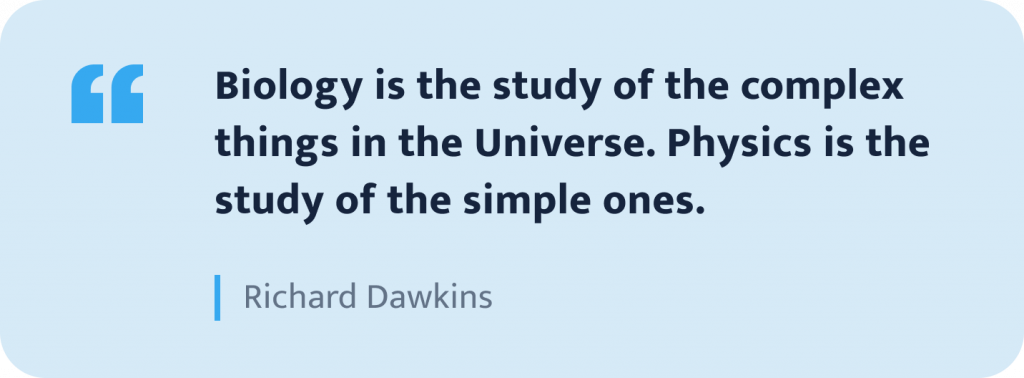
Also, research is mostly based on conducting experiments, but most physics research topics in our list concern theoretical issues. Any of the ideas here can be used for your paper, so hurry up and look through all of them!
🌈 73 Physics Research Topics
- The unexpected uses of a magnifying glass in everyday life
- Why do different colors absorb radiant energy differently?
- How is balloon buoyancy used to launch satellites?
- How does the spinning affect the trajectory of the baseball ball?
- Frequency response : the usage of the 3dB bandwidth
- How is the frequency response of the speakers measured?
- The physics behind the retro-reflective strips
- The most effective material used for the retro-reflective strips
- Fluorescent yellow clothing vs. retro-reflective strips: what is safer to wear in the night?
- Magnetic levitation train: advantages and disadvantages
- The comparative analysis of the safety of the Japanese magnetic levitation train
- Why can’t the gauss rifle be used as a real firearm?
- Technologies inspired by the water strider that use surface tension
- What is the connection between the vacuum and sound intensity?
- Friction physics: the secret behind the inseparable interleaved books
- The important role of centripetal force that keeps tornado going
- The physics of the balance: how to find a balance point?
- Will it be possible to use a radiometer to produce electricity in the future?
- Radiometer: the power of light intensity that affects the speed
- Animals that use the acceleration of gravity for their benefit
- Falling object acceleration: the correlation between distance and time
- What is the role of gravity in the speed of the rolling object?
- How important is the hang time of the ball in soccer?
- The physics that help forensic science analyze blood patterns
- Acoustic absorption: what types of foam are the most effective?
- The acoustic foam and different sound frequency
- Magnetic induction and the future of wireless charging
- The physics behind the yo-yo sleep time: string length matters
- How does the temperature influence a magnet?
- Projectile motion and basketball: dunk explained
- Granular materials and why they flow like liquids
- Why does the conversion between potential energy and kinetic energy work both ways?
- Augmented reality glasses and refractive index
- Tumbling: where is it used for separating granular materials?
- How did we come up with hula-hoop, and how does it work?
- The conditions that affect the rebound height
- Why is it not possible to predict radioactive decay?
- The light effect that helps understand the atomic composition of stars
- Ice skating : how does temperature affect the friction?
- Variations in the motor: how to boost the rocket’s performance?
- What is the interaction between magnetic and ferromagnetic materials?
- What type of stealth technology is more effective?
- Stealth technology: the shape that interferes the radar signals
- Finding the optimal number of magnetic breaks for a magnetic levitation train
- How can the phenomenon of supercooling be used for storing transplant organs?
- James Webb Space Telescope: the important role of solar shields
- How does temperature affect the level of the background radiation?
- Plasma physics: can controlled fusion be a source of electricity?
- Quantum theory and atomic clocks: the secret of precision
- The current trends of engineering physics: photovoltaics
- Econophysics: where economic problems are solved by physics
- Where can the nanoscale materials be applied?
- The properties of condensed-matter: a qualitative analysis
- Isaac Newton: scientific contributions
- Optical sensors: the benefits of the superconducting quantum devices
- Thermoelectric: the future of sustainable sources of energy
- Teleportation: physics of the impossible
- What are the best materials for photovoltaics?
- Biophysics: what tools are used to study macromolecules?
- The Paradoxical effects of time travel
- How is the study of microfluidics applied in agriculture?
- The newest fluid control techniques in micro fluid devices
- The application of the properties of the particles of light
- What do we lack to build a space elevator?
- How effective is laser cleaning from the perspective of archeology?
- Astrophysics: the biggest issues with moving quasars
- Can remote sensing be used to warn people with asthmatic problems?
- Where can electron beam welding be applied?
- How can physics help develop methods to close the ozone hole ?
- Solar cells: silicon for the increased efficiency
- What parts of the universe are not on the electromagnetic spectrum?
- What are the causes of the heat death of the universe?
- The connection between elusive particles and antiparticles
🔝 Top 20 Big Science Research Questions
- What are other possible ways of using our Sun as the source of energy ? It is definitely not an easy one, but among all science research ideas, it is the most promising. For instance, a nuclear fusion machine might be able to produce enough energy for everybody!
- Can we get rid of all the carbon dioxide? Since we were releasing it by burning fuels, we need to think about how to hide it back as well. And we have to solve this issue before climate change causes catastrophic damage.
- Is there a possibility of the other universes’ existence? Of course, our universe is unique, but it seems like scientists are getting more and more excited about the idea of a “ multiverse .”
- Why are there uneven parts of matter and antimatter? A mind-blowing question which should not belong to the list of simple science research topics, just as we shouldn’t belong here! But why are we still here when there is antimatter?
- What role does dreaming play? It might be a great question to create your own theory for a biology or psychology project. Most people had wondered why they were dreaming. What if dreams are essential for normal brain development?
- How can the nature of consciousness be explained? No one even knows what consciousness is in the first place… But we do know that computers have not become conscious… yet.
- How do we prove that we are humans? Only 1% of the genome is what makes us different from a chimpanzee. So what qualities make us rule this world?
- Are there other life forms in the universe? Some qualitative research topics about science may be leading to the answer. Now scientists have the tools to find habitable planets.
- What caused the creation of life? Some chemicals in the primordial soup made love and created the first life on our planet. But how did it happen?
- What is the composition of the universe? So, lets’ see… We only know 5% percent of what everything is made of. Dark energy was only discovered 22 years ago!
- Will people be able to time travel? Astronauts are real time-travelers since the time on the International Space Station is slower. We’ll see if we can actually travel thousands of years in the future one day.
- How can we manage the growing population needs ? The population of people is growing each year, and our demands are growing too. However, it might not be as easy as we think. Countries might have to join their forces to battle this issue!
- Can we stop aging? We grow old and die, but the Vedas, Indian religious texts, say that we don’t have to. The state of perfect health may be maintained indefinitely. However, science has little to comment on it.
- Where is the lowest point of the black hole? Unfortunately, scientists don’t even have the proper tools to check it. Therefore, the answer is only different theories on paper.
- What is on the ocean floor? The bottom of the ocean is as unknown as outer space. 95% about it is unveiled. For now, we can only send drones to the deepest parts, but it’s not nearly enough to understand everything…
- When will robots be available as servants? Robots can already do many tasks, like serving drinks and even milking cows. The only question is when they will be functional enough to be personal assistants?
- Will it be possible to cure cancer ? One day it may be possible but not in the foreseeable future for sure… Is it easier to change our lifestyles and prevent cancer than treat it later?
- How fast can computers become? We have been witnessing the continuous development of computers. But how much faster can they become in the future?
- What are the ways to kill bacteria? Drug-resistant bacteria are a big threat, and the common antibiotic is not enough. Scientists are working on discovering new antibiotics.
- How to solve the mystery of the prime numbers? Prime numbers are widely used for encryption, thanks to their weirdness. But don’t rush to solve this mystery, we don’t know if the internet will remain safe after that!
Learn more on this topic:
- 280 Good Nursing Research Topics & Questions
- 226 Research Topics on Criminal Justice & Criminology
- 204 Research Topics on Technology & Computer Science
- 178 Best Research Titles about Cookery & Food
- 497 Interesting History Topics to Research
- 180 Best Education Research Topics & Ideas
- 110+ Micro- & Macroeconomics Research Topics
- 417 Business Research Topics for ABM Students
- 190+ Research Topics on Psychology & Communication
- 512 Research Topics on HumSS
- 281 Best Health & Medical Research Topics
- A List of Research Topics for Students. Unique and Interesting
- Good Research Topics, Titles and Ideas for Your Paper
- Databases for Research & Education: Gale
- Research Topics: Cornell Engineering
- Research Topics: School of Natural Resources & Environment, University of Arizona
- Research Areas: Stanford Chemistry
- Areas of research: Department of Chemistry, University of Minnesota
- Areas of Research: Department of Biological Sciences, University of Notre Dame
- Areas of Research: MIT Biology
- CCAPS Research Areas: Cornell
- Research Topics: Institute of Astronomy, KU LEUVEN
- List of Science Fair Project Ideas: Science Buddies
- Short Chemistry Topics: Science
- Choosing a research topic: Murdoch University
- Choosing a Topic: Purdue OWL
- How do I choose a research topic? UW Madison Libraries
- Space Science and Astrobiology Division: NASA
- Center fos Space Research: The University of Texas at Austin
- Biology Research Areas: Duke
- Research Areas: Department of Molecular Biology, Princeton University
- Research areas: Department of Biology, University of Waterloo
- 2019’s Most Important Chemistry Research Topics: ASC Axial
- Description of Research Areas: Department of Chemistry, University of Washington
- Research Areas: Yale Department of Chemistry
- Ecology: Nature
- Ecology Research News: ScienceDaily
- Environmental Research: Elsevier
- Articles on Geology: The Conversation
- Geology: Academia
- Share to Facebook
- Share to Twitter
- Share to LinkedIn
- Share to email
![sample research title about life science Research Proposal Topics: 503 Ideas, Sample, & Guide [2024]](https://custom-writing.org/blog/wp-content/uploads/2021/01/woman-making-notes-284x153.jpg)
Do you have to write a research proposal and can’t choose one from the professor’s list? This article may be exactly what you need. We will provide you with the most up-to-date undergraduate and postgraduate topic ideas. Moreover, we will share the secrets of the winning research proposal writing. Here,...

A history class can become a jumble of years, dates, odd moments, and names of people who have been dead for centuries. Despite this, you’ll still need to find history topics to write about. You may have no choice! But once in a while, your instructor may let you pick...
![sample research title about life science 150 Argumentative Research Paper Topics [2024 Upd.]](https://custom-writing.org/blog/wp-content/uploads/2021/01/close-up-magnifier-glass-yellow-background-284x153.jpg)
Argumentative research paper topics are a lot easier to find than to come up with. We always try to make your life easier. That’s why you should feel free to check out this list of the hottest and most controversial argumentative essay topics for 2024. In the article prepared by...

One of the greatest problems of the scholarly world is the lack of funny topics. So why not jazz it up? How about creating one of those humorous speeches the public is always so delighted to listen to? Making a couple of funny informative speech topics or coming up with...
![sample research title about life science Gun Control Argumentative Essay: 160 Topics + How-to Guide [2024]](https://custom-writing.org/blog/wp-content/uploads/2021/01/bullets-gun-black-velvet-desk-284x153.jpg)
After the recent heartbreaking mass shootings, the gun control debate has reached its boiling point. Do we need stricter gun control laws? Should everyone get a weapon to oppose crime? Or should guns be banned overall? You have the opportunity to air your opinion in a gun control argumentative essay....
![sample research title about life science Best Childhood Memories Essay Ideas: 94 Narrative Topics [2024]](https://custom-writing.org/blog/wp-content/uploads/2021/01/child-working-in-cambodia-284x153.jpg)
Many people believe that childhood is the happiest period in a person’s life. It’s not hard to see why. Kids have nothing to care or worry about, have almost no duties or problems, and can hang out with their friends all day long. An essay about childhood gives an opportunity...
![sample research title about life science A List of 272 Informative Speech Topics: Pick Only Awesome Ideas! [2024]](https://custom-writing.org/blog/wp-content/uploads/2021/01/meeting-room-professional-meeting-284x153.jpg)
Just when you think you’re way past the question “How to write an essay?” another one comes. That’s the thing students desperately Google: “What is an informative speech?” And our custom writing experts are here to help you sort this out. Informative speaking is a speech on a completely new issue....
![sample research title about life science 435 Literary Analysis Essay Topics and Prompts [2024 Upd]](https://custom-writing.org/blog/wp-content/uploads/2021/01/girl-having-idea-with-copy-space-284x153.jpg)
Literature courses are about two things: reading and writing about what you’ve read. For most students, it’s hard enough to understand great pieces of literature, never mind analyzing them. And with so many books and stories out there, choosing one to write about can be a chore. But you’re in...
![sample research title about life science 335 Unique Essay Topics for College Students [2024 Update]](https://custom-writing.org/blog/wp-content/uploads/2021/01/smiling-students-walking-after-lessons1-284x153.jpg)
The success of any college essay depends on the topic choice. If you want to impress your instructors, your essay needs to be interesting and unique. Don’t know what to write about? We are here to help you! In this article by our Custom-Writing.org team, you will find 335 interesting...

Social studies is an integrated research field. It includes a range of topics on social science and humanities, such as history, culture, geography, sociology, education, etc. A social studies essay might be assigned to any middle school, high school, or college student. It might seem like a daunting task, but...

If you are about to go into the world of graduate school, then one of the first things you need to do is choose from all the possible dissertation topics available to you. This is no small task. You are likely to spend many years researching your Master’s or Ph.D....

Looking for a good argumentative essay topic? In need of a persuasive idea for a research paper? You’ve found the right page! Academic writing is never easy, whether it is for middle school or college. That’s why there are numerous educational materials on composing an argumentative and persuasive essay, for...
Great lists, thanks for sharing such nice titles.
- Privacy Policy

Home » 500+ Quantitative Research Titles and Topics
500+ Quantitative Research Titles and Topics
Table of Contents

Quantitative research involves collecting and analyzing numerical data to identify patterns, trends, and relationships among variables. This method is widely used in social sciences, psychology , economics , and other fields where researchers aim to understand human behavior and phenomena through statistical analysis. If you are looking for a quantitative research topic, there are numerous areas to explore, from analyzing data on a specific population to studying the effects of a particular intervention or treatment. In this post, we will provide some ideas for quantitative research topics that may inspire you and help you narrow down your interests.
Quantitative Research Titles
Quantitative Research Titles are as follows:
Business and Economics
- “Statistical Analysis of Supply Chain Disruptions on Retail Sales”
- “Quantitative Examination of Consumer Loyalty Programs in the Fast Food Industry”
- “Predicting Stock Market Trends Using Machine Learning Algorithms”
- “Influence of Workplace Environment on Employee Productivity: A Quantitative Study”
- “Impact of Economic Policies on Small Businesses: A Regression Analysis”
- “Customer Satisfaction and Profit Margins: A Quantitative Correlation Study”
- “Analyzing the Role of Marketing in Brand Recognition: A Statistical Overview”
- “Quantitative Effects of Corporate Social Responsibility on Consumer Trust”
- “Price Elasticity of Demand for Luxury Goods: A Case Study”
- “The Relationship Between Fiscal Policy and Inflation Rates: A Time-Series Analysis”
- “Factors Influencing E-commerce Conversion Rates: A Quantitative Exploration”
- “Examining the Correlation Between Interest Rates and Consumer Spending”
- “Standardized Testing and Academic Performance: A Quantitative Evaluation”
- “Teaching Strategies and Student Learning Outcomes in Secondary Schools: A Quantitative Study”
- “The Relationship Between Extracurricular Activities and Academic Success”
- “Influence of Parental Involvement on Children’s Educational Achievements”
- “Digital Literacy in Primary Schools: A Quantitative Assessment”
- “Learning Outcomes in Blended vs. Traditional Classrooms: A Comparative Analysis”
- “Correlation Between Teacher Experience and Student Success Rates”
- “Analyzing the Impact of Classroom Technology on Reading Comprehension”
- “Gender Differences in STEM Fields: A Quantitative Analysis of Enrollment Data”
- “The Relationship Between Homework Load and Academic Burnout”
- “Assessment of Special Education Programs in Public Schools”
- “Role of Peer Tutoring in Improving Academic Performance: A Quantitative Study”
Medicine and Health Sciences
- “The Impact of Sleep Duration on Cardiovascular Health: A Cross-sectional Study”
- “Analyzing the Efficacy of Various Antidepressants: A Meta-Analysis”
- “Patient Satisfaction in Telehealth Services: A Quantitative Assessment”
- “Dietary Habits and Incidence of Heart Disease: A Quantitative Review”
- “Correlations Between Stress Levels and Immune System Functioning”
- “Smoking and Lung Function: A Quantitative Analysis”
- “Influence of Physical Activity on Mental Health in Older Adults”
- “Antibiotic Resistance Patterns in Community Hospitals: A Quantitative Study”
- “The Efficacy of Vaccination Programs in Controlling Disease Spread: A Time-Series Analysis”
- “Role of Social Determinants in Health Outcomes: A Quantitative Exploration”
- “Impact of Hospital Design on Patient Recovery Rates”
- “Quantitative Analysis of Dietary Choices and Obesity Rates in Children”
Social Sciences
- “Examining Social Inequality through Wage Distribution: A Quantitative Study”
- “Impact of Parental Divorce on Child Development: A Longitudinal Study”
- “Social Media and its Effect on Political Polarization: A Quantitative Analysis”
- “The Relationship Between Religion and Social Attitudes: A Statistical Overview”
- “Influence of Socioeconomic Status on Educational Achievement”
- “Quantifying the Effects of Community Programs on Crime Reduction”
- “Public Opinion and Immigration Policies: A Quantitative Exploration”
- “Analyzing the Gender Representation in Political Offices: A Quantitative Study”
- “Impact of Mass Media on Public Opinion: A Regression Analysis”
- “Influence of Urban Design on Social Interactions in Communities”
- “The Role of Social Support in Mental Health Outcomes: A Quantitative Analysis”
- “Examining the Relationship Between Substance Abuse and Employment Status”
Engineering and Technology
- “Performance Evaluation of Different Machine Learning Algorithms in Autonomous Vehicles”
- “Material Science: A Quantitative Analysis of Stress-Strain Properties in Various Alloys”
- “Impacts of Data Center Cooling Solutions on Energy Consumption”
- “Analyzing the Reliability of Renewable Energy Sources in Grid Management”
- “Optimization of 5G Network Performance: A Quantitative Assessment”
- “Quantifying the Effects of Aerodynamics on Fuel Efficiency in Commercial Airplanes”
- “The Relationship Between Software Complexity and Bug Frequency”
- “Machine Learning in Predictive Maintenance: A Quantitative Analysis”
- “Wearable Technologies and their Impact on Healthcare Monitoring”
- “Quantitative Assessment of Cybersecurity Measures in Financial Institutions”
- “Analysis of Noise Pollution from Urban Transportation Systems”
- “The Influence of Architectural Design on Energy Efficiency in Buildings”
Quantitative Research Topics
Quantitative Research Topics are as follows:
- The effects of social media on self-esteem among teenagers.
- A comparative study of academic achievement among students of single-sex and co-educational schools.
- The impact of gender on leadership styles in the workplace.
- The correlation between parental involvement and academic performance of students.
- The effect of mindfulness meditation on stress levels in college students.
- The relationship between employee motivation and job satisfaction.
- The effectiveness of online learning compared to traditional classroom learning.
- The correlation between sleep duration and academic performance among college students.
- The impact of exercise on mental health among adults.
- The relationship between social support and psychological well-being among cancer patients.
- The effect of caffeine consumption on sleep quality.
- A comparative study of the effectiveness of cognitive-behavioral therapy and pharmacotherapy in treating depression.
- The relationship between physical attractiveness and job opportunities.
- The correlation between smartphone addiction and academic performance among high school students.
- The impact of music on memory recall among adults.
- The effectiveness of parental control software in limiting children’s online activity.
- The relationship between social media use and body image dissatisfaction among young adults.
- The correlation between academic achievement and parental involvement among minority students.
- The impact of early childhood education on academic performance in later years.
- The effectiveness of employee training and development programs in improving organizational performance.
- The relationship between socioeconomic status and access to healthcare services.
- The correlation between social support and academic achievement among college students.
- The impact of technology on communication skills among children.
- The effectiveness of mindfulness-based stress reduction programs in reducing symptoms of anxiety and depression.
- The relationship between employee turnover and organizational culture.
- The correlation between job satisfaction and employee engagement.
- The impact of video game violence on aggressive behavior among children.
- The effectiveness of nutritional education in promoting healthy eating habits among adolescents.
- The relationship between bullying and academic performance among middle school students.
- The correlation between teacher expectations and student achievement.
- The impact of gender stereotypes on career choices among high school students.
- The effectiveness of anger management programs in reducing violent behavior.
- The relationship between social support and recovery from substance abuse.
- The correlation between parent-child communication and adolescent drug use.
- The impact of technology on family relationships.
- The effectiveness of smoking cessation programs in promoting long-term abstinence.
- The relationship between personality traits and academic achievement.
- The correlation between stress and job performance among healthcare professionals.
- The impact of online privacy concerns on social media use.
- The effectiveness of cognitive-behavioral therapy in treating anxiety disorders.
- The relationship between teacher feedback and student motivation.
- The correlation between physical activity and academic performance among elementary school students.
- The impact of parental divorce on academic achievement among children.
- The effectiveness of diversity training in improving workplace relationships.
- The relationship between childhood trauma and adult mental health.
- The correlation between parental involvement and substance abuse among adolescents.
- The impact of social media use on romantic relationships among young adults.
- The effectiveness of assertiveness training in improving communication skills.
- The relationship between parental expectations and academic achievement among high school students.
- The correlation between sleep quality and mood among adults.
- The impact of video game addiction on academic performance among college students.
- The effectiveness of group therapy in treating eating disorders.
- The relationship between job stress and job performance among teachers.
- The correlation between mindfulness and emotional regulation.
- The impact of social media use on self-esteem among college students.
- The effectiveness of parent-teacher communication in promoting academic achievement among elementary school students.
- The impact of renewable energy policies on carbon emissions
- The relationship between employee motivation and job performance
- The effectiveness of psychotherapy in treating eating disorders
- The correlation between physical activity and cognitive function in older adults
- The effect of childhood poverty on adult health outcomes
- The impact of urbanization on biodiversity conservation
- The relationship between work-life balance and employee job satisfaction
- The effectiveness of eye movement desensitization and reprocessing (EMDR) in treating trauma
- The correlation between parenting styles and child behavior
- The effect of social media on political polarization
- The impact of foreign aid on economic development
- The relationship between workplace diversity and organizational performance
- The effectiveness of dialectical behavior therapy in treating borderline personality disorder
- The correlation between childhood abuse and adult mental health outcomes
- The effect of sleep deprivation on cognitive function
- The impact of trade policies on international trade and economic growth
- The relationship between employee engagement and organizational commitment
- The effectiveness of cognitive therapy in treating postpartum depression
- The correlation between family meals and child obesity rates
- The effect of parental involvement in sports on child athletic performance
- The impact of social entrepreneurship on sustainable development
- The relationship between emotional labor and job burnout
- The effectiveness of art therapy in treating dementia
- The correlation between social media use and academic procrastination
- The effect of poverty on childhood educational attainment
- The impact of urban green spaces on mental health
- The relationship between job insecurity and employee well-being
- The effectiveness of virtual reality exposure therapy in treating anxiety disorders
- The correlation between childhood trauma and substance abuse
- The effect of screen time on children’s social skills
- The impact of trade unions on employee job satisfaction
- The relationship between cultural intelligence and cross-cultural communication
- The effectiveness of acceptance and commitment therapy in treating chronic pain
- The correlation between childhood obesity and adult health outcomes
- The effect of gender diversity on corporate performance
- The impact of environmental regulations on industry competitiveness.
- The impact of renewable energy policies on greenhouse gas emissions
- The relationship between workplace diversity and team performance
- The effectiveness of group therapy in treating substance abuse
- The correlation between parental involvement and social skills in early childhood
- The effect of technology use on sleep patterns
- The impact of government regulations on small business growth
- The relationship between job satisfaction and employee turnover
- The effectiveness of virtual reality therapy in treating anxiety disorders
- The correlation between parental involvement and academic motivation in adolescents
- The effect of social media on political engagement
- The impact of urbanization on mental health
- The relationship between corporate social responsibility and consumer trust
- The correlation between early childhood education and social-emotional development
- The effect of screen time on cognitive development in young children
- The impact of trade policies on global economic growth
- The relationship between workplace diversity and innovation
- The effectiveness of family therapy in treating eating disorders
- The correlation between parental involvement and college persistence
- The effect of social media on body image and self-esteem
- The impact of environmental regulations on business competitiveness
- The relationship between job autonomy and job satisfaction
- The effectiveness of virtual reality therapy in treating phobias
- The correlation between parental involvement and academic achievement in college
- The effect of social media on sleep quality
- The impact of immigration policies on social integration
- The relationship between workplace diversity and employee well-being
- The effectiveness of psychodynamic therapy in treating personality disorders
- The correlation between early childhood education and executive function skills
- The effect of parental involvement on STEM education outcomes
- The impact of trade policies on domestic employment rates
- The relationship between job insecurity and mental health
- The effectiveness of exposure therapy in treating PTSD
- The correlation between parental involvement and social mobility
- The effect of social media on intergroup relations
- The impact of urbanization on air pollution and respiratory health.
- The relationship between emotional intelligence and leadership effectiveness
- The effectiveness of cognitive-behavioral therapy in treating depression
- The correlation between early childhood education and language development
- The effect of parental involvement on academic achievement in STEM fields
- The impact of trade policies on income inequality
- The relationship between workplace diversity and customer satisfaction
- The effectiveness of mindfulness-based therapy in treating anxiety disorders
- The correlation between parental involvement and civic engagement in adolescents
- The effect of social media on mental health among teenagers
- The impact of public transportation policies on traffic congestion
- The relationship between job stress and job performance
- The effectiveness of group therapy in treating depression
- The correlation between early childhood education and cognitive development
- The effect of parental involvement on academic motivation in college
- The impact of environmental regulations on energy consumption
- The relationship between workplace diversity and employee engagement
- The effectiveness of art therapy in treating PTSD
- The correlation between parental involvement and academic success in vocational education
- The effect of social media on academic achievement in college
- The impact of tax policies on economic growth
- The relationship between job flexibility and work-life balance
- The effectiveness of acceptance and commitment therapy in treating anxiety disorders
- The correlation between early childhood education and social competence
- The effect of parental involvement on career readiness in high school
- The impact of immigration policies on crime rates
- The relationship between workplace diversity and employee retention
- The effectiveness of play therapy in treating trauma
- The correlation between parental involvement and academic success in online learning
- The effect of social media on body dissatisfaction among women
- The impact of urbanization on public health infrastructure
- The relationship between job satisfaction and job performance
- The effectiveness of eye movement desensitization and reprocessing therapy in treating PTSD
- The correlation between early childhood education and social skills in adolescence
- The effect of parental involvement on academic achievement in the arts
- The impact of trade policies on foreign investment
- The relationship between workplace diversity and decision-making
- The effectiveness of exposure and response prevention therapy in treating OCD
- The correlation between parental involvement and academic success in special education
- The impact of zoning laws on affordable housing
- The relationship between job design and employee motivation
- The effectiveness of cognitive rehabilitation therapy in treating traumatic brain injury
- The correlation between early childhood education and social-emotional learning
- The effect of parental involvement on academic achievement in foreign language learning
- The impact of trade policies on the environment
- The relationship between workplace diversity and creativity
- The effectiveness of emotion-focused therapy in treating relationship problems
- The correlation between parental involvement and academic success in music education
- The effect of social media on interpersonal communication skills
- The impact of public health campaigns on health behaviors
- The relationship between job resources and job stress
- The effectiveness of equine therapy in treating substance abuse
- The correlation between early childhood education and self-regulation
- The effect of parental involvement on academic achievement in physical education
- The impact of immigration policies on cultural assimilation
- The relationship between workplace diversity and conflict resolution
- The effectiveness of schema therapy in treating personality disorders
- The correlation between parental involvement and academic success in career and technical education
- The effect of social media on trust in government institutions
- The impact of urbanization on public transportation systems
- The relationship between job demands and job stress
- The correlation between early childhood education and executive functioning
- The effect of parental involvement on academic achievement in computer science
- The effectiveness of cognitive processing therapy in treating PTSD
- The correlation between parental involvement and academic success in homeschooling
- The effect of social media on cyberbullying behavior
- The impact of urbanization on air quality
- The effectiveness of dance therapy in treating anxiety disorders
- The correlation between early childhood education and math achievement
- The effect of parental involvement on academic achievement in health education
- The impact of global warming on agriculture
- The effectiveness of narrative therapy in treating depression
- The correlation between parental involvement and academic success in character education
- The effect of social media on political participation
- The impact of technology on job displacement
- The relationship between job resources and job satisfaction
- The effectiveness of art therapy in treating addiction
- The correlation between early childhood education and reading comprehension
- The effect of parental involvement on academic achievement in environmental education
- The impact of income inequality on social mobility
- The relationship between workplace diversity and organizational culture
- The effectiveness of solution-focused brief therapy in treating anxiety disorders
- The correlation between parental involvement and academic success in physical therapy education
- The effect of social media on misinformation
- The impact of green energy policies on economic growth
- The relationship between job demands and employee well-being
- The correlation between early childhood education and science achievement
- The effect of parental involvement on academic achievement in religious education
- The impact of gender diversity on corporate governance
- The relationship between workplace diversity and ethical decision-making
- The correlation between parental involvement and academic success in dental hygiene education
- The effect of social media on self-esteem among adolescents
- The impact of renewable energy policies on energy security
- The effect of parental involvement on academic achievement in social studies
- The impact of trade policies on job growth
- The relationship between workplace diversity and leadership styles
- The correlation between parental involvement and academic success in online vocational training
- The effect of social media on self-esteem among men
- The impact of urbanization on air pollution levels
- The effectiveness of music therapy in treating depression
- The correlation between early childhood education and math skills
- The effect of parental involvement on academic achievement in language arts
- The impact of immigration policies on labor market outcomes
- The effectiveness of hypnotherapy in treating phobias
- The effect of social media on political engagement among young adults
- The impact of urbanization on access to green spaces
- The relationship between job crafting and job satisfaction
- The effectiveness of exposure therapy in treating specific phobias
- The correlation between early childhood education and spatial reasoning
- The effect of parental involvement on academic achievement in business education
- The impact of trade policies on economic inequality
- The effectiveness of narrative therapy in treating PTSD
- The correlation between parental involvement and academic success in nursing education
- The effect of social media on sleep quality among adolescents
- The impact of urbanization on crime rates
- The relationship between job insecurity and turnover intentions
- The effectiveness of pet therapy in treating anxiety disorders
- The correlation between early childhood education and STEM skills
- The effect of parental involvement on academic achievement in culinary education
- The impact of immigration policies on housing affordability
- The relationship between workplace diversity and employee satisfaction
- The effectiveness of mindfulness-based stress reduction in treating chronic pain
- The correlation between parental involvement and academic success in art education
- The effect of social media on academic procrastination among college students
- The impact of urbanization on public safety services.
About the author
Muhammad Hassan
Researcher, Academic Writer, Web developer
You may also like

200+ Funny Research Topics

500+ Sports Research Topics

300+ American History Research Paper Topics

500+ Cyber Security Research Topics

500+ Environmental Research Topics

500+ Economics Research Topics
Frontiers | Science News
- Science News
Research Topics
Five research topics exploring the science of mental health.

Mental wellbeing is increasingly recognized as an essential aspect of our overall health. It supports our ability to handle challenges, build strong relationships, and live more fulfilling lives. The World Health Organization (WHO) emphasizes the importance of mental health by acknowledging it as a fundamental human right.
This Mental Health Awareness Week, we highlight the remarkable work of scientists driving open research that helps everyone achieve better mental health.
Here are five Research Topics that study themes including how we adapt to a changing world, the impact of loneliness on our wellbeing, and the connection between our diet and mental health.
All articles are openly available to view and download.
1 | Community Series in Mental Health Promotion and Protection, volume II
40.300 views | 16 articles
There is no health without mental health. Thus, this Research Topic collects ideas and research related to strategies that promote mental health across all disciplines. The goal is to raise awareness about mental health promotion and protection to ensure its incorporation in national mental health policies.
This topic is of relevance given the mental health crisis being experienced across the world right now. A reality that has prompted the WHO to declare that health is a state of complete physical, mental, and social wellbeing.
View Research Topic
2 | Dietary and Metabolic Approaches for Mental Health Conditions
176.800 views | 11 articles
There is increased recognition that mental health disorders are, at least in part, a form of diet-related disease. For this reason, we focus attention on a Research Topic that examines the mechanistic interplay between dietary patterns and mental health conditions.
There is a clear consensus that the quality, quantity, and even timing of our human feeding patterns directly impact how brains function. But despite the epidemiological and mechanistic links between mental health and diet-related diseases, these two are often perceived as separate medical issues.
Even more urgent, public health messaging and clinical treatments for mental health conditions place relatively little emphasis on formulating nutrition to ease the underlying drivers of mental health conditions.
3 | Comparing Mental Health Cross-Culturally
94.000 views | 15 articles
Although mental health has been widely discussed in later years, how mental health is perceived across different cultures remains to be examined. This Research Topic addresses this gap and deepens our knowledge of mental health by comparing positive and negative psychological constructs cross-culturally.
The definition and understanding of mental health remain to be refined, partially because of a lack of cross-cultural perspectives on mental health. Also, due to the rapid internationalization taking place in the world today, a culturally aware understanding of, and interventions for mental health problems are essential.
4 | Adaption to Change and Coping Strategies: New Resources for Mental Health
85.000 views | 29 articles
In this Research Topic, scientists study a wider range of variables involved in change and adaptation. They examine changes of any type or magnitude whenever the lack of adaptive response diminishes our development and well-being.
Today’s society is characterized by change, and sometimes, the constant changes are difficult to assimilate. This may be why feelings of frustration and defenselessness appear in the face of the impossibility of responding adequately to the requirements of a changing society.
Therefore, society must develop an updated notion of the processes inherent to changing developmental environments, personal skills, resources, and strategies. This know-how is crucial for achieving and maintaining balanced mental health.
5 | Mental Health Equity
29.900 views | 10 articles
The goal of this Research Topic is to move beyond a synthesis of what is already known about mental health in the context of health equity. Rather, the focus here is on transformative solutions, recommendations, and applied research that have real world implications on policy, practice, and future scholarship.
Attention in the field to upstream factors and the role of social and structural determinants of health in influencing health outcomes, combined with an influx of innovation –particularly the digitalization of healthcare—presents a unique opportunity to solve pressing issues in mental health through a health equity lens.
The topic is opportune because factors such as structural racism and climate change have disproportionately negatively impacted marginalized communities across the world, including Black, Indigenous, People of Color (BIPOC), LGBTQ+, people with disabilities, and transition-age youth and young adults. As a result, existing disparities in mental health have exacerbated.
Post related info
May 13, 2024
Frontiers Science Communications
Post categories, featured news, related subjects, research topics, related content.

Opening health for all: 7 Research Topics shaping a healthier world

Frontiers' Research Topic publishing program: pioneering the future of scientific publishing

Frontiers institutional partnerships update – winter 2024
Latest posts.

A devastating fire 2,200 years ago preserved a moment of life and war in Iron Age Spain — right down to a single gold earring

Mariana Fuentes - Changing the currency of conservation

Frontiers institutional partnerships update – spring 2024

Villars Institute Summit 2024: Catalyzing systematic change through interdisciplinary cooperation
The health benefits and business potential of digital therapeutics
Around the world, the burden of chronic disease is increasing at a rapid pace. Unfortunately, most of these conditions are irreversible and need to be managed through lifelong medication use. However, many patients struggle with adhering to prescribed medications and implementing the behavioral and lifestyle changes that are needed to manage their diseases and stabilize their conditions. Often, physicians and other healthcare providers have little ability to monitor the extent to which patients are following their recommendations and maintaining treatment regimens. As a result, disease burdens at a population level are higher than they should be.
These challenges have created a need for comprehensive disease management solutions that are best enabled by digital technologies. In 2021, global digital health funding grew 79 percent over the previous year to reach $57.2 billion. 1 State of digital health 2021 report , CB Insights, January 20, 2022. Much attention and funding have flowed toward digital therapeutics , which can include multiple points of intervention along the patient journey, including monitoring, medication adherence, behavioral engagement, personalized coaching, and real-time custom health recommendations. Within digital health, funding for digital therapeutics (including solutions for mental health) has grown at an even faster pace—up 134 percent from the prior year to reach $8.9 billion in 2021. 2 Heather Landi, “Global digital health funding skyrockets to $57.2B with record cash for mental health, telehealth,” Fierce Healthcare,January 21, 2022.
The impact potential here is significant, both in terms of clinical outcomes and economic benefits for stakeholders and societies. For example, research has shown that digital disease management can drive a 45 percent reduction in the three-month rate of major adverse cardiovascular events (MACEs) and a 50 percent reduction in the 30-day readmission rates for patients after acute myocardial infarction (AMI). 3 Jerilyn K. Allen et al., “Digital health intervention in acute myocardial infarction,” Circulation: Cardiovascular Quality and Outcomes , July 15, 2021, Volume 14, Issue 7; Pawel Buszman et al., “Managed care after acute myocardial infarction (MC-AMI) reduces total mortality in 12-month follow-up—results from Poland’s National Health Fund Program of Comprehensive Post-MI Care—A population-wide analysis,” Journal of Clinical Medicine , 2020, Volume 9, Issue 10. Similarly, it can help lower hemoglobin A1c (HbA1c) levels by one percentage point among patients with type 2 diabetes. 4 Marcy K. Abner et al., “A novel intervention including individualized nutritional recommendations reduces hemoglobin A1c level, medication use, and weight in type 2 diabetes,” JMIR Diabetes , 2017, Volume 2, Issue 1. These data points illustrate the extent to which digital disease management can help save lives while also keeping patients healthier, which reduces costs for many stakeholders, including the patients themselves.
Research has shown that digital disease management can drive a 45 percent reduction in the three-month rate of major adverse cardiovascular events (MACEs) and a 50 percent reduction in the 30-day readmission rates for patients.
Many players are trying to disrupt the disease management space and develop new innovative models to manage chronic diseases. New-age start-ups bring radical, unconstrained perspectives, while incumbents contribute a much more detailed understanding of the challenges and various stakeholders. Ultimately, both start-ups and incumbents have critical roles to play in disrupting the space and scaling up solutions.
Digital therapeutics can play an important role in chronic-disease management
The burden of chronic diseases has been increasing globally and is expected to continue. Chronic diseases (such as cardiovascular disease, cancer, diabetes, and respiratory disease) were causes or contributing factors in 75 percent of worldwide deaths in 2010 and 79 percent in 2020. By 2030, experts predict that chronic diseases will contribute to as much as 84 percent of total global mortality (exhibit).
Poor monitoring of and adherence to prescribed medications undermine the management of chronic diseases. According to a 2021 global study, compliance among patients with type 2 diabetes ranges from 69 to 79 percent. 5 Diagnosis-related groups (DRG) treatment data: compliance (medication possession ratio) among patients with type 2 diabetes ranges between 69 to 79 percent for top-20 type 2 diabetes drugs; compliance rates for cancers according to a study on 52,450 patients was 37 percent. Patients were found to be most compliant in the 50- to 59-year-old range (49 percent compliant), with decreased compliance at the extremes of age. See Joseph Blansfield et al., “Analyzing the impact of compliance with national guidelines for pancreatic cancer care using the National Cancer Database,” Journal of Gastrointestinal Surgery , August 2018, Volume 22, Issue 8; Nathan Levitan, “Industry Voices—Here’s how AI is impacting the delivery of cancer care right now,” Fierce Healthcare, June 28, 2019.
Of course, chronic diseases need to be managed not only by medication but also with regular monitoring and lifestyle changes. Hence, providers need better end-to-end solutions that proactively and comprehensively monitor patient health, as well as encourage behavioral changes to improve adherence to prescribed medications, diet, and lifestyles.
Digital technologies can play an important role in improving disease management by tackling these challenges. The potential for digital therapeutics to have a big impact is evidenced by the fact that almost two-thirds of the global population now has internet access.
Research has shown that digital solutions for disease management can drive better outcomes for patients living with chronic diseases. Examples include the following:
- A study of ten thousand patients by the Poland National Health Fund showed a 45 percent reduction in three-month MACE rate and a 40 percent reduction in 12-month mortality rate achieved through managed care after AMI. The study involved cardiac rehabilitation with physician guidance, counseling sessions on lifestyle modification, education on the associated risk factors, therapy, and in-person relaxation sessions. 6 “Managed care after acute myocardial infarction,” 2021.
- A study by the Mayo Clinic in partnership with Healarium showed a reduction in three-month rehospitalizations and emergency department visits of 40 percent for patients following AMI, a weight reduction of 4.0 kilograms, and a 10.8-millimeter reduction in systolic blood pressure. The study involved tracking of vitals, diet, and physical activity, setting reminders and goals, information on current health status, and educational courses for patients. 7 Thomas G. Allison et al., “Digital health intervention as an adjunct to cardiac rehabilitation reduces cardiovascular risk factors and rehospitalizations, Journal of Cardiovascular Translational Research , 2015, Volume 8, Issue 5.
- A US study of more than one thousand patients by Johns Hopkins and Corrie Health showed a 50 percent reduction in the 30-day readmission rate in patients following AMI attained through digital-health-based interventions. The study involved continuous monitoring of vitals with the help of connected devices; educational content on procedures, risk factors, and lifestyle modifications; medication management through reminders and tracking adherence; connection with the care team; mood tracking; and the ability to check the side effects of medication. 8 “Digital health intervention in acute myocardial infarction,” 2021.
- A one percentage-point reduction in HbA1c levels was shown in patients with type 2 diabetes who participated in an online patient community as part of Virta Health’s ten-week nonrandomized parallel arm study with 262 outpatients. The patients were given individualized nutritional recommendations through dedicated health coaches, continuous glucose monitoring kits, and online counseling with doctors. 9 “A novel intervention including individualized nutritional recommendations reduces hemoglobin A1c level,” 2017.
Eight key elements of impactful digital therapeutics solutions
Strong digital therapeutics solutions typically contain most or all of the following eight elements:
- Regular monitoring, measurement, and feedback through connected medical devices . Devices such as smart inhalers for respiratory conditions or continuous glucose monitors for diabetes can provide patients with nudges and alerts for out-of-range readings. For example, Boston-based Biofourmis applies digital therapeutics through the continuous monitoring of connected medical devices. The company offers a doctor-prescribed digital platform approved by the US Food and Drug Administration for patients suffering from chronic heart conditions. Its unique wearable devices offer specialty chronic heart care management, including automated medication management combined with a multidisciplinary remote clinical-care team. In 2022, the company was valued at $1.3 billion.
- Keeping payers and providers in the loop. When patients grant access to their vital statistics, insurance companies, caregivers, and employers can reward them for progress in stabilizing or improving chronic health conditions. For example, Livongo, a program from Teladoc Health, allows patients with diabetes to monitor their condition regularly and send alerts via Bluetooth to an app on their own and their caregiver’s phones if readings exceed normal ranges. Over time, patients enrolled with Livongo have achieved a 0.8 percentage-point drop in HbA1c for diabetics, a 10.0-millimeter hemoglobin drop in blood pressure for patients with hypertension, a 1.8-point drop in body mass index, and a 7.0 percent drop in weight. Livongo allows payers and providers to identify and reward good behavior, as well as deter or penalize poor adherence to health plans prescribed by providers.
- Personalized coaching and support . Patients can connect with specific coaches to obtain a personalized diet and exercise plan tailored to their chronic illnesses. This can be very effective from a therapeutic standpoint. A meta-analysis of digital health interventions on blood pressure management showed that digital counseling alongside antihypertensive medical therapy reduced systolic blood pressure by 50 percent relative to controls. 10 Ella Huszti et al., “Advancing digital health interventions as a clinically applied science for blood pressure reduction: A systematic review and meta-analysis,” Canadian Journal of Cardiology , May 2020, Volume 36, Issue 5. For example, Hinge Health has built a $6.2 billion business that offers wearable sensors combined with personalized exercise therapy and one-on-one health coaching.
- Gamified behavioral modification. Digital therapeutics solutions can include gamified challenges and incentives to track and drive adherence to prescribed diets, lifestyle practices, and medications. For example, Discovery, a South African health insurance company, encourages its members to make healthier choices through its Vitality behavioral change program that combines data analytics with rewards and incentives for healthier lifestyle choices.
- Building a thriving community . An active virtual patient community can drive adherence by challenging and motivating patients to live up to their own health goals. For instance, one study of seven thousand patients with amyotrophic lateral sclerosis (ALS), multiple sclerosis, Parkinson’s disease, HIV, fibromyalgia, or mood disorders found that nearly 60 percent thought the PatientsLikeMe health network helped give them a better understanding of the side effects of medications. The study also found that nearly a quarter of patients with mood disorders needed less inpatient care thanks to their use of the PatientsLikeMe site. 11 “PatientsLikeMe,” Agency for Healthcare Research and Quality, accessed January 2023.
- Health mall. A recent McKinsey survey found that 90 percent of healthcare leaders believe that patients interacting with digital health ecosystems want an integrated journey rather than point experiences or solutions. 12 Stefan Biesdorf, Ulrike Deetjen, and Basel Kayyali, “ Digital health ecosystems: Voices of key healthcare leaders ,” McKinsey, October 12, 2021. Healthcare companies can meet this desire for integration by offering digital health malls that include access to prescribed medications, health supplements, wellness products, and diagnostic tests at the click of a button.
- Patient education . Digital education materials can give patients and their family members information on disease conditions, treatment options, diet, and healthy lifestyle choices. For instance, the Midday app launched by Mayo Clinic and digital health start-up Lisa Health provides support, including educational content, to women experiencing menopause. 13 Tia R. Ford, “Lisa Health launches Midday, an app leveraging AI to personalize the menopause journey, in collaboration with Mayo Clinic,” Mayo Clinic, July 19, 2022.
- Advanced analytics to predict and prevent health events . Organizations are working now to build data algorithms that could identify and predict triggers for healthcare events. They could suggest when to take preventative action or where lifestyle and behavioral changes might forestall adverse events.
How incumbents can thrive in the digital therapeutics space
Digital therapeutics have tremendous potential to reduce disease burdens, deliver better clinical outcomes, help providers make more informed treatment decisions, and improve patients’ lives by offering better ways to manage chronic health conditions. Digital therapeutics also offer incumbents access to new sections of the healthcare value chain and a way to play in the much larger end-to-end healthcare market. Given these opportunities, healthcare and pharma incumbents may wish to explore ways to compete and win in this space.
Incumbents have certain inherent advantages in building digital therapeutics offerings. They already have direct access to patients, plus deep knowledge of the pain points in the disease management journey. They also fully understand the disease science that needs to be integrated into the digital health offering.
Still, incumbents also have some work to do to be competitive in digital therapeutics. To successfully launch and scale an offering, they may need to recruit or upskill employees with skills in product development, design, technology, medicine, data science, and strategic partnerships. Incumbents should plan to spend from three to five years building their digital capabilities and inculcating their new digital workforce with the culture, vision, mission, and values to compete successfully against nimble start-ups.
Incumbents that move quickly still have an opportunity to gain a first-mover advantage in the growing digital therapeutics sector, where promising start-ups can receive multibillion-dollar valuations. By developing their own digital therapeutics offerings, incumbents may also find themselves in a stronger position to protect their core businesses from being disrupted by others.
Chirag Adatia is a partner in McKinsey’s Gurugram office, where Samarth Shah is a consultant. Ralf Dreischmeier is a senior partner in the London office. Kirtika Sharma is a partner in the Mumbai office.
Explore a career with us
Related articles.

Digital therapeutics and pharma: A blueprint for success from Sanofi’s Bozidar Jovicevic

The promise of digital therapeutics

Exploring the potential of digital therapeutics

IMAGES
VIDEO
COMMENTS
251+ Life Science Research Topics [Updated] General / By Stat Analytica / 17th February 2024. Life science research is like peering into the intricate workings of the universe, but instead of stars and galaxies, it delves into the mysteries of life itself. From unraveling the secrets of our genetic code to understanding ecosystems and ...
Cell Biology Research Topics. Stem cell therapy and regenerative medicine. Cell signaling pathways in cancer. Organelle dynamics in cell division. Cellular mechanisms of aging. Autophagy and its Role in cellular homeostasis. Role of cell adhesion in tissue development. Cell cycle regulation and cancer.
Great Examples of Life Science Research Topics. Impact of climate change on a specific ecosystem. Investigating the genetics of a hereditary disease. Effects of different diets on human metabolism. Role of microorganisms in environmental cleanup. Study of biodiversity in a local habitat. Analyzing the effectiveness of natural remedies in ...
A biologically-interpretable and robust metric that provides insight into one's health status from a gut microbiome sample is an important clinical goal in current human microbiome research.
Explore the 50 most read life and biological sciences articles published in Nature Communications in 2018. ... these papers highlight valuable research from an international community.
Top 50 Life and Biological Sciences Articles. We are pleased to share with you the 50 most read Nature Communications articles* in life and biological sciences published in 2019. Featuring authors ...
Let's explore some life science research topics for high school students in microbiology and immunology: 1. The effects of exercise on human cardiovascular health. 2. Investigating the biomechanics of animal locomotion. 3. The anatomy of the human brain: Structure and function. 4.
Entice the reader. Find a way to pique your readers' interest, give them enough information to keep them reading. Incorporate important keywords. Consider what about your article will be most interesting to your audience: Most readers come to an article from a search engine, so take some time and include the important ones in your title ...
Explore the latest full-text research PDFs, articles, conference papers, preprints and more on LIFE SCIENCES. Find methods information, sources, references or conduct a literature review on LIFE ...
The life sciences embrace a great array of intellectual activity, a continuum extending from the search for the origin of life and the detailed structure of the macromolecules that make life possible to understanding of the total ecology of planet Earth. The millions of micro-organisms and plant and animal species interacting in the air, the soil, freshwater ponds and streams, and the oceans ...
Science papers are interesting to write and easy to research because there are so many current and reputable journals online. Start by browsing through the STEM research topics below, which are written in the form of prompts. Then, look at some of the linked articles at the end for further ideas.
2. Data Collection - Gathering Clues. Imagine you're on a scavenger hunt, but instead of hunting for hidden items, you're collecting information. This info comes from experiments, observations, or surveys - like puzzle pieces waiting to be put together. 3. Analysis - Piecing It Together.
Enjoy 35% off 2 Books with code WSTOP10BOOKS by 28 Jan 2019. GMO Sapiens. The Life-Changing Science of Designer Babies. by Paul Knoepfler. Genetically modified organisms (GMOs) including plants and the foods made from them, are a hot topic of debate today, but soon related technology could go much further and literally change what it means to ...
Writing the Winning Thesis or Dissertation by William A. (Arthur) Rouse; Randy L. Joyner; Allan A. Glatthorn The classic guide for master's and doctoral students--newly revised and updated! Used in its first two editions by tens of thousands of students, this practical book demystifies the process of writing your master's thesis or doctoral dissertation, taking you through the process one step ...
Gale databases offer researchers and educators access to credible, up-to-date life science and biology databases for research. Resources include abstracts, guides, full-text journal articles, and more. Citation tools and intuitive subject indexing provide an unparalleled research experience.
Abstract. The life sciences include the branches of science that are concerned with scientific studies of living organisms' such as human. beings, animals, p lants and microorganisms. In fact ...
Postulate a clear, concise and descriptive title. 1. Abstract. A 250 to 300 words small summary of the proposal. Half page. Section 1: Introduction. Introduce your research topic, give a thorough background and reason to choose the present topic. 1.5. Review of literature.
Abstract. The Current Insights feature is designed to introduce life science educators and researchers to current articles of interest in other social science and education journals. In this installment, I highlight three diverse research studies: one addresses the relationships between active learning and teaching evaluations; one presents an ...
Research Topic For Life Science 2023. Sr. No. Research Topic. Check Thesis. 1. Purification and characterization of adult brugia malayiantigen identification and immunprophylactic evaluation of protective molecules. Download. 2. Incidence of hiv positivity in cases of malignancy.
Our introductory mathematics sequence for life science majors, Mathematics 115/116-Life Science Calculus 1/2, addresses two of these themes. First, mathematical, computational, and statistical methods are of ever-growing importance in the life sciences. We introduce the basic quantitative tools required in modern life science research, adhering ...
Investigatory Life Science. The life sciences include biology, botany, entomology, and other strands of science that explore living things. Investigatory projects use the scientific method to ...
There are plenty of scientific research papers topics to choose from. You can pick an area that you prefer: astronomy, biology, chemistry, nature, geology, and physics. And we prepared a list of at least 35 cool research titles about science in each of them! However, you should put some effort into choosing a good and interesting topic.
Quantitative research involves collecting and analyzing numerical data to identify patterns, trends, and relationships among variables. This method is widely used in social sciences, psychology, economics, and other fields where researchers aim to understand human behavior and phenomena through statistical analysis. If you are looking for a quantitative research topic, there are numerous areas ...
This Mental Health Awareness Week, we highlight five Research Topics that help everyone achieve better mental health.
Research has shown that digital solutions for disease management can drive better outcomes for patients living with chronic diseases. Examples include the following: A study of ten thousand patients by the Poland National Health Fund showed a 45 percent reduction in three-month MACE rate and a 40 percent reduction in 12-month mortality rate ...
Caris Life Sciences ® (Caris) is the leading next-generation AI TechBio company and precision medicine pioneer that is actively developing and delivering innovative solutions to revolutionize ...